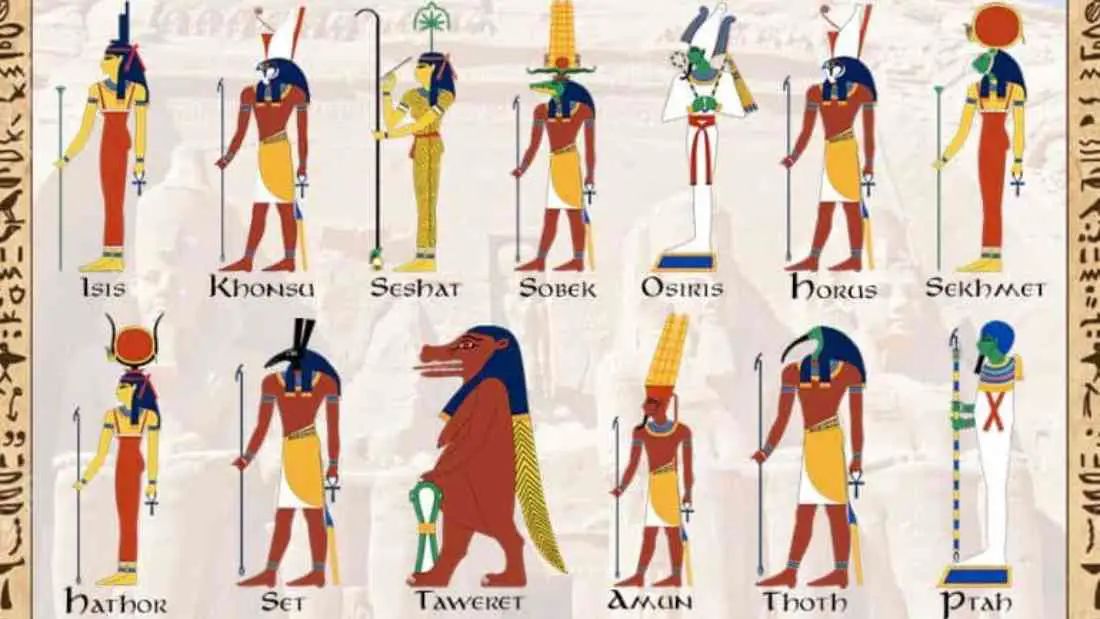Ancient Egypt, a civilization spanning over three millennia, was known for its rich culture, which was deeply rooted in its religious beliefs. The pantheon of ancient Egyptian gods and goddesses, an assembly of more than 2,000 divine entities, was at the heart of this culture. Each god and goddess had unique attributes and realms, etching their significance into various aspects of life.
While names like Isis, Osiris, Horus, Amun, Ra, Hathor, Bastet, Thoth, Anubis, and Ptah echo through history and are widely recognized, numerous lesser-known deities were also integral to the intricate religious landscape, each holding significant roles.
The essence of ancient Egyptian culture was deeply intertwined with their belief and reverence for diverse array of gods and goddesses.
Each deity played a pivotal part in the perpetual journey of every individual’s life and afterlife. Their beliefs, rituals, and everyday practices were imbued with a profound reverence for these divine beings, underscoring the indelible influence of religion on their civilization.
Now, let’s delve deeper into the realm of the most revered gods and goddesses who held a sacred place in the heart of ancient Egyptian society.
Index – Ancient Egyptian Gods and Goddesses in Alphabetical Order
Aken – Custodian of the Boat in the Afterlife
Aker – The Guardian of the Afterlife
Amentet – The Welcoming Goddess of the Afterlife
Amun (Amun-Ra) – The God of the Sun and Air
Amunet – The Goddess of Hidden and Unseen Forces
Amunhotep, Son of Hapu – The Deified God of Healing and Wisdom
Anat – The Canaanite Goddess of Fertility, Sexuality, Love, and War
Anhur – The God of War and Hunting
Anti – The Hawk God of Upper Egypt and His Association with Anat
Anubis – God of Embalming and the Dead
Apep (Apophis) – The Celestial Serpent and Nemesis of Ra
Apis – The Divine Bull and Incarnation of Ptah
Arensnuphis – The Nubian Companion of Isis
Asclepius (Aesculapius) – The Greek God of Healing
Ash (As) – The Oasis Provider in the Libyan Desert
Astarte – Phoenician Goddess of Fertility and Sexuality
Atum – The Aged Incarnation of Ra and the God of Completion
Ba’al – The Storm God from Phoenicia
Babi – The Baboon God of Virility
Bastet – The Lioness Goddess of Ancient Egypt
Bennu – The Divine Bird of Creation
Bes – The Dwarf God of Childbirth, Fertility, and War
Beset – The Female Counterpart of Bes
Hardedef – The Deified Son of King Khufu and Author of ‘Instruction in Wisdom’
Hathor – Goddess of Love, Joy and Motherhood
Hauhet – The Goddess of Infinity
Hedetet – The Scorpion Goddess
Heka – The God of Magic and Medicine
Hraf-Hef – The Divine Ferryman
Ihy – The God of Music and Joy
Imhotep – The Polymath Vizier and Deified God of Wisdom and Medicine
Isis – Goddess of Magic and Healing
Kabechet – The Celestial Serpent and Funerary Deity
Keket – The Goddess of Darkness
Khepri – The Reborn Version of Ra and Scarab Beetle God of Creation and Rebirth
Khonsu – The Traveler and God of the Moon
Ma’at – The Goddess of Truth, Justice, and Harmony
Mehet-Weret – The Celestial Cow Goddess
Meskhenet – The Goddess of Childbirth
Naunet – The Goddess of the Primordial Waters
Nebethetepet – The Hand of Atum
Nefertum – The God of Perfume and Sweet Aromas
Nehebkau – The Protector of Souls
Nun – The God of the Primordial Waters
Osiris – God of the Underworld
Pakhet – The Lioness Hunting Goddess
Ptah – The Creative God of Ancient Egypt
Qudshu – The Syrian Goddess of Love
Serket – The Protective and Funerary Goddess
Sobek – Guardian of Pharaohs and Protector of the Nile and Fertility
Thoth – The Enlightened God of Wisdom, Writing, and Knowledge
Ra – The Majestic Sun God
Ra, the resplendent deity who ruled the sky, sun, and universe, holds a position of unparalleled honor and reverence in the pantheon of ancient Egyptian gods.
As a god of immeasurable influence and power, he was intrinsically linked with the sun, creation, and the divine right of kingship.
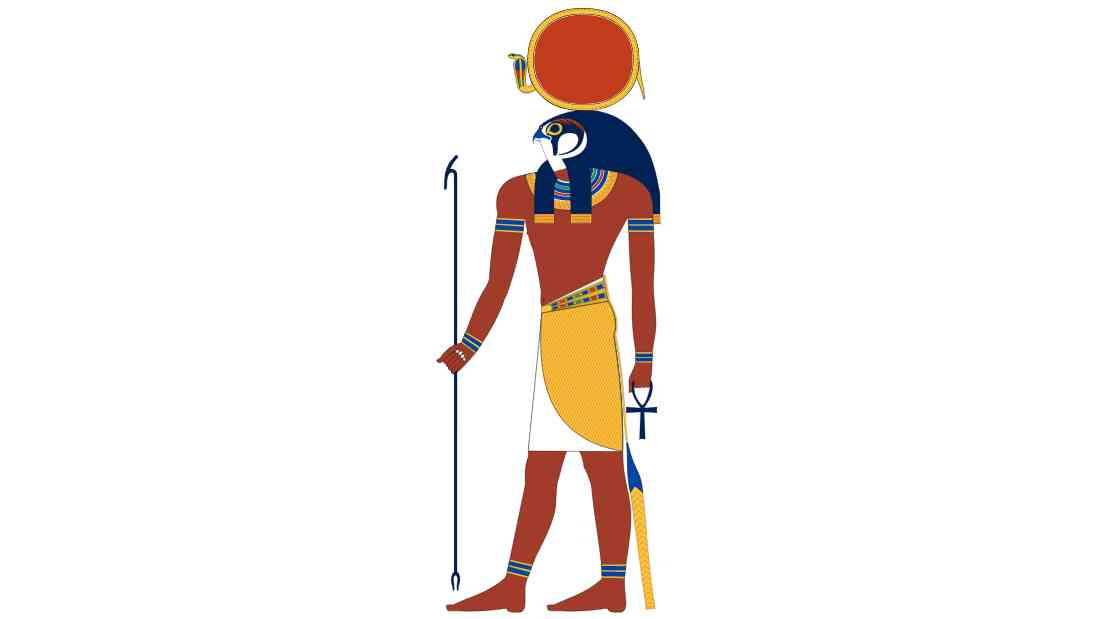
Depictions of Ra often feature him as a hawk-headed figure, a form chosen to signify his far-reaching vision and swift justice.
Above his head, a radiant sun disk, an emblem of his solar dominion, would invariably shine, casting its divine light on his subjects.
This iconography, while visually stunning, is more than mere artistic representation. It is a symbolic narrative of Ra’s omnipresence and his role as the supreme life-giver.
Ra’s daily journey across the sky, from dawn to dusk, was perceived as not only a physical phenomenon but also a spiritual one. It was seen as a continuous cycle of life, death, and rebirth, a timeless ritual that echoed the natural world’s own cyclical rhythms.
Each morning, Ra was believed to be reborn, emerging from the underworld in the form of Khepri, the scarab beetle god.
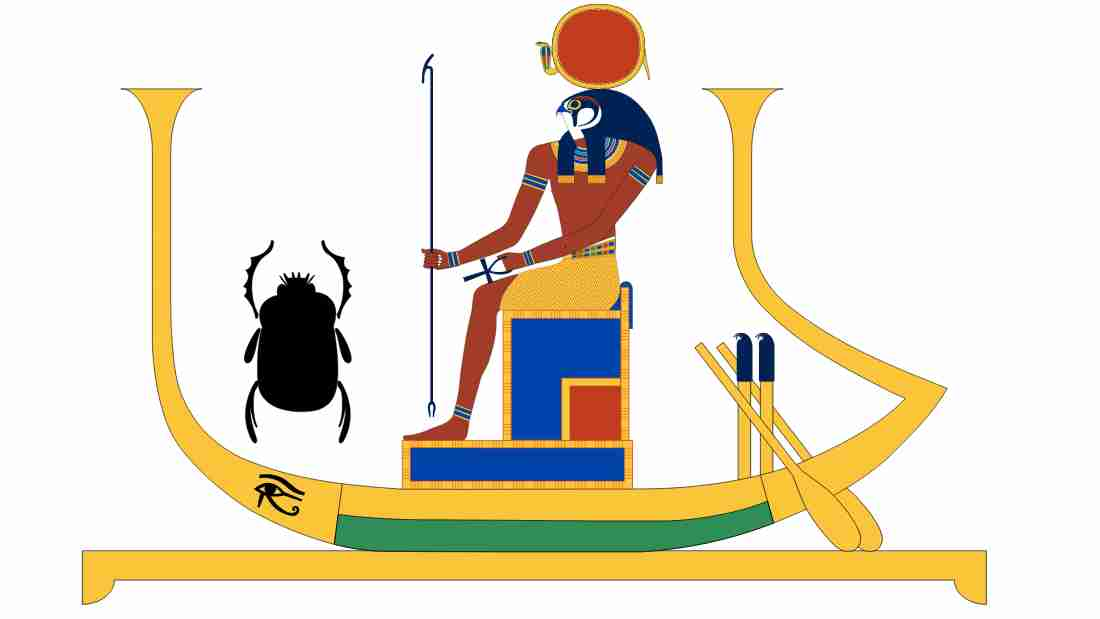
As he traversed the sky, he aged, embodying his noon form, ‘Ra at his zenith.’
By evening, he transformed into Atum, the aged version of himself, only to die and journey through the underworld, marking the cycle’s completion.
Moreover, Ra’s connection with creation is deeply rooted in ancient Egyptian cosmology.
He was believed to have emerged from the primordial waters of Nun, bringing forth the universe by speaking the names of all things. This act established Ra as a divine utterance’s embodiment, a cosmic force that wove the very fabric of existence.
The Pharaohs, seen as earthly embodiments of Ra, held their authority in his name. The concept of kingship was intrinsically tied to Ra, further reinforcing his central role in the social and religious constructs of ancient Egypt.
In this way, Ra, the majestic sun god, was more than a deity. He was a symbol of the unyielding power of the sun, the cyclical nature of life, and the divine authority of the pharaohs.
His influence permeated every aspect of ancient Egyptian life, making him one of the most significant figures in their rich mythological tapestry.
Khepri – The Reborn Version of Ra and Scarab Beetle God of Creation and Rebirth
Khepri, the god often depicted as a scarab beetle or a man with a beetle head, symbolizes creation, rebirth, and the sun’s daily journey, embodying the transformative powers of life and the cyclical nature of existence.
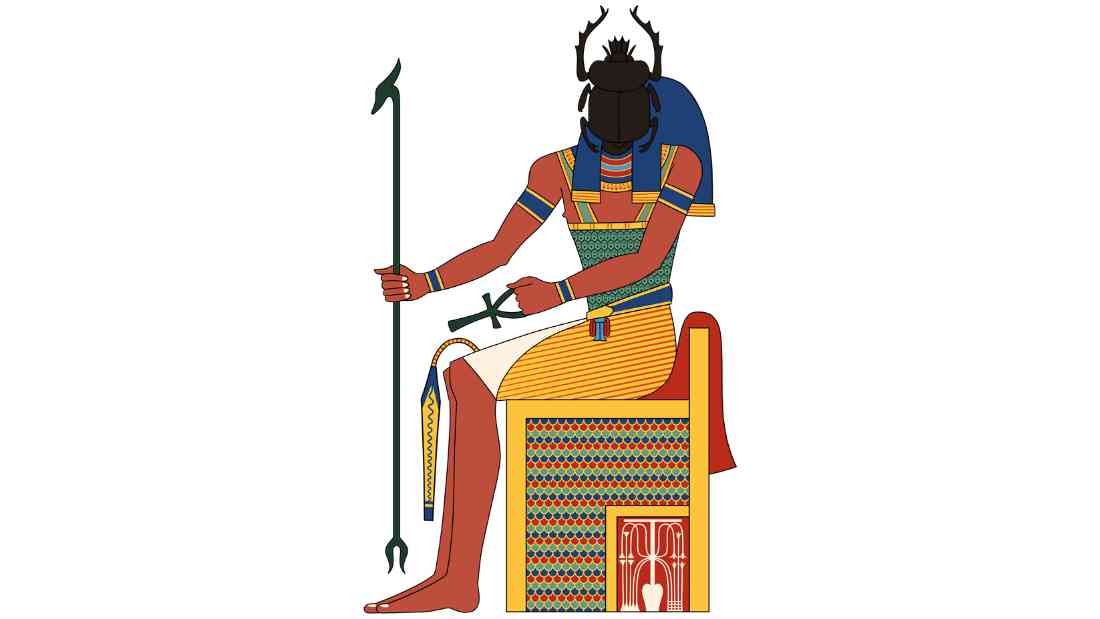
The scarab beetle, the creature that represents Khepri, holds a profound symbolic meaning in the pantheon of ancient Egyptian gods. It is associated with the cycle of life, death, and rebirth due to its behavior of rolling balls of dung across the earth, which it later uses as a food source and breeding ground.
This action mirrors the sun’s daily journey across the sky, leading to the association of Khepri with the rising sun and the creation of life.
As the god of creation, Khepri is believed to have formed the world and all its creatures.
In some mythological narratives, he is said to renew the sun every day before rolling it above the horizon, then carrying it through the other world after sunset, only to renew it once again the next day.
This daily cycle of birth, death, and rebirth underscores his role as a deity of transformation and renewal.
Khepri’s influence also extends to the realm of human life, where he is seen as a protector and guide for the souls journeying through the afterlife. His image was frequently used in funerary art and amulets, providing comfort and guidance to those crossing into the afterlife.

Moreover, Khepri’s representation as a scarab beetle is also linked to the concept of resurrection. Just as the beetle emerges from its ball of dung, so too do the ancient Egyptians believe in the possibility of life emerging from death, further emphasizing Khepri’s role as the god of rebirth.
Hence Khepri embodies the miraculous cycle of life, death, and rebirth. His representation as a humble yet industrious insect that plays a crucial role in maintaining the balance of nature serves as a potent symbol of the transformative and cyclical powers of life.
Atum – The Aged Incarnation of Ra and the God of Completion
Atum, the aged version of the sun god Ra, is the god of completion and the setting sun.
He embodies the concept of endings, transitions, and the cyclical nature of time.
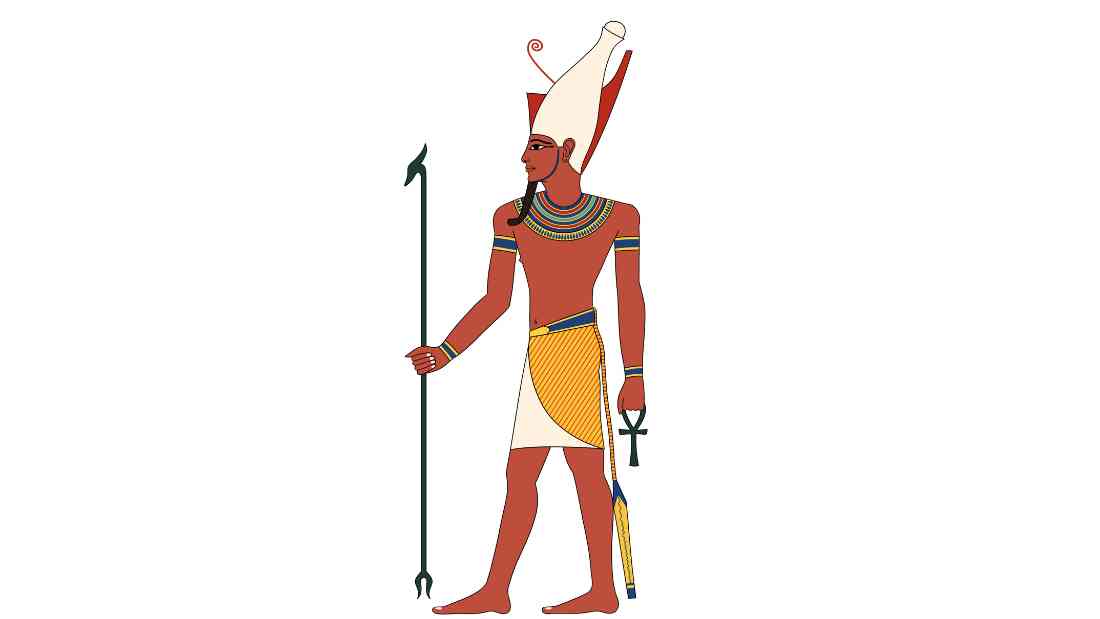
The name Atum comes from the term ‘tem’ which means ‘to complete’ or ‘to finish’ in ancient Egyptian. This etymology reflects his association with the end of the day when the sun sets and the world transitions into night.
While Ra represents the sun at its zenith, full of life-giving energy and warmth, Atum symbolizes the sun as it descends below the horizon, marking the end of the day and the beginning of the night.
Atum’s role as the aged version of Ra further underscores his connection with the cycle of time. He is often depicted as an old man or a man with the head of a lion, signifying his wisdom and strength even in old age.
In this form, he represents the later stages of life and the transition into the afterlife, symbolizing the completion of one’s earthly journey.
As the god of completion in the pantheon of ancient Egyptian gods, Atum also plays a crucial role in creation myths.
According to Egyptian narratives, Atum was the first god to exist, emerging from the primordial waters of Nun. From him, all other gods and all of creation sprang forth.
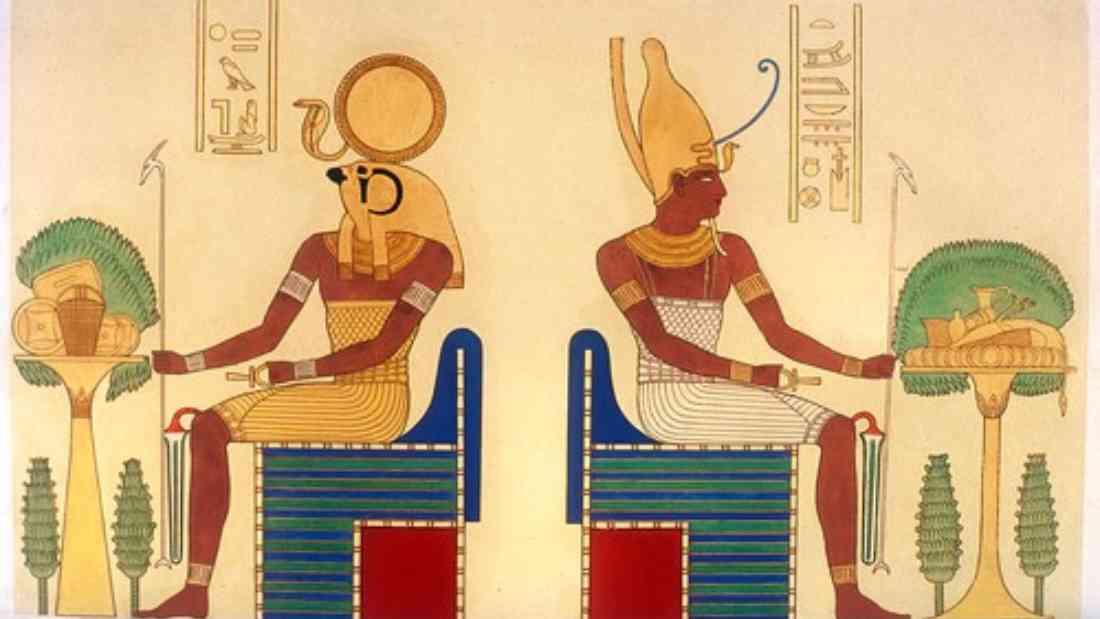
Thus, he represents both the beginning and the end, the alpha and omega of existence.
Moreover, Atum’s association with the setting sun also links him to concepts of regeneration and rebirth. Just as the sun sets to rise again, so too does Atum embody the promise of new beginnings following endings, reinforcing the cyclical nature of life and time.
Nebethetepet – The Hand of Atum
Nebethetepet personifies the hand of Atum, the creator god who brought the universe into existence according to Heliopolitan cosmology. She was worshipped primarily at Heliopolis, one of the oldest cities of ancient Egypt.
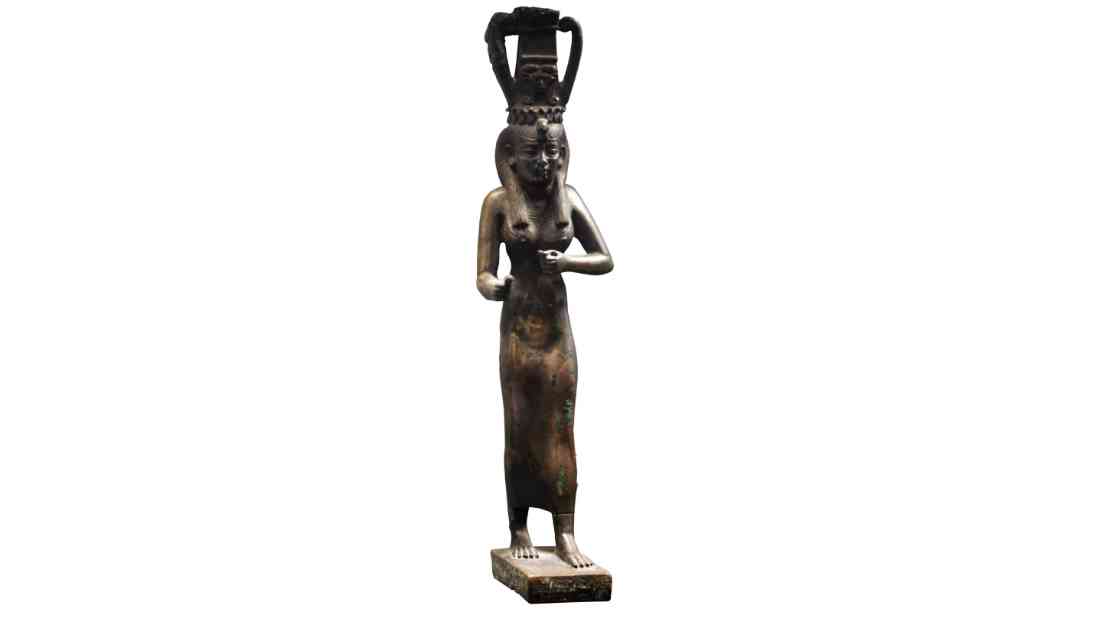
In this unique role, Nebethetepet represents the active, feminine principle of Atum.
In many ancient cultures, including Egypt, hands symbolize creation, action, and purpose.
As such, Nebethetepet”s association with the hand of Atum underscores her role in the act of creation.
Despite being a lesser-known figure compared to other ancient Egyptian gods and goddesses, Nebethetepet played a crucial part in the ancient Egyptian understanding of the cosmos.
Her existence is a testament to the balance that the ancient Egyptians saw in the universe – a balance between male and female, action and stillness, creation and destruction.
Moreover, Nebethetepet’s association with Atum highlights the complexity and intricacy of ancient Egyptian religious beliefs. The Egyptians often viewed their gods as having multiple aspects, each represented by different deities. Nebethetepet, as the personification of Atum’s hand, is a prime example of this multifaceted approach to divine entities.
Nefertum – The God of Perfume and Sweet Aromas
Nefertum, also known as Nefertem, is the god of perfume and sweet aromas, embodying the allure and transformative power of scent.
His story begins at the dawn of creation, emerging from the bud of the blue lotus flower, a symbol of the sun, rebirth, and regeneration in ancient Egyptian culture.
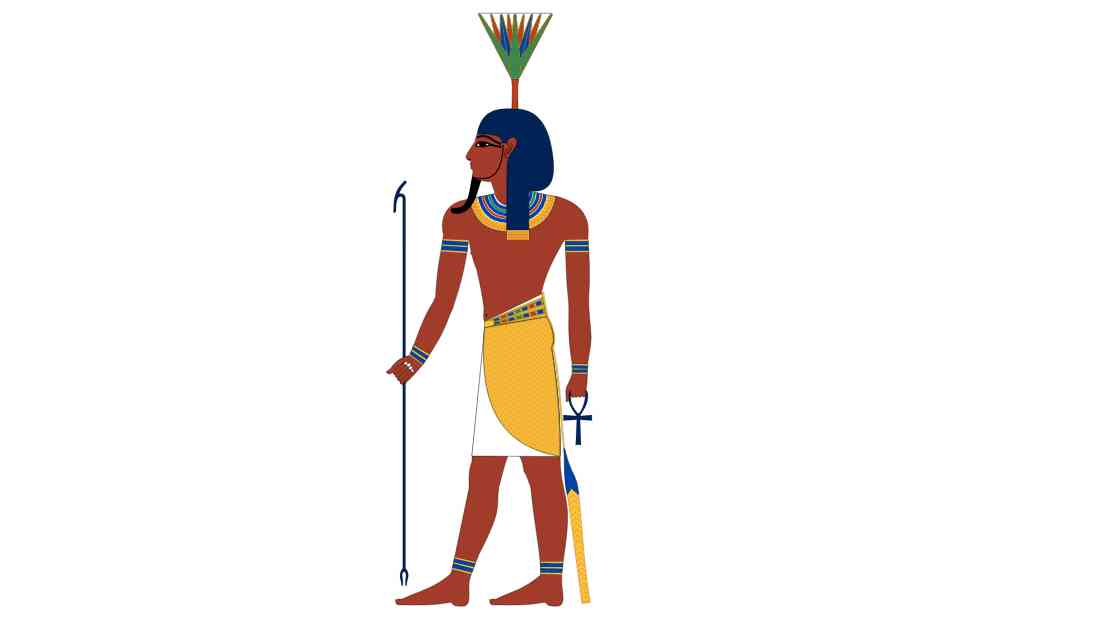
Originally, Nefertum was considered an aspect of Atum, the creator god in Heliopolitan cosmology. His name, which translates to “Beautiful Atum,” reflects this early connection.
However, over time, Nefertum evolved into a distinct deity in his own right, becoming closely associated with sweet-smelling flowers.
Beyond his association with pleasant fragrances, Nefertum also embodies concepts of rebirth and transformation.
His link to the sun god and flowers symbolizes renewal and change, mirroring the daily journey of the sun and the cyclical blooming of flowers.
This association made Nefertum an important figure in ancient Egyptian rituals related to rebirth and rejuvenation.

In the realm of Egyptian medicine, Nefertum’s role extended to healing and disease prevention.
He was often invoked for his healing aromas, which were believed to cure diseases and restore health.
Incense, a common offering in ancient Egyptian religious practices, was also closely associated with Nefertum due to its fragrant smoke.
Bennu – The Divine Bird of Creation
Bennu, also known as the Bennu Bird, is an avian deity associated with creation, rebirth, and renewal. Visually, it was often depicted as a heron or a similar type of bird, with a two-feathered crest on its head.
This image became a potent symbol of rebirth and regeneration, which was used extensively in ancient Egyptian art and iconography.
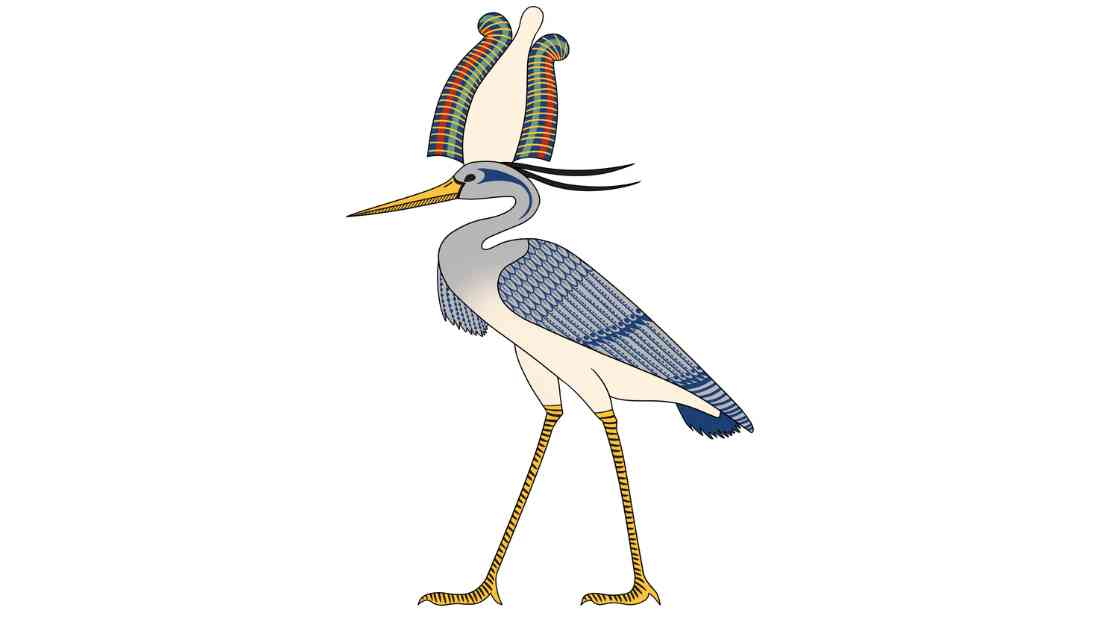
The Bennu Bird’s association with creation originates from its link to Atum, the sun god and the creator deity in Heliopolitan cosmology.
According to one creation myth, the Bennu Bird flew over the waters of Nun, the primordial chaos, before the world was created. Its cry broke the silence, marking the beginning of time and the creation of the world.
The Bennu Bird was also closely associated with Ra, the sun god. It was believed to have created itself from a fire that burned on a holy tree in one of Ra’s sacred precincts. This self-creation resonates with the qualities of the sun, which ‘dies’ every night and ‘rebirths’ every morning, further reinforcing Bennu’s connection with renewal and rebirth.
Moreover, Bennu was also linked with Osiris, the god of the dead and resurrection. In this context, Bennu symbolized the promise of eternal life in the afterlife.

Representations of the Bennu Bird were often found in tombs and burial sites, providing the deceased with the assurance of rebirth and immortality.
The Bennu Bird inspired the concept of the Phoenix in Greek mythology, a bird that cyclically regenerates and symbolizes rebirth and renewal.
Apep (Apophis) – The Celestial Serpent and Nemesis of Ra
Apep, also known as Apophis, is a formidable figure in ancient Egyptian mythology.
As a celestial serpent, Apep represents the antithesis of order and light, embodying chaos and darkness. His primary role in the mythological narrative involves his nightly assault on the sun barge of Ra, the sun god.
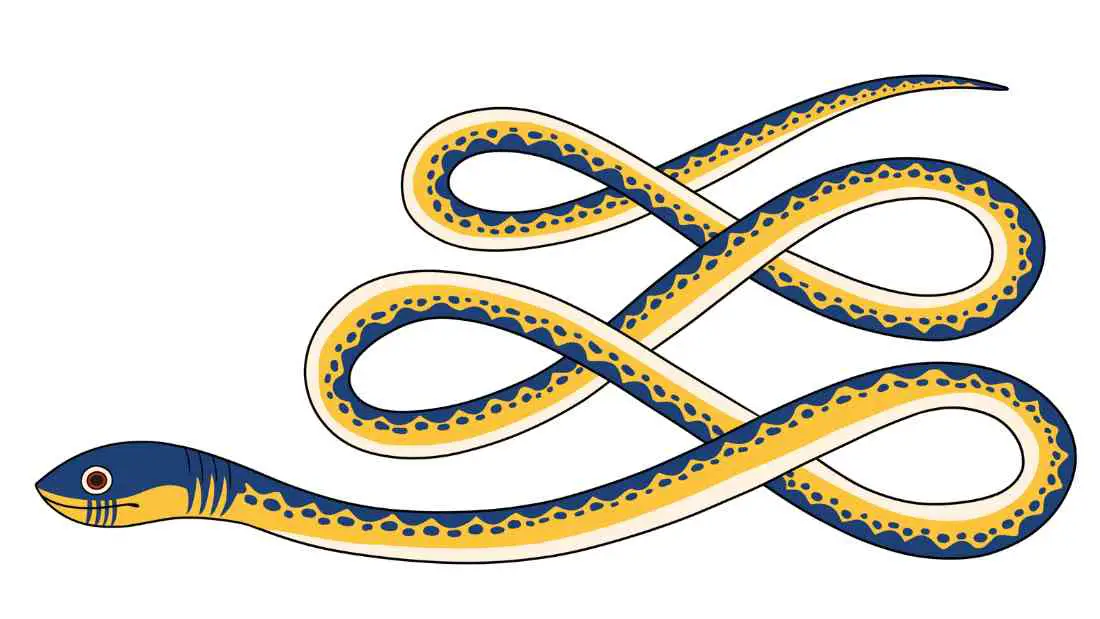
Ra’s sun barge, representing the sun’s journey across the sky, moves through the underworld each night, symbolizing the transition from day to night.
This journey isn’t peaceful; it’s fraught with danger, primarily due to Apep’s relentless attacks. The celestial serpent’s aim is to disrupt the cycle of day and night, thereby plunging the world into eternal darkness.
This epic battle between Apep and Ra is more than just a struggle between two powerful deities. It symbolizes the eternal conflict between order and chaos, light and darkness, good and evil.

In this cosmic drama, Ra stands for order and stability, while Apep embodies the forces that seek to disrupt this harmony.
During their epic battles, the sun god is aided by other gods and the justified dead – those souls deemed worthy in the afterlife. These allies help fend off Apep, ensuring the sun’s journey continues and dawn arrives as it should.
Isis – Goddess of Magic and Healing
Isis, an eminent deity in the ancient Egyptian pantheon, was a multifaceted goddess embodying fertility, magic, healing, and motherhood.
Revered for her benevolence and caring nature, she was a beacon of hope and comfort to her followers, offering spiritual succour and protection through her magical prowess.
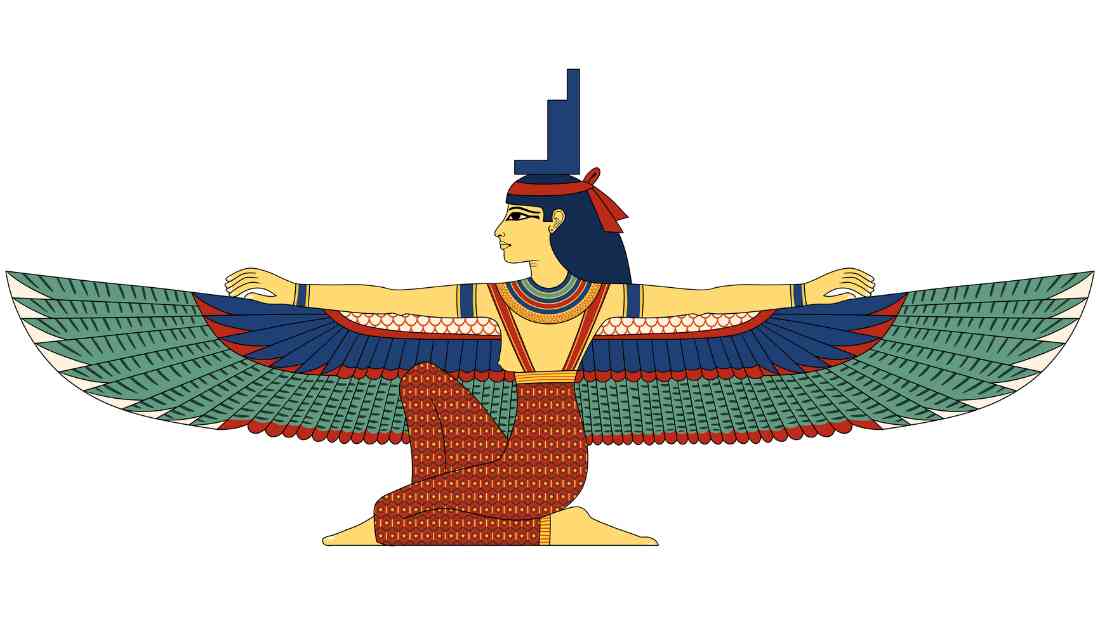
As the goddess of magic, Isis was believed to possess immeasurable knowledge of mystical arts. She was said to have used her enchanting abilities to aid humans, offering them relief from ailments, protection from evil forces, and guidance in times of uncertainty.
Her magic was deeply intertwined with her role as a healer, and she was often invoked in rituals aimed at curing diseases or warding off misfortune.
Isis was also hailed as the quintessential mother goddess, a symbol of fertility and the sanctity of maternal bonds.
She was revered as the divine protector of children and women, particularly during childbirth. Her nurturing aura extended to agriculture, where she was associated with the fertile lands nurtured by the Nile’s annual flooding.
This goddess of many talents was easily recognizable by her iconic throne-shaped headdress, a symbol of her power and status.
The throne motif was more than just a royal emblem. It symbolized Isis’s role as the provider of kings and her influence in the earthly realm’s governance.

Integral to Isis’s mythological narrative is her relationship with Osiris, her husband, and Horus, her son.
As the wife of Osiris, the god of the underworld, Isis demonstrated her unwavering loyalty and love by seeking his body after his brother Set murdered him.
Using her potent magic, she resurrected Osiris long enough to conceive their son, Horus. This act further cemented her association with rebirth and regeneration.
As the mother of Horus, the sky god and the divine representation of the pharaohs, Isis played a crucial role in royal succession’s divine validation.
She was seen as the nurturer of divine kingship, further amplifying her importance in the socio-religious fabric of ancient Egypt.
Arensnuphis – The Nubian Companion of Isis
Arensnuphis is known primarily as a companion to the goddess Isis. His origins trace back to Nubia, a region along the Nile river, which is located in what is now southern Egypt and northern Sudan.
This Nubian connection adds a layer of cultural richness to Arensnuphis’s character and role within the mythological narrative.
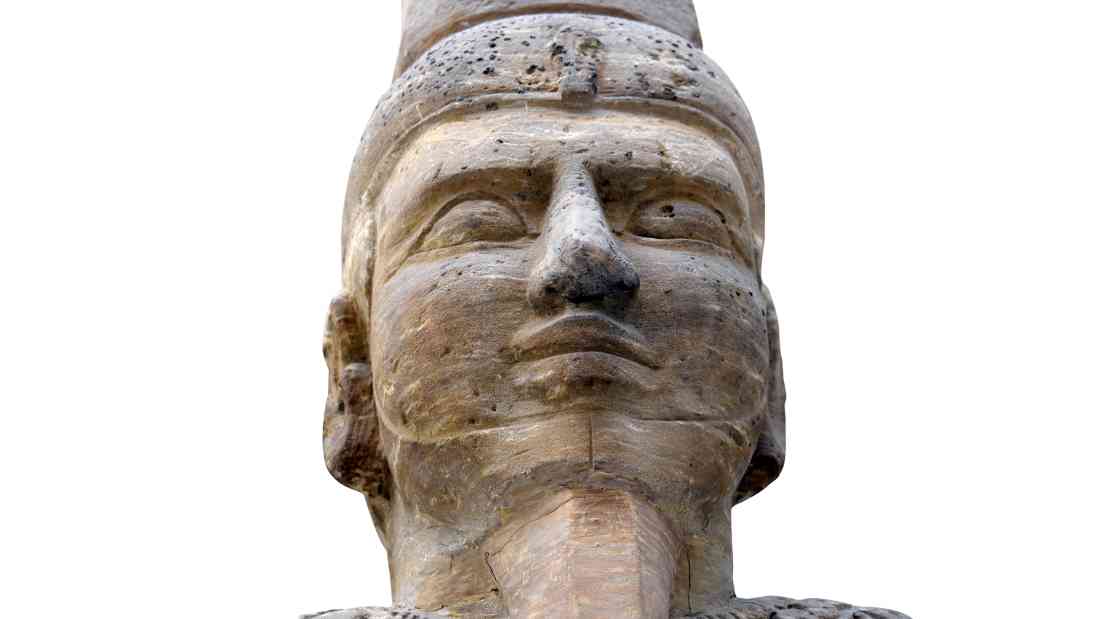
Isis, one of the most important and widely worshipped deities in ancient Egypt, is associated with motherhood, magic, and healing.
As her companion, Arensnuphis shares in her divine duties and responsibilities.
Together, they form a powerful pair, embodying a range of qualities and attributes revered by the ancient Egyptians.
Arensnuphis was worshipped primarily at Philae, a sacred site dedicated to Isis.
This island in the Nile was home to a magnificent temple complex where rituals and ceremonies honoring Isis and her companion were regularly performed.
Here, Arensnuphis was venerated alongside Isis, reinforcing his importance within the pantheon of ancient Egyptian gods.
Depictions of Arensnuphis vary, reflecting the multifaceted nature of his persona.
He is often portrayed as a lion, a symbol of power and protection in Egyptian iconography.
Alternatively, he may be depicted as a man wearing a feathered headdress, an emblem of divinity and authority. These visual representations underscore Arensnuphis’s divine status and his close association with Isis.
Osiris – God of the Underworld
Osiris, the enigmatic god presiding over the underworld is a central figure within the intricate tapestry of ancient Egyptian gods.
Depicted as a green-skinned man wrapped in mummy bandages, Osiris was a visual testament to the concepts of renewal and regeneration.
The green hue of his skin was not an arbitrary choice. It symbolized vitality and the verdant bounty of the earth, mirroring the fertile lands left behind by the receding Nile floods.
This iconography underscored Osiris’s strong connection to the natural world and its cyclical patterns of death and rebirth.

Beyond his underworld dominion, Osiris was also deeply intertwined with the annual Nile flood.
The Egyptians saw these floods, which enriched the soil and ensured bountiful harvests, as a manifestation of Osiris’s benevolence.
The inundation was seen as a divine act of rejuvenation, echoing Osiris’s own narrative of death and resurrection.
Osiris’s mythological narrative is incomplete without mentioning his relationship with Isis, his devoted wife, and Horus, his posthumous son.

Osiris’s murder by his brother Set and subsequent resurrection by Isis is one of ancient Egyptian mythology’s most enduring tales. It not only cements Osiris’s association with resurrection but also underlines the themes of loyalty, betrayal, and familial bonds that are woven into the pantheon’s mythology.
Aker – The Guardian of the Afterlife
Aker is the guardian of the eastern and western horizons of the afterlife.
He played a pivotal role in the protection of the sun barge of Ra, the sun god, as it ventured into and emerged from the underworld at dawn and dusk.
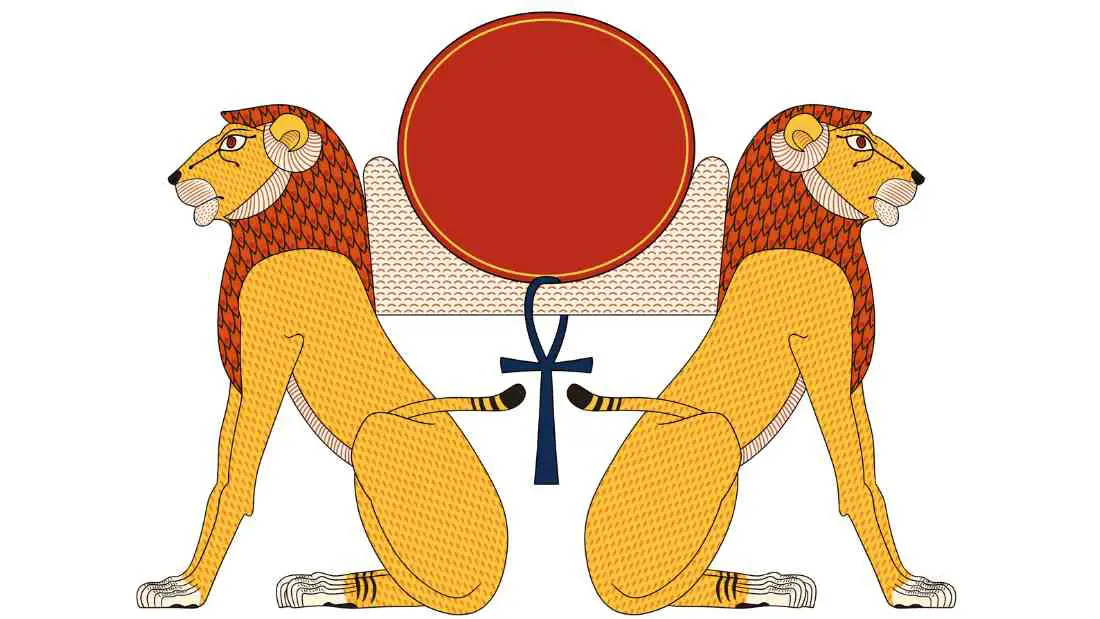
The name ‘Aker’ translates to ‘Earth,’ indicating his association with the terrestrial realm and its horizons.
Aker was often depicted as two lions sitting back-to-back, one representing yesterday (the west) and the other tomorrow (the east). This imagery symbolized Aker’s domain over the past and the future, and his role as the threshold between the realms of the living and the dead.
In ancient Egyptian cosmology, the journey of the sun god Ra across the sky was not just a daily event, but a cyclical narrative of death and rebirth.
As the sun set in the west, it was believed to descend into the underworld, marking Ra’s death. At dawn, when the sun rose in the east, Ra was reborn, signaling a new day.
Aker’s role was crucial in this process.

As the guardian of the horizons, he protected Ra’s sun barge from the dangers of the underworld as it entered at dusk and re-emerged at dawn.
Despite the perils present in the underworld, including the chaotic serpent Apophis, Aker ensured the sun’s safe passage, enabling the cycle of day and night to continue uninterrupted.
Aker’s protective function extended to the deceased as well.
Ancient Egyptians believed that the souls of the dead had to traverse the underworld to reach the afterlife. As the guardian of the horizons, Aker would protect these souls during their journey, much like he did for Ra.
Aken – Custodian of the Boat in the Afterlife
Aken, an important but often overlooked figure in ancient Egyptian mythology, is the guardian of the boat that carries souls across Lily Lake, also known as the Winding Waterway, to the Field of Reeds, the ultimate destination in the afterlife.
The name ‘Aken’ translates to ‘He Who is Effective,’ a fitting title for a deity who played such a crucial part in the spiritual journey of the deceased.
His role in the pantheon of ancient Egyptian gods was not merely that of a ferryman, but as a custodian, ensuring safe passage across the treacherous waters of the underworld.
Lily Lake, a central feature in ancient Egyptian cosmology, represented the hazardous journey that souls had to undertake after death. It was filled with dangerous creatures and obstacles. However, under Aken’s watchful guidance, the souls could traverse this challenging path to reach the Field of Reeds.

The Field of Reeds, also known as Aaru, was a heavenly paradise where souls could live an eternal life of peace and contentment, mirroring their earthly existence but without hardships or suffering. It was a place of abundance, filled with lush fields, magnificent buildings, and bountiful food and drink.
Aken is typically depicted as a man lying on his stomach atop a sarcophagus, symbolizing his connection with death and the afterlife. In other representations, he is shown standing on a boat, reinforcing his role as the divine ferryman. His image served as a comforting presence, assuring the ancient Egyptians of a secure passage to the afterlife.
Despite not being as widely venerated as some other Egyptian deities, Aken held a significant place in the pantheon due to his critical role in the soul’s journey after death.
His duty as the custodian of the boat to the Field of Reeds underscores the ancient Egyptians’ complex beliefs about death and the afterlife, portraying death not as an end, but as a transition to a new beginning.

Hraf-Hef – The Divine Ferryman
Hraf-Hef, a distinctive figure in ancient Egyptian mythology, is recognized as the surly divine ferryman responsible for transporting souls across the underworld’s perilous waters.
Unlike Aken, the custodian of the boat, Hraf-Hef is depicted as somewhat gruff and ill-tempered, yet his role in the spiritual journey of the deceased was just as vital.
The name ‘Hraf-Hef’ translates roughly to ‘He Who Looks Behind Himself,’ suggesting a cautious and wary nature, fitting for a deity charged with such a daunting task.
Despite his surly demeanor, Hraf-Hef was entrusted with ensuring the safe passage of souls through the challenging landscapes of the underworld to their final resting place.
In ancient Egyptian cosmology, the journey after death was fraught with danger and uncertainty. It was believed that the soul had to cross treacherous waters teeming with hostile creatures and navigate numerous obstacles before reaching the afterlife.
Hraf-Hef, with his stern demeanor and watchful eyes, was seen as the ideal guardian for this hazardous voyage.
Hraf-Hef is typically depicted as a man with a sour expression, often shown standing on a boat, reinforcing his role as the divine ferryman. This representation served not only as a symbol of his pivotal function in the afterlife journey but also as a reminder of the hardships and challenges that awaited the soul after death.
Despite his gruff exterior, Hraf-Hef was respected and revered for his crucial role in the journey to the afterlife. His stern countenance underscored the seriousness of the voyage, reminding the ancient Egyptians of the challenges that lay ahead in the afterlife.
Amentet – The Welcoming Goddess of the Afterlife
Amentet is the goddess who welcomed the deceased to the afterlife.
Known as “She of the West,” in reference to the setting sun and the journey of the dead, Amentet was the consort of the Divine Ferryman and resided near the gates of the underworld.
Amentet’s name translates to ‘The Westerner,’ further emphasizing her association with the afterlife, which was believed to be located in the west where the sun sets.
As a welcoming deity, Amentet greeted the souls of the deceased with food and drink, providing them with sustenance for their journey in the afterlife.

In ancient Egyptian art, Amentet is often depicted bearing a scepter symbolizing authority and an Ankh, the Egyptian symbol of life.
She is frequently shown under a tree, signifying her abode near the gates of the underworld.
This tree, according to some legends, was thought to bear fruit that could grant eternal life, further linking Amentet with notions of immortality and the afterlife.
As the daughter of Hathor, the goddess of love, beauty, and music, and Horus, the god of the sky, Amentet inherited a divine lineage that underscored her significant role in the pantheon of ancient Egyptian gods.
Her relationship with the Divine Ferryman added another layer to her importance, symbolizing the harmonious union between the journey to the afterlife and the welcome that awaited the souls upon their arrival.
Despite the fear associated with death and the afterlife, the presence of Amtenet provided comfort and reassurance to the ancient Egyptians. Her welcoming nature and the sustenance she offered signified a compassionate reception in the afterlife, assuaging fears of the unknown and providing hope for a peaceful existence beyond death.
Kabechet – The Celestial Serpent and Funerary Deity
Kabechet, also known as Kebehwet or Qebhet, is an ancient Egyptian goddess whose mythology comes with a fascinating evolution.
Her origins trace back to the celestial sphere, where she was initially revered as a serpent deity. Over time, her image transformed, and she became more closely associated with funerary rites.
Kabechet is often regarded as the daughter of Anubis – the god of embalming and the dead. This familial connection further solidified her role within the realm of death and afterlife.
Despite her ominous associations, Kabechet is not a deity of darkness or malice. Instead, she represents comfort and purification for the deceased.
One of Kabechet’s most important roles was to provide pure, cool water to the souls of the deceased as they awaited judgment in the Hall of Truth.
This sacred place, also known as the Hall of Two Truths, was where the hearts of the deceased were weighed against the feather of Ma’at, the goddess of truth and justice.
The water provided by Kabechet was not merely for physical thirst. It was symbolic of spiritual cleansing and renewal, preparing the souls for their impending judgment.
This act of kindness amidst such a daunting process painted Kabechet as a compassionate figure, providing solace in a time of uncertainty.
Thus, Kabechet’s evolution from a celestial serpent to a funerary deity reflects the complex dynamics of ancient Egyptian mythology. She is a symbol of the comforting presence that can be found even in the most intimidating aspects of existence – death and the afterlife.
Sobek – Guardian of Pharaohs and Protector of the Nile and Fertility
Sobek, the mighty deity of ancient Egypt, was revered as the Guardian of Pharaohs and Protector of the Nile and Fertility. This formidable god embodied the power and ferocity of a crocodile, symbolizing the Nile’s dangerous yet life-sustaining waters.

Depicted with the head of a crocodile and the body of a human, Sobek commanded respect and awe among the people of Egypt.
He was believed to possess great strength, intelligence, and cunning, qualities that made him an ideal protector against threats to the pharaohs and the rich agricultural lands along the Nile.
As the Guardian of Pharaohs, Sobek was tasked with safeguarding the rulers of Egypt, ensuring their safety and prosperity.
It was believed that he could ward off evil forces, protect against enemies, and grant the pharaohs the strength and guidance they needed to lead their kingdom.
Additionally, Sobek played a vital role in maintaining the fertility and abundance of the Nile.
As the Protector of the Nile and Fertility, he oversaw the river’s annual flooding, which brought nutrient-rich silt to the surrounding farmland, allowing crops to flourish.
The ancient Egyptians saw Sobek as the force that controlled this life-giving cycle and relied on his blessings for bountiful harvests.
Sobek was worshipped throughout Egypt, with temples dedicated to him in various cities, such as Arsinoe and Kom Ombo. Rituals, offerings, and prayers were performed to honor and appease this mighty deity, seeking his favor and protection.
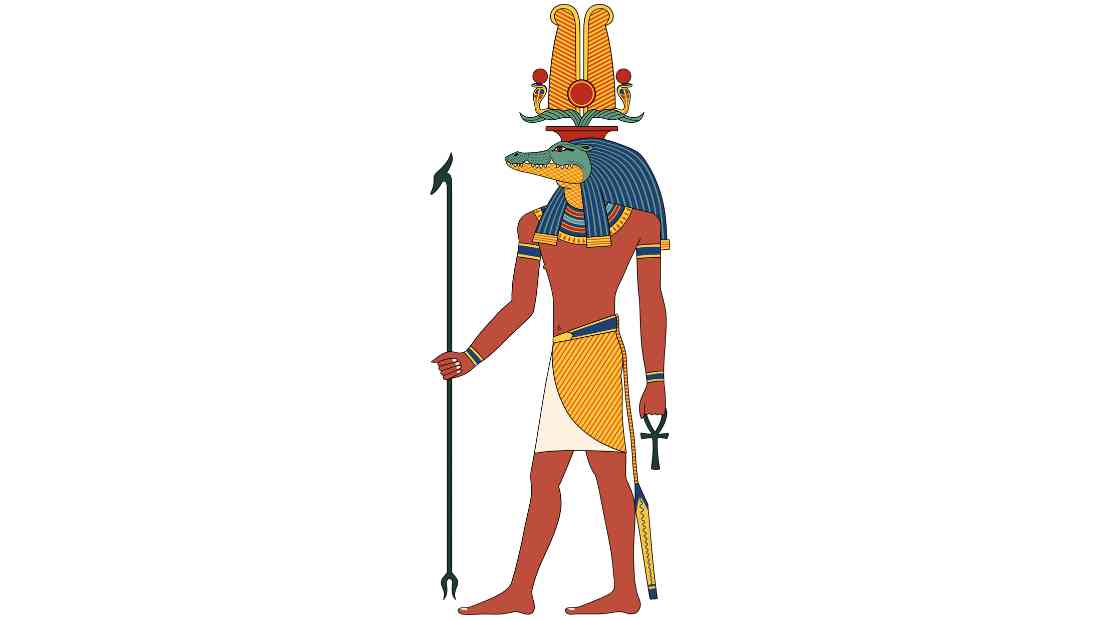
Ma’at – The Goddess of Truth, Justice, and Harmony
Ma’at is one of the most significant deities in ancient Egyptian mythology, embodying truth, justice, and harmony.
Her role extended beyond that of a traditional goddess. She represented the fundamental principle of ma’at, a concept central to the culture and worldview of ancient Egypt.
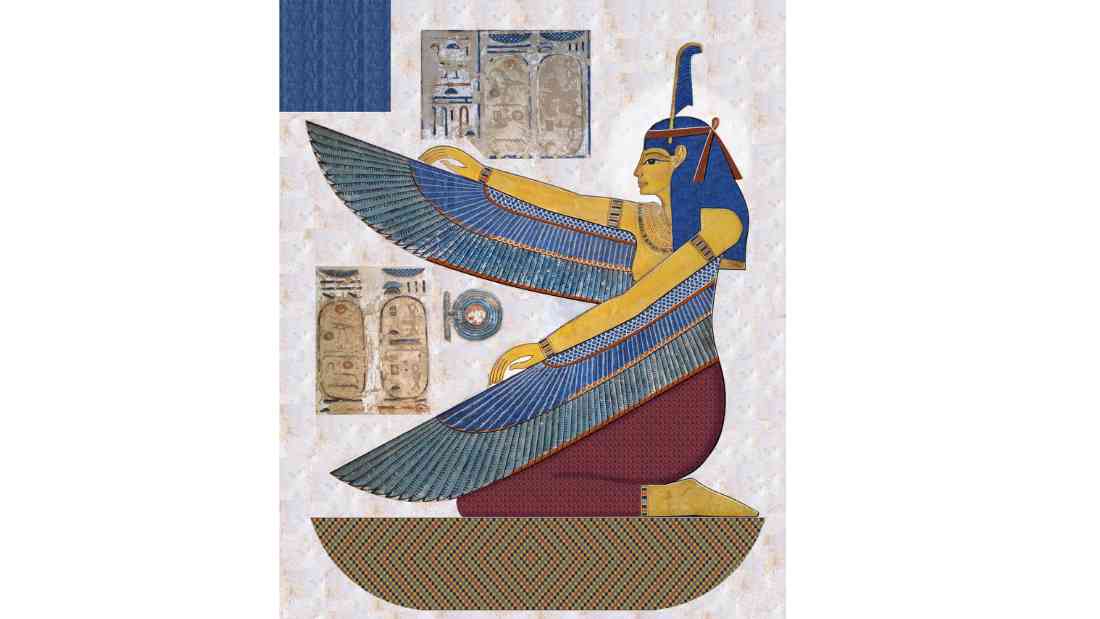
The principle of ma’at encompassed a broad range of meanings, including truth, balance, order, law, morality, and justice.
It signified the harmonious functioning of the universe, the ethical conduct of individuals, and the just operation of society.
As such, Ma’at was not only a goddess but also an embodiment of these essential ideals.
In ancient Egyptian art, Ma’at is often depicted with an ostrich feather on her head, which symbolizes truth. This feather played a crucial role in the judgment of the deceased in the afterlife.
In the Hall of Truth, the hearts of the dead were weighed against Ma’at’s feather. If the heart was lighter or equal in weight to the feather, the soul was granted eternal life. If it was heavier, it was devoured by Ammit, the “Devourer of Souls.”
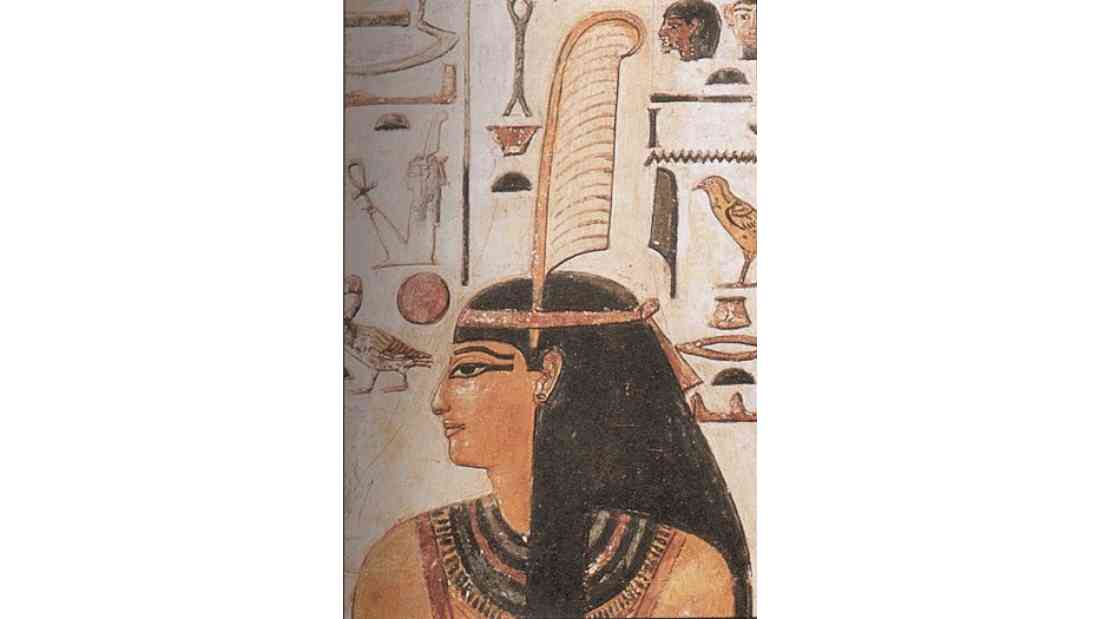
This ritual underscores the significance of living a life of truth and morality in accordance with the principle of ma’at.
Ma’at’s influence extended to the cosmos as well. She was believed to set the stars in the sky and regulate the seasons, ensuring the orderly progression of time and the natural world. This cosmic role further emphasized the principle of ma’at as the foundation of harmony and balance in the universe.
In the pantheon of Egyptian gods, Ma’at held a unique position. She was the daughter of Ra, the sun god, and wife of Thoth, the god of wisdom and writing. Her familial ties linked her directly with the divine forces responsible for the creation and maintenance of the universe.
Ammit – The Devourer of Souls
Ammit, also known as Ammut, is a formidable figure in ancient Egyptian mythology.
Known as the “Devourer of Souls,” she is depicted as a composite creature with the head of a crocodile, the torso of a leopard, and the hindquarters of a hippopotamus.
Each aspect of her form symbolizes different elements of danger and power in the animal kingdom, reflecting her fearsome role in the afterlife.
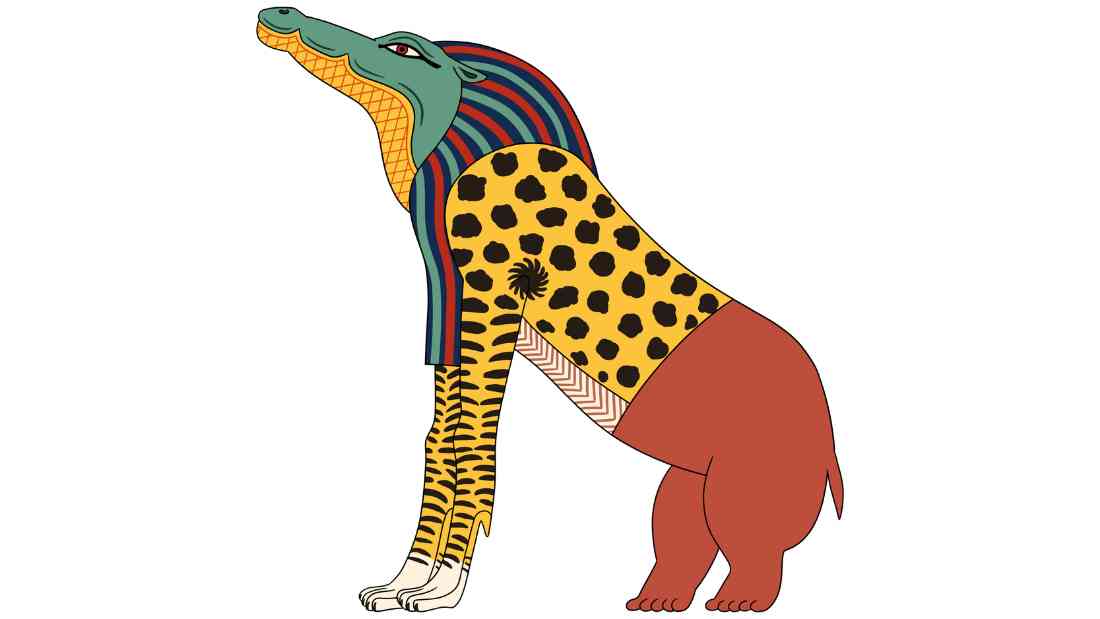
In the Hall of Truth, the judgment place of the afterlife, Ammit sat beneath the scales of justice.
The deceased’s heart, considered the seat of the soul and moral character, was weighed against the feather of Ma’at, the goddess of truth and order.
If the heart was found to be heavier than the feather, indicating that the individual had led a life of sin, Ammit would devour it, resulting in the second death where the soul was denied the chance of an afterlife.
Ammit’s role was not that of a traditional goddess who was worshipped. Instead, she embodied the concept of divine retribution.
The fear of being devoured by Ammit encouraged moral behavior among the living, who aimed to lead virtuous lives to avoid such a fate. Her presence served as a deterrent for immoral actions and was a constant reminder of the consequences of one’s deeds in life.
Despite her terrifying image, Ammit played a crucial role in maintaining Ma’at, the fundamental order of the universe, by punishing those souls deemed unworthy by Osiris, the god of the dead and resurrection.
In this sense, she was not so much a malevolent entity as she was an enforcer of divine justice, integral to the ancient Egyptians’ understanding of morality and the afterlife.
Horus – The Sky God
Horus, the falcon-headed deity who ruled the boundless skies, is a prominent figure within the pantheon of ancient Egyptian gods.
Epitomizing divine kingship and celestial power, Horus served as the protector of the pharaohs and a symbol of rightful rule.
As the son of Isis, the goddess of magic and healing, and Osiris, the god of the underworld, Horus’s lineage alone underscores his significance within the mythological narrative of ancient Egypt.

Often portrayed with the piercing eyes of a falcon, Horus was intrinsically linked to the sky.
His right eye was associated with the sun, representing the solar cycle’s vitality and unyielding energy. In contrast, his left eye was associated with the moon, symbolizing the lunar cycle’s tranquility and the soothing coolness of the night.
This dual symbolism reflected his dominion over both the day and night, underscoring his omnipresence in the celestial realms.
His connection to the sky was further emphasized by his name, which translates to ‘the distant one’ or ‘the one on high,’ reinforcing his status as the sovereign ruler of the heavens.
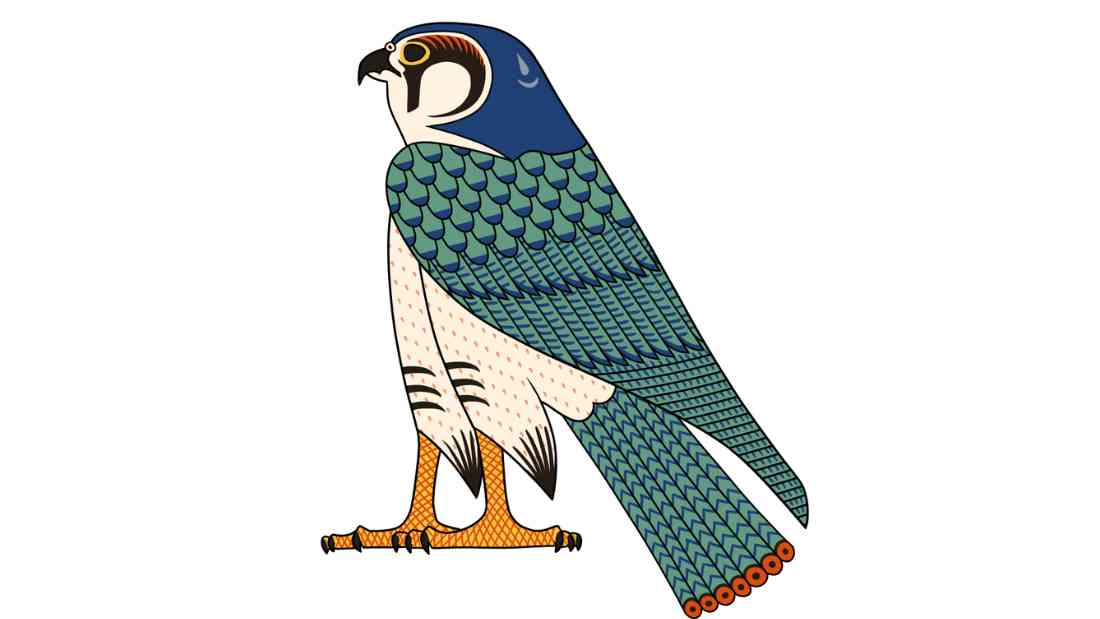
His far-reaching vision, signified by his falcon’s eyes, was believed to keep a watchful eye over the land, ensuring harmony and warding off chaos.
As the protector of the pharaohs, Horus was seen as the divine embodiment of the earthly kings.
The pharaohs were considered the ‘Living Horus,’ a testament to their divine right to rule. This association strengthened the legitimacy of the pharaohs’ reign, linking their authority directly to the gods.
The tale of Horus’s conflict with his uncle Set over the throne of Egypt forms a crucial part of his mythos. This epic battle, which ended in Horus’s victory, symbolized the triumph of order over chaos, further solidifying Horus’s role as a protector deity.
Nehebkau – The Protector of Souls
Nehebkau, also known as “He Who Unites the Ka,” is the protector god. His principal role was to join the ka, an aspect of the soul, to the body at birth and reunite it with the ba, another element of the soul, after death.
This crucial function places Nehebkau at the heart of the Egyptians’ understanding of life, death, and the transition between the two.

Nehebkau is often depicted as a serpent, a symbol associated with both protection and renewal in ancient Egyptian iconography. This depiction reflects his role as a protective deity and his involvement in the cycle of life and death.
Like Heka, the god of magic and medicine, Nehebkau is believed to have always existed, transcending the confines of time and space.
According the Egyptian mythology, he was present in the primordial waters that existed at the dawn of creation. He swam in these chaotic waters before Atum, the creator god, rose from the chaos to impose order.
This association positions Nehebkau at the very beginning of time, further emphasizing his timeless nature and his importance in the divine order of ancient Egyptian gods.
Heka – The God of Magic and Medicine
Heka, in ancient Egyptian mythology, is the god of magic and medicine, embodying the mysterious power that Egyptians believed permeated the universe.
His name itself means “activating the ka,” the aspect of the soul associated with life force. This gives insight into his role as a cosmic force that activates the vital energies within every living being.

Heka was considered a primordial deity who existed before the creation of the world. Unlike other gods who were born or created, Heka simply always was, underlining his fundamental role in the cosmos.
Heka is typically depicted as a man carrying a staff entwined with serpents, symbolizing his authority and connection to magical healing. Sometimes, he is shown with frog-headed attributes, reflecting his association with fertility and regeneration.
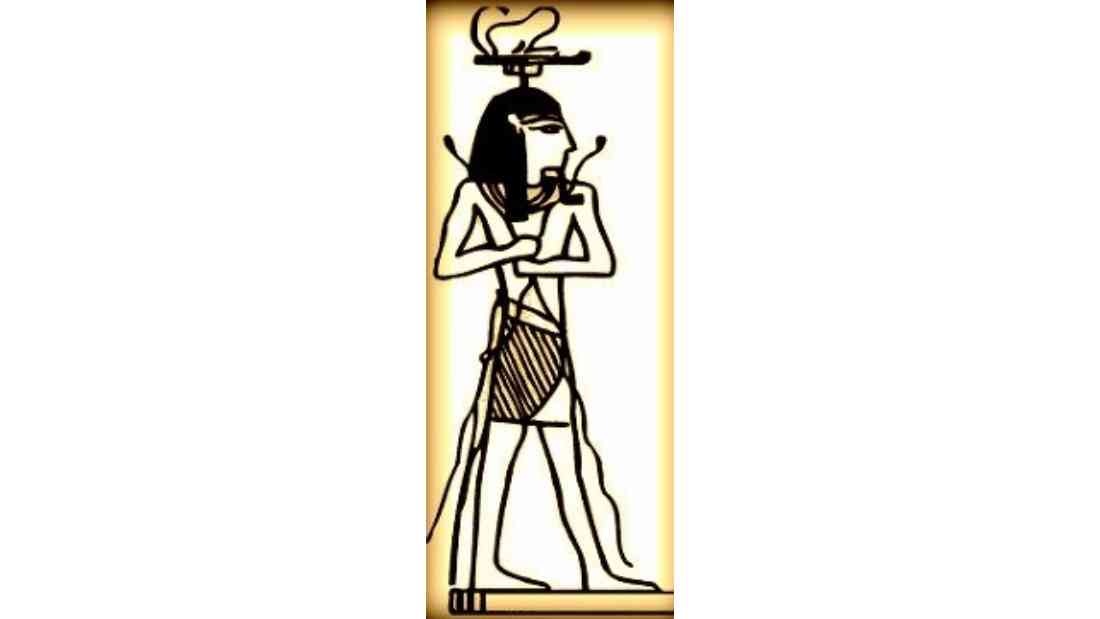
As the god of magic, Heka was the master of a force used by both gods and humans. This magic was not perceived as supernatural, but as a natural force that influenced everyday life. It was used for various purposes, from mundane tasks to grand rituals, and Heka was the source and ultimate controller of this power.
Heka’s association with medicine reflects the ancient Egyptians’ understanding of healing as a magical process. They believed that illnesses were caused by supernatural forces, and healing involved the use of spells, amulets, and potions to drive away these forces.
As the god of magic, Heka was naturally invoked in these healing practices, making him a protector of health.
Pakhet – The Lioness Hunting Goddess
Pakhet was revered as a hunting goddess who took the form of a lioness. Her name, translating to “She Who Scratches” or “Tearer,” aptly captures her fierce and relentless nature as a huntress.
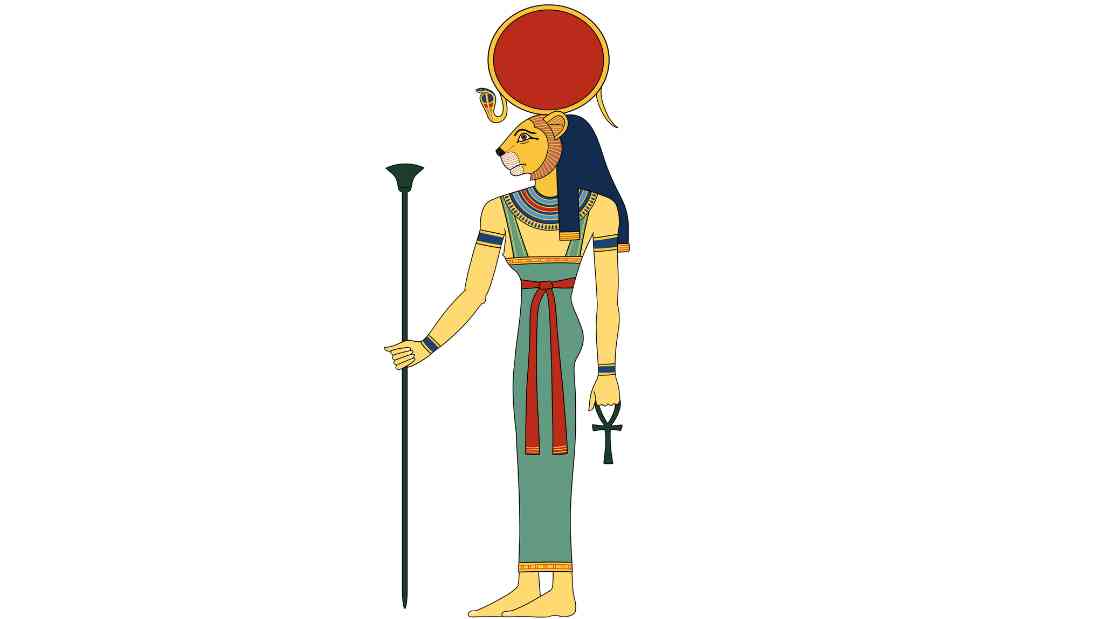
As a consort of Horus, the sky god, Pakhet was integrated into the broader narrative of Egyptian cosmology. Her association with Horus underscored her status as a potent force in the pantheon of ancient Egyptian gods, highlighting her influence and importance.
Pakhet’s attributes were not confined to hunting alone but extended to embody elements of vengeance and justice.
She was associated with the vengeful aspects of Sekhmet, another lioness deity known for her wrath and destructive power. This connection reflected Pakhet’s formidable capabilities and her role as an avenger in the divine realm.
Simultaneously, Pakhet was linked to the justice of Isis, one of the most important goddesses in ancient Egypt. This association positioned Pakhet as a force of balance and fairness, balancing her aggressive hunting traits with a sense of righteousness and equity.
Believed to hunt at night and instill fear in her enemies, Pakhet was a symbol of the unseen threats that lurked in the darkness. Her nocturnal activities reflected the ancient Egyptians’ fear of the night and its hidden dangers, further amplifying her image as a powerful and terrifying deity.
Anubis – God of Embalming and the Dead
Anubis, the enigmatic god with a jackal’s head, holds a key position in the pantheon of ancient Egyptian gods.
As the god of embalming and the afterlife, Anubis was seen as the custodian of the dead, a guide for departed souls navigating the mysteries of the underworld.

Recognizable by his distinctive jackal head, Anubis’s iconography was inspired by the wild dogs or jackals often seen lurking at the edges of the desert, near the cemeteries.
This association with creatures that tread the line between life and death made Anubis a fitting symbol for the journey into the afterlife.
As the god of mummification, Anubis was believed to have embalmed the body of Osiris, thereby inventing the process of mummification.
He was thus the protector of the dead, ensuring their physical bodies were carefully preserved for their journey into the afterlife.
This role underscored the reverence ancient Egyptians had for the dead and the importance they placed on proper burial rites.

Beyond his embalming duties, Anubis also played a crucial role in the judgment of souls.
It was he who weighed the hearts of the deceased against the feather of Ma’at, the goddess of truth and justice.
This act, known as the ‘Weighing of the Heart,’ determined whether the soul would attain eternal life or be devoured by Ammit, the devourer of the dead.
As the overseer of this process, Anubis was seen as a fair and impartial judge, embodying the moral and ethical values central to ancient Egyptian culture.
Mehet-Weret – The Celestial Cow Goddess
Mehet-Weret, one of the ancient Egyptian pantheon’s oldest and most revered gods, holds a special place in the mythology and cosmology of this ancient civilization.
Known as the celestial cow goddess, Mehet-Weret is a symbol of fertility, abundance, and creation. Her name, which translates to “Great Flood,” reflects her origins in the primordial waters of chaos.
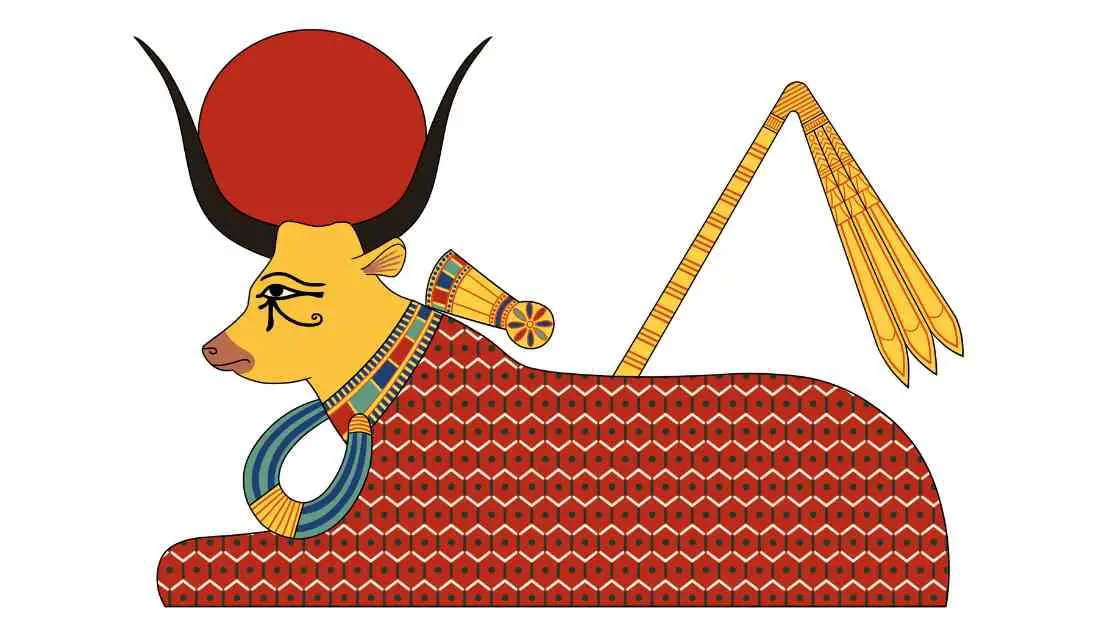
According to ancient Egyptian beliefs, Mehet-Weret emerged from these chaotic waters at the dawn of time, bringing forth the sun god Ra.
In an act that symbolizes the birth of light from darkness, she placed the newborn sun between her horns and lifted it into the sky each morning, marking the start of a new day.
This daily ritual was believed to renew the world, reinforcing Mehet-Weret’s role as a life-bringer and a sustainer of existence.
Over time, Mehet-Weret’s attributes were absorbed by Hathor, another prominent cow goddess in Egyptian mythology.
Hathor took over many of Mehet-Weret’s functions, including her association with the sky and her role as a mother figure to the sun god. Despite this, Mehet-Weret retained her distinct identity in the religious beliefs of the ancient Egyptians.
Hathor – Goddess of Love, Joy and Motherhood
Hathor is the daughter of Ra, the sun god, and in some narratives, she is the wife of Horus the Elder, another pivotal figure in the pantheon of ancient Egyptian gods.
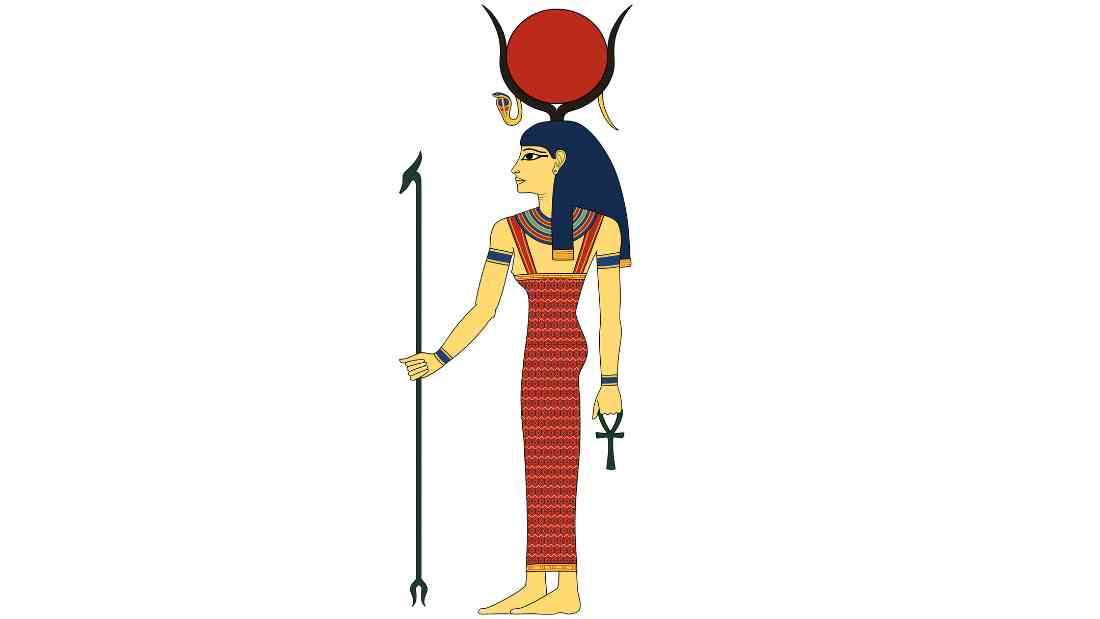
Hathor was renowned for her diverse representations and wide-ranging influence.
Often depicted as a cow, Hathor embodies maternal attributes and celestial aspects, symbolizing fertility, love, beauty, and music.
Her most common form was that of a woman adorned with a headdress of cow horns cradling a sun disk. This imagery underscores her celestial aspect, linking her to the sun god Ra, and emphasizes her role in sky-related matters. Her association with the sun disk also portrays her as a solar deity, shedding light on her multifaceted nature.
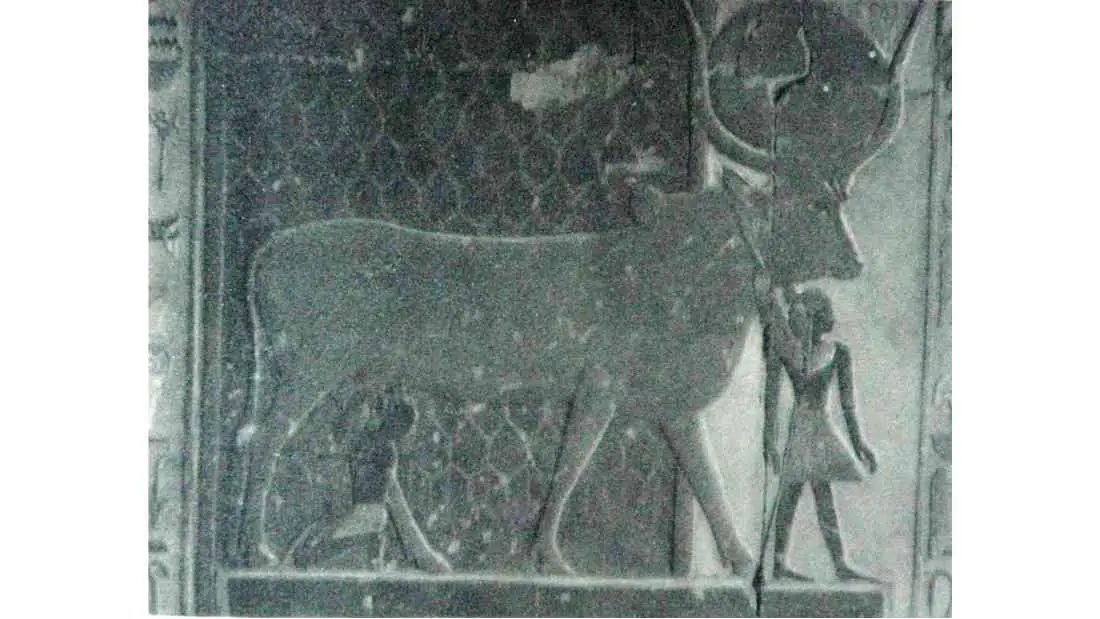
However, Hathor’s depictions are not confined to bovine and human forms. She could also be represented as a lioness, showcasing her fierce and protective side, or a cobra, symbolizing her transformative and healing powers.
Furthermore, Hathor could take the form of a sycamore tree, an embodiment that underscores her nurturing qualities and links her to life and rejuvenation.
Hathor’s diverse representations reflect the multiple roles she played in the pantheon of ancient Egyptian gods. As a celestial and maternal figure, she was viewed as the mother of the pharaohs, providing them with divine legitimacy. As a lioness or a cobra, she was a protector and healer. And as a sycamore tree, she was a life-giver and nurturer.
Hathor also has an intriguing association with Sekhmet. Despite their starkly contrasting attributes, Hathor and Sekhmet are two sides of the same divine coin.
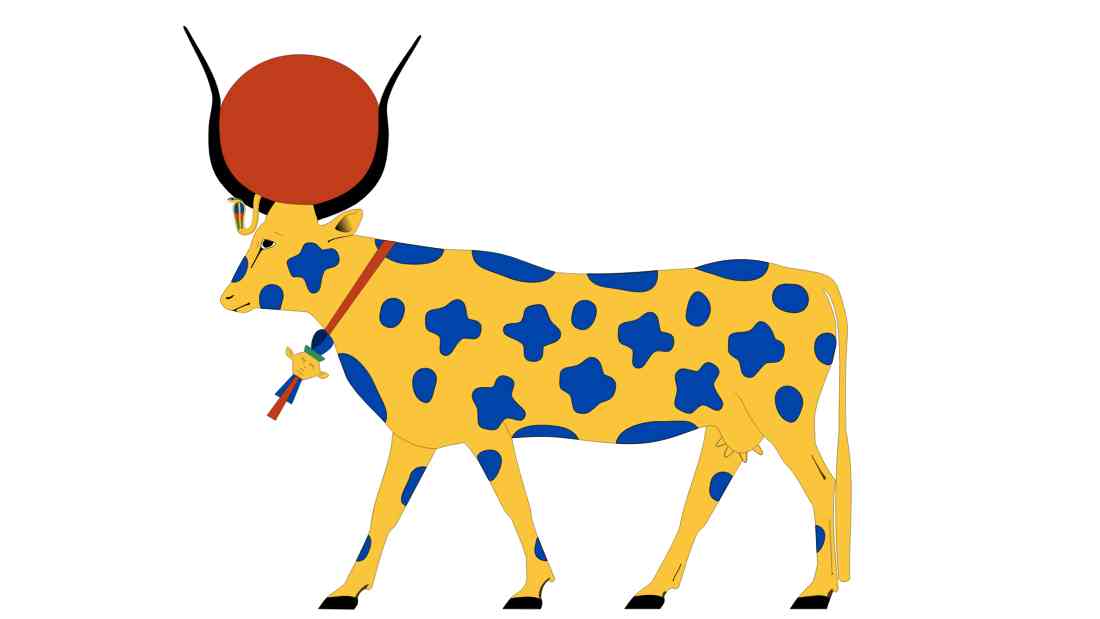
In one of the pivotal Egyptian myths, when Ra, the sun god, discovered a human conspiracy against him, he sent Hathor to punish the rebellious humans.
Hathor transformed into Sekhmet, the lioness goddess, to execute this task.
This transformation reveals the duality inherent in these deities, with Hathor representing life-giving aspects and Sekhmet embodying destructive power.
The association between Hathor and Sekhmet underscores the complex and multifaceted nature of divine beings in ancient Egyptian mythology, highlighting their capacity to embody opposing forces of creation and destruction.
Sekhmet – The Vengeance of Ra
One of the most compelling narratives in ancient Egyptian mythology revolves around the end of Ra’s reign on Earth, involving the goddesses Hathor and Sekhmet.
As the story goes, Ra, the sun god and ruler of the Earth, discovered a human conspiracy against him. In response, he sent Hathor, who transformed into the formidable lioness goddess Sekhmet, to punish the rebellious mortals.

Sekhmet, living up to her reputation as “The Powerful One,” descended upon the Earth with unquenchable blood-lust.
Her wrath extended beyond the battlefield, resulting in a terrifying rampage that wreaked havoc across Egypt and threatened the annihilation of humanity.
The ferocity of Sekhmet’s assault was so immense that it almost led to the extinction of mankind.
To avert this catastrophe, Ra and the other gods hatched an ingenious plan. They created a vast lake of beer and dyed it with red ochre, giving it the appearance of a sea of blood.
Consumed by her blood-lust, Sekhmet mistook the beer for blood and drank the entire lake.The effects were immediate and dramatic.
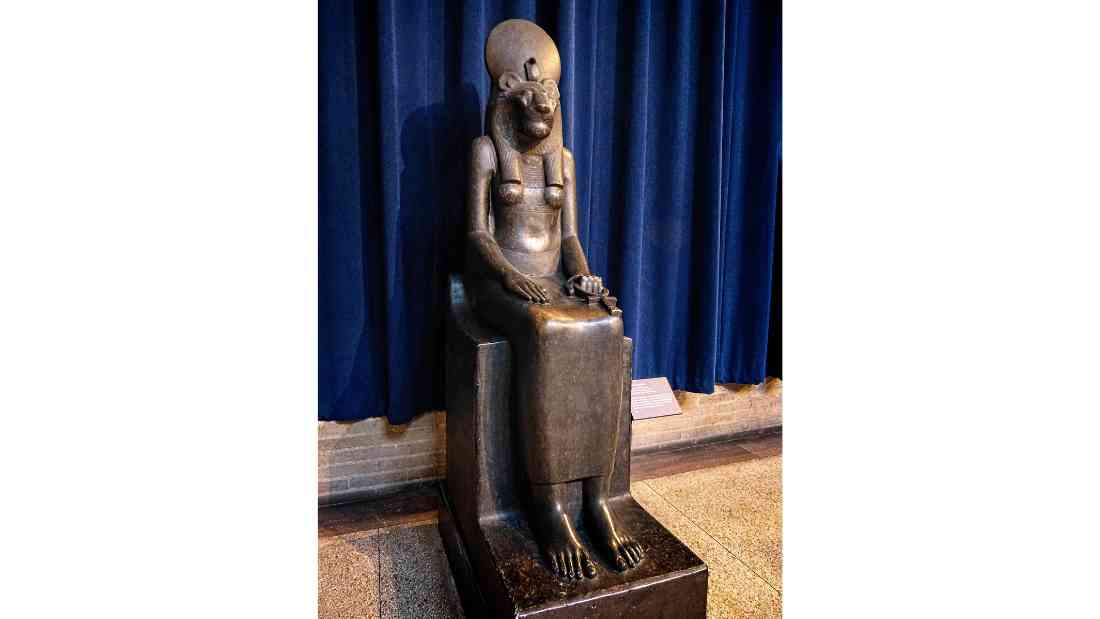
Overwhelmed by the intoxicating brew, Sekhmet’s fury subsided, and she became so inebriated that she abandoned her destructive spree.
With her thirst for blood quenched by the deceptive beverage, Sekhmet returned peacefully to Ra, marking the end of her rampage and saving humanity from total destruction.
Set – God of Chaos and Storms
Set is a complex and intriguing figure within the pantheon of ancient Egyptian gods.
As the god of chaos, storms, and war, Set embodies the unpredictable and tumultuous forces of nature and life.
His character, often associated with disruption and conflict, commands both fear and reverence for his potent power and volatile nature.

Unlike other deities in ancient Egyptian mythology who are represented by recognizable animals, Set is portrayed with an enigmatic creature’s head, often referred to as the ‘Set animal.’
This creature, bearing a curved snout and tall, squared-off ears, is unlike any known species, reinforcing Set’s association with the unfamiliar and chaotic.
As the god of chaos, Set symbolizes the unpredictable and potentially destructive aspects of existence.
He is often depicted as the antagonist in various mythological narratives, representing the forces that disrupt order and harmony. Yet, this association with chaos is not entirely negative – it also underscores the necessity of change and transformation, elements that are integral to the cycle of life.
Set’s dominion extends over storms, embodying the raw and untamed power of nature.
In a land like Egypt, where the climate is typically dry, storms can be both destructive and life-giving – bringing much-needed rain but also potentially devastating floods. This duality reflects Set’s character, a god who can bring both harm and benefit.

Moreover, as the god of war, Set was revered for his fierce strength and strategic prowess. He was often invoked for protection in battle, underscoring his role as a powerful defender despite his links to chaos and conflict.
Despite his complex and often negative associations, Set held a significant place of respect among the ancient Egyptian gods. His unpredictability and power were seen as necessary counterpoints to the order represented by other deities.
Astarte – Phoenician Goddess of Fertility and Sexuality
Astarte is a goddess of paramount importance in ancient Phoenician mythology, celebrated for her domains of fertility and sexuality.
She is often closely equated with other prominent goddesses from different cultures, including Aphrodite of the Greeks, Inanna/Ishtar of Mesopotamia, and Sauska of the Hittites.
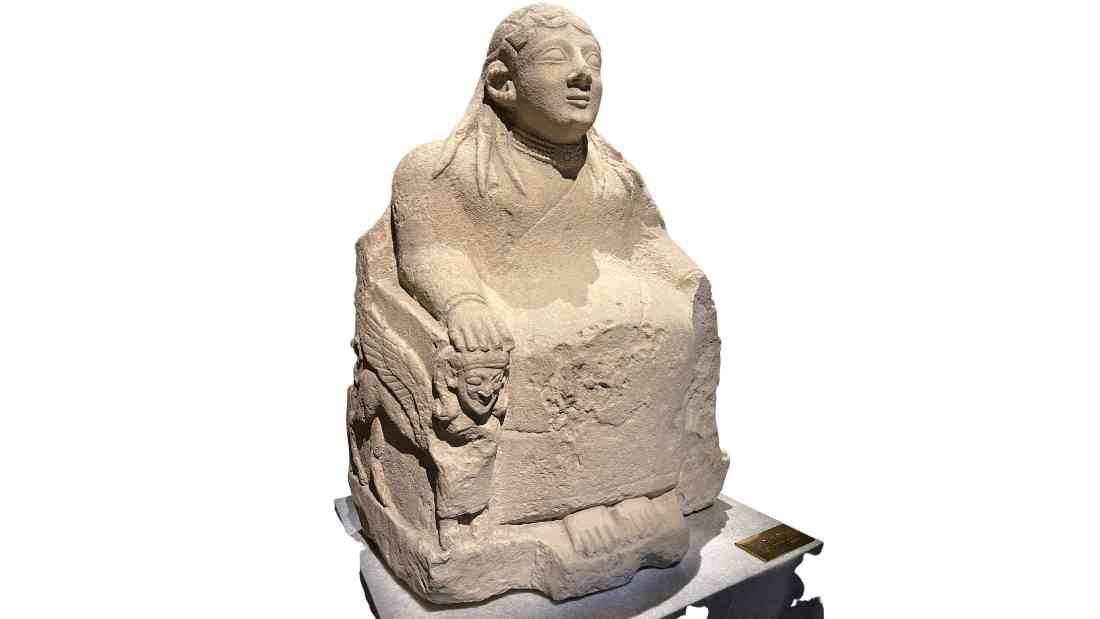
In Egyptian mythology, Astarte is presented as a consort to Set, the god of desert, storms, disorder and violence, hinting at a complex interplay of forces, balancing Set’s destructive tendencies with Astarte’s life-giving powers.
The coupling is facilitated by the goddess Neith, who gives Astarte and another goddess, Anat, to Set as consorts.
Astarte’s title, “Queen of Heaven,” underscores her elevated status within the divine hierarchy of ancient Egyptian gods. This epithet also suggests her association with celestial bodies, particularly the moon and Venus, often symbolizing femininity and fertility.
Thoth – The Enlightened God of Wisdom, Writing, and Knowledge
Thoth, known for his distinctive ibis-headed depiction, holds a crucial place in the pantheon of ancient Egyptian gods.
As the patron of scribes and wisdom, he is a symbol of intellectual pursuits, knowledge, and judgment. He is credited with the invention of hieroglyphics, the sacred writing system of ancient Egypt, further underscoring his association with wisdom and learning.
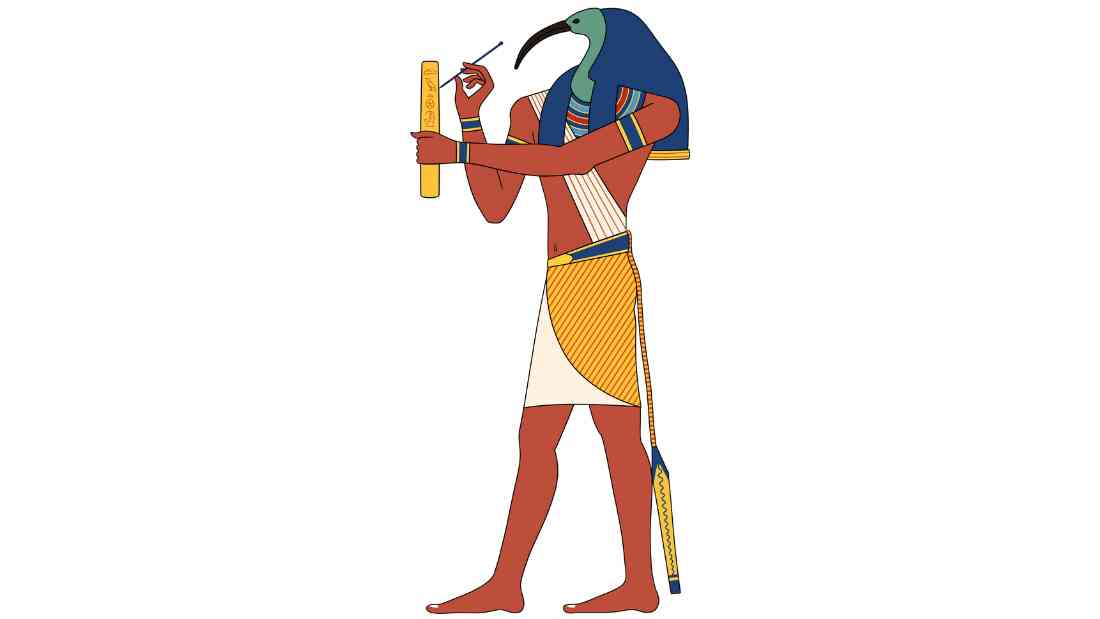
Thoth’s iconography as an ibis or a baboon underlines his association with wisdom.
Both animals were considered wise in ancient Egyptian culture, making them fitting symbols for Thoth’s role as the god of wisdom. The ibis, in particular, was seen as a careful and meticulous creature, mirroring the precision and attention to detail required in writing and scholarly work.
Thoth is credited with the invention of hieroglyphics, thereby establishing the foundation of ancient Egyptian written communication. As the inventor of writing, he was the protector of scribes, who played a critical role in administrative, religious, and scholarly activities.
Beyond his association with writing, Thoth was also the god of wisdom. He was believed to possess comprehensive knowledge of all things in the universe, including the secrets of the Egyptian gods and the mysteries of creation. His wisdom extended to the realms of law and justice, and he was often invoked in situations requiring discernment and judgment.
Moreover, Thoth was also associated with the measurement and marking of time. He was considered the keeper of divine records, tracking the passage of time and the unfolding of events. This role further emphasizes his association with knowledge and the orderly functioning of the world.
Bastet – The Lioness Goddess of Ancient Egypt
Bastet, also known as Bast, holds a significant place in ancient Egyptian mythology as the goddess of home, fertility, and childbirth, protector of the pharaoh, and defender of the sun god, Ra.

The name Bastet means “She of the Ointment Jar,” which reflects her association with protection and blessings.
Initially depicted as a lioness warrior, Bastet represented the fierce, protective qualities of a mother. As the civilization progressed, her image softened to that of a domestic cat, symbolizing the nurturing aspects of motherhood.
Often portrayed as a lioness or a woman with the head of a lioness or domestic cat, Bastet was a symbol of grace and poise. She wore a gold necklace and carried a sistrum, an ancient musical instrument, signifying her connection with music and dance.
Bastet was also associated with the Eye of Ra, a powerful protective deity. As the daughter of Ra, she played a crucial role in ancient Egyptian religion, defending Ra from his enemies and ensuring the sun’s daily journey across the sky.

Her role as a protector extended to the domestic sphere as well. Ancient Egyptians believed that Bastet watched over homes and pregnant women, safeguarding them from evil spirits and disease.
Moreover, Bastet was the presiding deity of the city of Bubastis, where grand festivals were held in her honor. These celebrations were renowned for their joyous dancing, music, and feasting, further emphasizing her reputation as a goddess of pleasure and festivity.
Anat – The Canaanite Goddess of Fertility, Sexuality, Love, and War
Anat, a powerful and complex figure in ancient mythology, embodies an intriguing blend of attributes. As a goddess of fertility, sexuality, love, and war, she holds a unique position among the ancient Egyptian gods.
Her origins are believed to lie in Syria or Canaan, but her influence extended far beyond these regions, permeating various ancient cultures and societies.
Anat’s image is multifaceted and somewhat paradoxical.
In some historical texts, she is ascribed the title ‘Mother of the Gods’, indicating a role of supreme maternity and nurturing. This aspect aligns with her association with fertility and highlights her importance in the creation and sustenance of life.
In contrast, other sources depict Anat as a virgin, untouched and independent. This depiction might seem at odds with her role as a fertility goddess, but it could also symbolize purity and the concept of self-contained potency.
Moreover, Anat’s sensuality and eroticism are also key characteristics. Described as the most beautiful of the goddesses, she embodies the allure and power of feminine beauty.
She is often depicted as a desirable figure, radiating a captivating charm that transcends physicality.
However, Anat is not merely a figure of love and beauty. She is also a formidable warrior goddess, known for her fierce and indomitable spirit. This martial aspect of Anat underscores her strength and resilience, portraying her as a protector and a force to be reckoned with.
Thus, Anat’s persona encapsulates the full spectrum of life – from creation and love to protection and conflict.
Anti – The Hawk God of Upper Egypt and His Association with Anat
Anti is a lesser-known but significant deity in the pantheon of ancient Egyptian gods.
Associated with the hawk, a bird that holds great symbolic value in Egyptian culture, Anti is primarily worshipped in Upper Egypt.
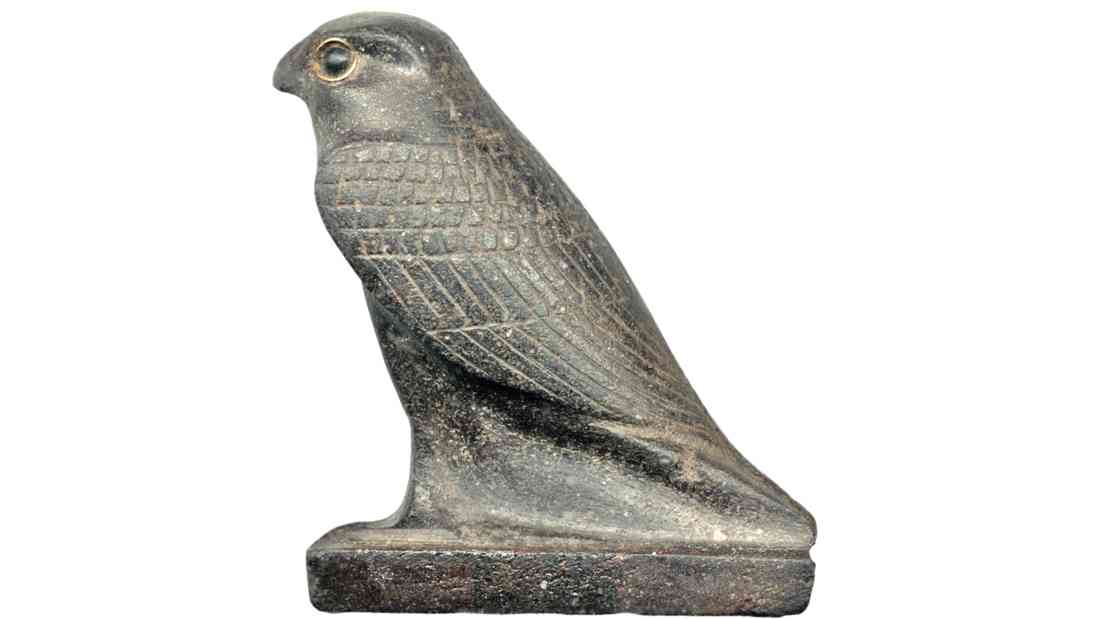
The hawk is a symbol of the sky, the sun, and the divine in Egyptian mythology, reflecting the god’s high status. It is seen as a protective figure, a guardian of the pharaoh and the Egyptian people.
Anti, as the Hawk God, embodies these qualities, representing protection, vigilance, and strength.
Interestingly, Anti has connections with the Canaanite goddess Anat. This association stems from cultural exchanges between ancient Egypt and Canaan, which influenced their respective mythologies.
Anti and Anat were sometimes merged into a single deity in some contexts, combining their attributes and roles, presenting an intriguing blend of Egyptian and Canaanite mythologies.
This amalgamation of the two deities resulted in a complex figure embodying both nurturing and protective qualities – a testament to the fluidity and interconnectedness of Egyptian mythology.
Ptah – The Creative God of Ancient Egypt
Ptah, one of the oldest and most significant deities in ancient Egyptian mythology, is revered as the god of craftsmen, architects, and builders. He is also recognized as the divine patron of the arts, metalworking, and sculpture.
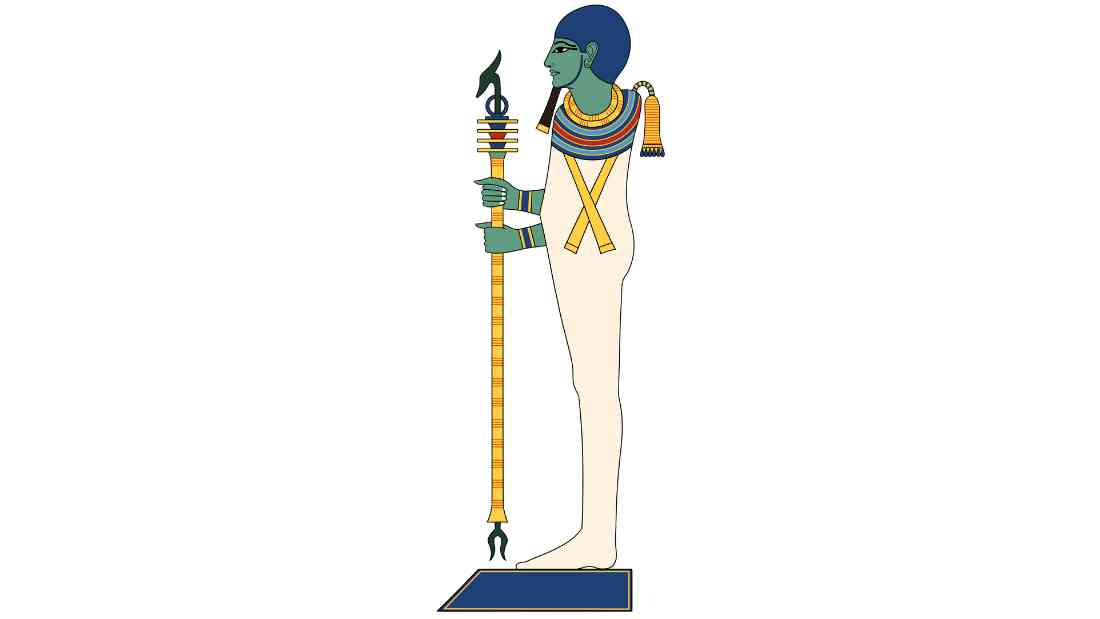
The name Ptah means “the opener,” a title that signifies his role as a creative force.
According to ancient Egyptian cosmology, Ptah is the creator god who brought the universe into existence through his heart’s thoughts and his tongue’s command. This belief underscores the importance of words and thought in the act of creation, a concept deeply ingrained in ancient Egyptian culture.
Ptah is often depicted as a mummified man wearing a skull cap, holding a staff that combines the ‘ankh‘ symbol (representing life), the ‘djed’ pillar (symbolizing stability), and the ‘was’ scepter (denoting power and dominion). This imagery not only symbolizes his creative power but also his authority over life and stability.
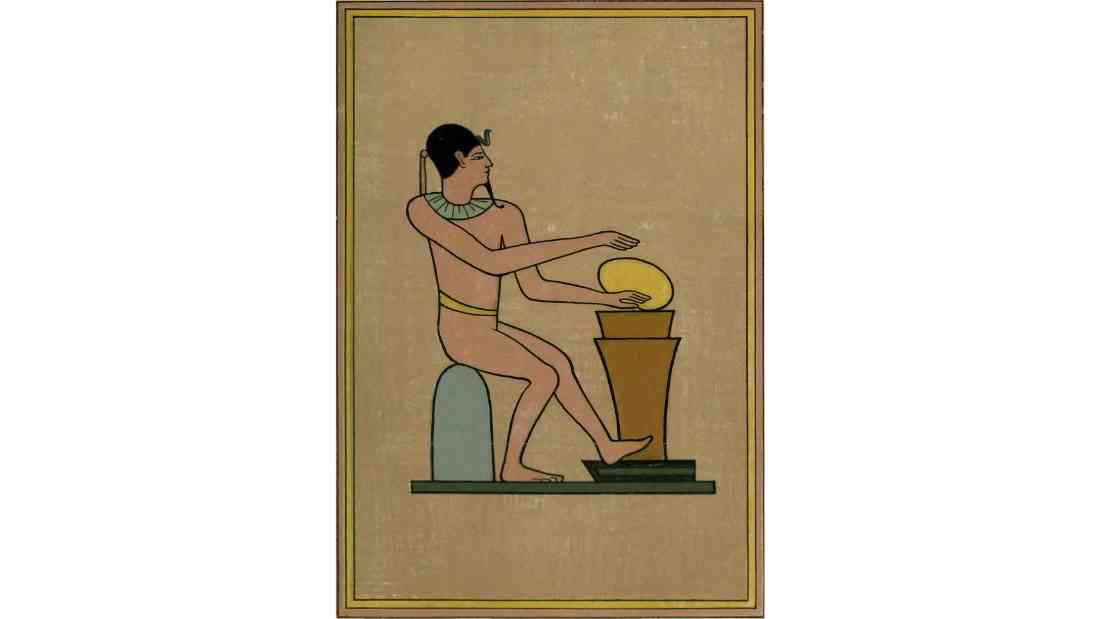
As the god of craftsmen and builders, Ptah was highly respected by laborers and artisans. His wisdom and skill were believed to inspire and guide them in their work.
Temples dedicated to Ptah, such as the great temple in Memphis, his cult center, became important centers for arts and crafts.
Moreover, Ptah also played a significant role in the afterlife. He was considered the god who reshapes bodies and souls in the underworld, preparing them for their eternal journey.
Apis – The Divine Bull and Incarnation of Ptah
Revered as an incarnation of the god Ptah, the creator deity and patron of craftsmen, Apis, the divine bull, symbolizes fertility, strength, and rebirth.
His worship was centered in Memphis, one of the oldest and most important cities in ancient Egypt.
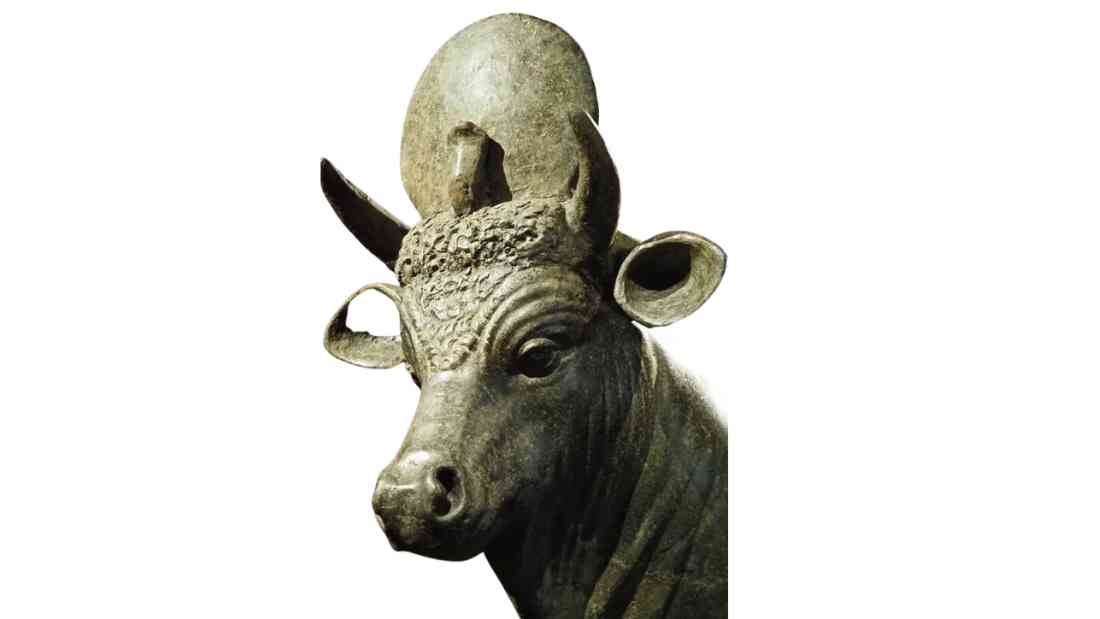
Apis is one of the earliest gods of ancient Egypt, with depictions dating back to around 3150 BCE on the Narmer Palette, a significant archaeological artifact from the Early Dynastic Period.
This early representation underscores the god’s enduring relevance in the evolving pantheon of Egyptian deities.
The Apis cult, dedicated to the worship of the divine bull, was one of the most significant and long-lived in the history of Egyptian culture. The longevity of this cult attests to the deep-seated reverence for Apis and his associated deity, Ptah.
The cult’s rituals often involved the ceremonial care and eventual mummification of selected bulls believed to be manifestations of Apis.
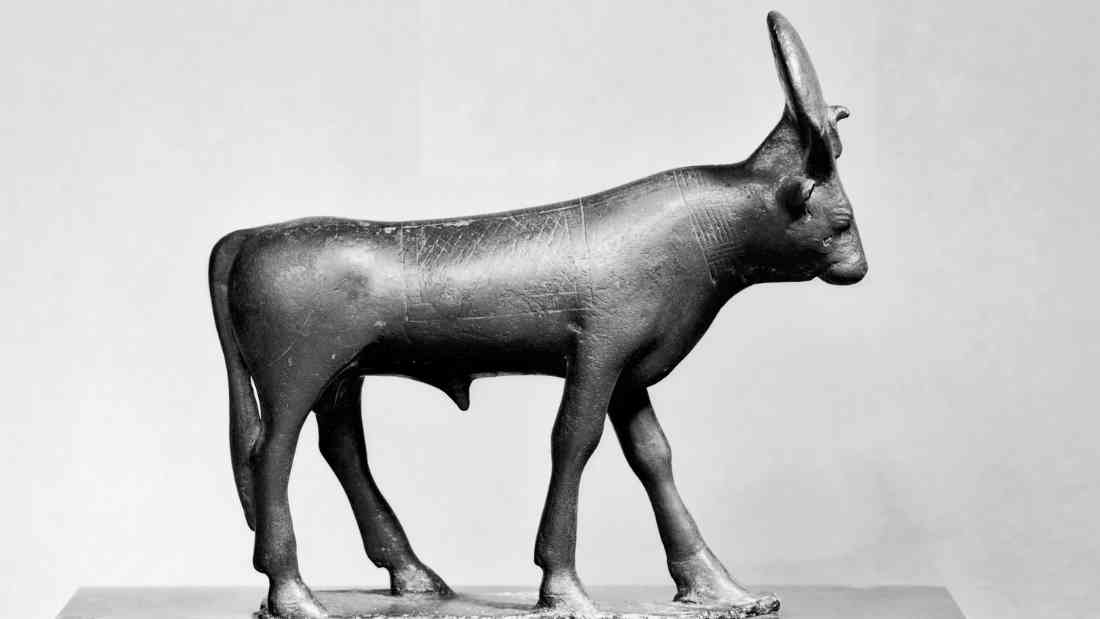
In the grand scheme of Egyptian mythology, Apis served as a powerful intermediary between humans and the gods.
As an earthly incarnation of Ptah, he provided a tangible link to the divine, allowing people to interact directly with a god’s presence. This interaction took the form of offerings and rituals aimed at seeking the gods’ favor or understanding their will.
Furthermore, Apis’s association with fertility and rebirth connected him with the cycles of nature and life, reinforcing the ancient Egyptians’ belief in the cyclical nature of existence and the promise of renewal.
Amun (Amun-Ra) – The God of the Sun and Air
Amun, also known as Amun-Ra, is one of the most powerful and popular deities in Egyptian mythology.
As the god of the sun and air, he held a central role in the pantheon of ancient Egyptian gods and was revered for his omnipotence and mystery.
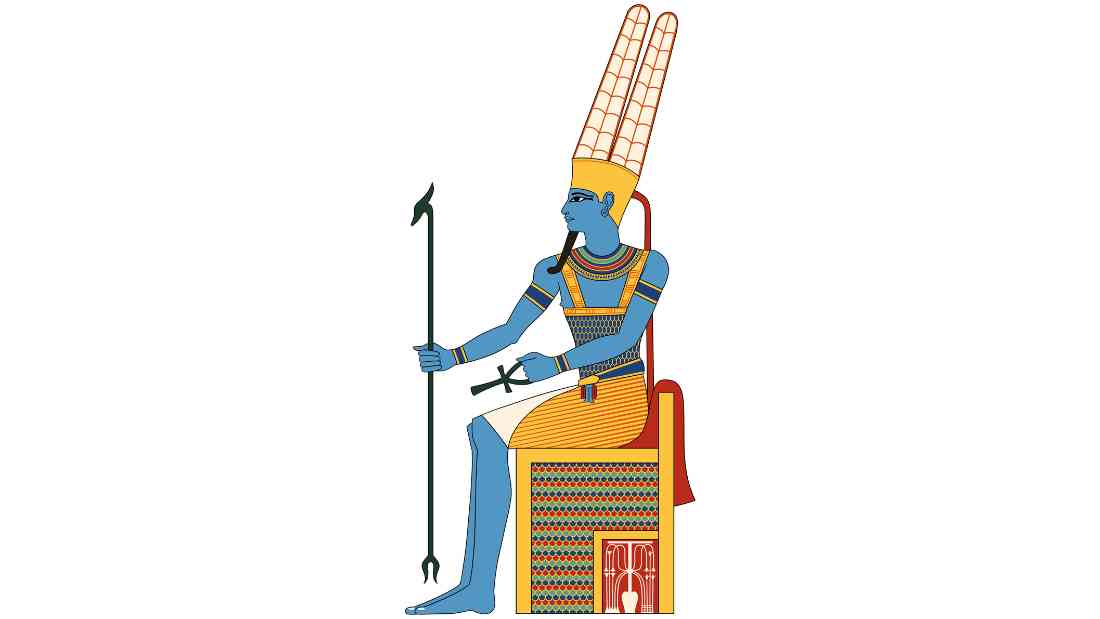
Amun’s influence was so profound that he was often merged with Ra, the ancient Egyptian sun god, to form Amun-Ra.
This combined deity represented the essential life-giving forces of the sun and air, embodying the creative powers necessary for all life.
As Amun-Ra, he was depicted as a man with a ram head or a man wearing a crown with sun disk and two tall plumes, symbols of his authority and power.
Amun was the patron god of Thebes, one of the most important cities in ancient Egypt.
Here, he was worshipped as part of the Theban Triad, which included Amun, his consort Mut, the goddess of motherhood, and their son Khonsu, the moon god.
Together, this divine family played a significant role in the religious life of Thebes, with grand temples built in their honor, the most famous being the Karnak temple complex.
The worship of Amun reached its zenith during the New Kingdom period of ancient Egypt, where he was hailed as the ‘King of the Gods’. His popularity even extended beyond Egypt, with his worship spreading to other parts of Africa and the Mediterranean.

Amunet – The Goddess of Hidden and Unseen Forces
Amaunet, a deity in the Hermopolitan Ogdoad of ancient Egyptian religion, represents the hidden and unseen forces in the universe.
As part of the Ogdoad—a group of eight primordial deities—Amaunet and her male counterpart, Amun, symbolize the concept of the hidden or the invisible.
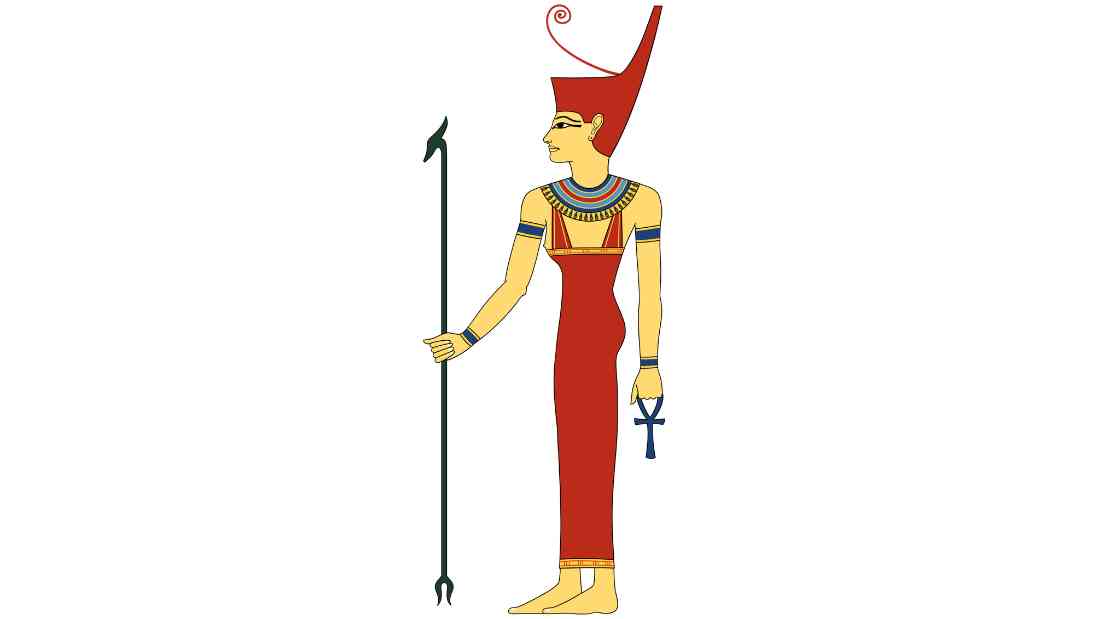
Eternal Space, CC BY-SA 4.0, via Wikimedia Commons
The name Amaunet translates to “the female hidden one,” reflecting her role as the embodiment of the unseen powers and mysteries of life. This goddess is particularly associated with the primordial waters of Nun, from which the world was believed to have emerged.
Amaunet is often depicted as a woman wearing the Red Crown, a symbol of Lower Egypt.
Other depictions represent her in an anthropomorphic form with the head of a snake, which aligns her with the other female deities of the Ogdoad who are also portrayed with serpentine features.
This snake symbolism, often associated with renewal, might be interpreted as a nod towards Amaunet’s association with the mysterious forces of creation and rebirth.
Despite her abstract realm, Amaunet holds a significant place in ancient Egyptian cosmology. Her representation of the hidden forces complements the other deities of the Ogdoad, who together embody the conditions from which the ordered world arose.
Her unseen forces are considered fundamental to the process of creation, making Amaunet integral to the ancient Egyptian understanding of the universe’s origins.
Mut – The Mother Goddess
Mut is an emblematic figure in ancient Egyptian mythology, known for her role as a mother goddess.
While her presence in the pantheon of ancient Egyptian gods during the Predynastic Period (c. 6000-3150 BCE) is believed to have been minor, she rose to prominence in later periods, particularly as part of the Theban Triad.
In the early stages of Egyptian civilization, Mut’s role was likely overshadowed by other mother goddesses. However, with the rise of Thebes as a significant religious and political center, Mut gained considerable importance.
She became associated with Amun, the god of the sun and air, and Khonsu, the moon god, forming the revered Theban Triad.

As the wife of Amun and mother of Khonsu, Mut embodied the aspects of motherhood, family, and royalty.
She was often depicted as a woman wearing the double crown of Upper and Lower Egypt, signifying her authority and status.
In some representations, she appears with lioness features or as a vulture, symbols associated with motherhood and protection in ancient Egyptian culture.
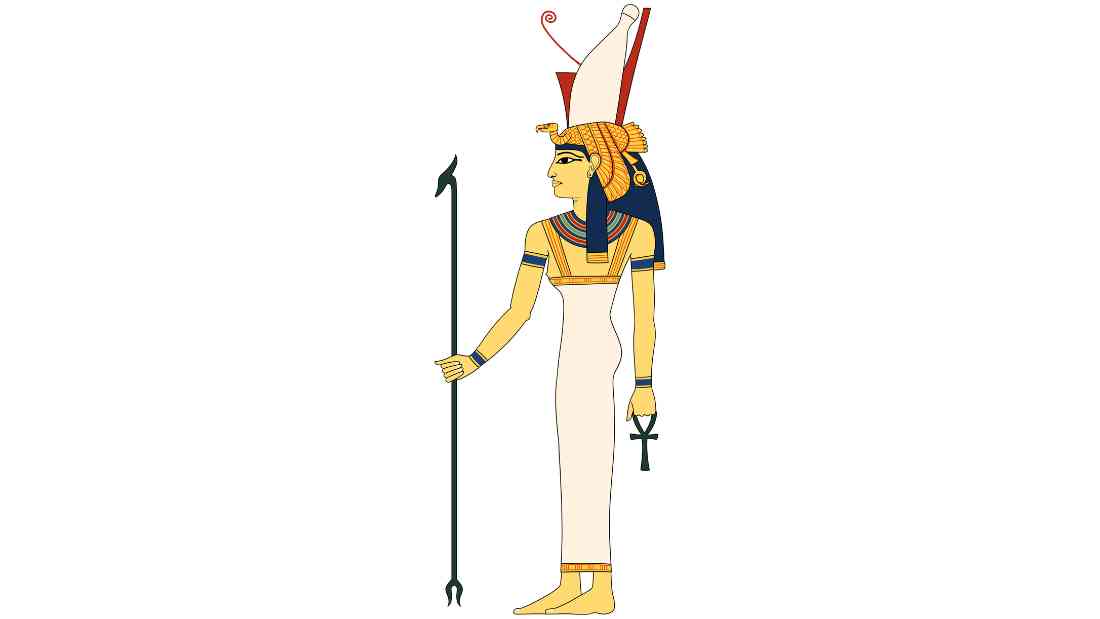
The Temple of Mut in Karnak, part of the vast Karnak Temple Complex in modern-day Luxor, stands as a testament to her significance. This sanctuary, dedicated to her worship, showcases her elevated status in Theban society and the broader Egyptian pantheon.
Khonsu – The Traveler and God of the Moon
Khonsu, also known as Kons, Chonsu, Khensu, or Chons, is a significant deity in the ancient Egyptian pantheon of gods. Known as ‘The Traveler,’ he was venerated as the god of the moon, symbolizing time, visibility, and rejuvenation.
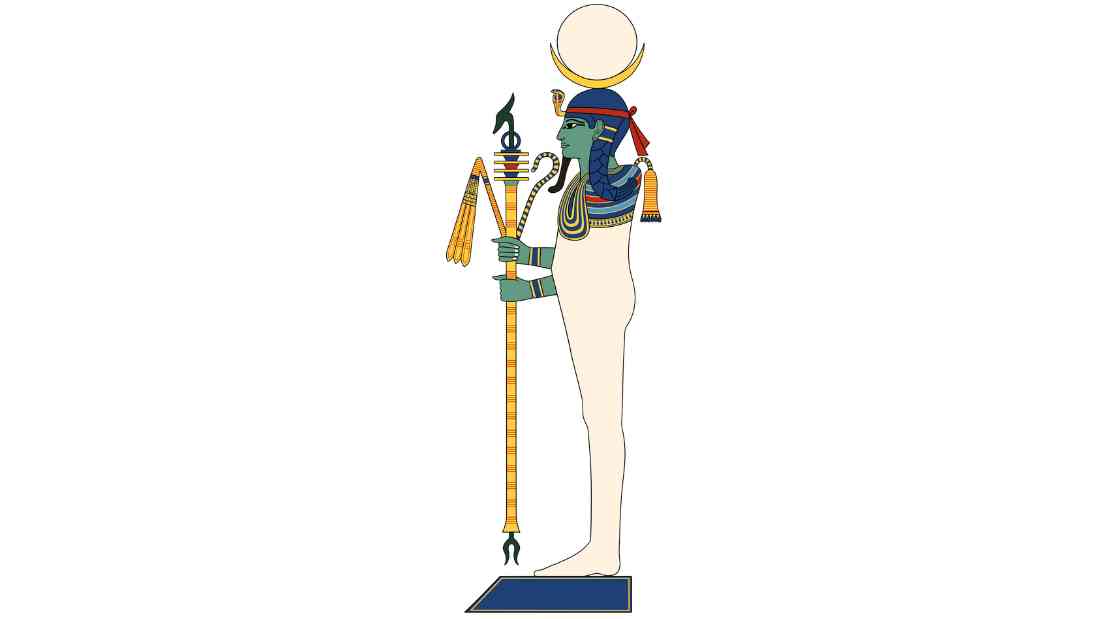
Khonsu’s name, which translates to ‘The Traveler,’ reflects his association with the moon.
As the moon travels across the sky, marking the passage of time, Khonsu was believed to govern time itself. This connection made him an essential figure in Egyptian lunar and calendar systems.
The importance of Khonsu extended beyond his lunar associations.
He formed one-third of the influential Theban Triad, alongside his father Amun, the god of the sun and air, and his mother Mut, the mother goddess.
The triad was central to the religious practices in Thebes, one of the most powerful cities in ancient Egypt. Each member of this divine family held a specific role, with Khonsu embodying youth and renewal.
In ancient Egyptian art, Khonsu is often depicted as a mummiform child, signifying his role as the youthful moon god. He is usually shown wearing a sidelock of youth and holding the crook and flail, symbols of kingship. His head is adorned with a moon disk and crescent, emphasizing his lunar associations.
The Temple of Khonsu, part of the Karnak temple complex in modern-day Luxor, is a testament to his reverence. This dedicated space for worship attests to Khonsu’s significance within the Theban Triad and his influence on the religious practices of ancient Egypt.
Amunhotep, Son of Hapu – The Deified God of Healing and Wisdom
Amunhotep, son of Hapu, is known for his contributions to healing and wisdom.
Unlike the majority of ancient Egyptian gods, Amunhotep was a real historical figure who achieved a rare honor – he was deified by the Egyptians, joining the ranks of Hardedef and Imhotep.

Born in the 18th Dynasty under the reign of Pharaoh Amenhotep III, Amunhotep, son of Hapu, was a high-ranking official and architect.
He was responsible for several monumental constructions, including the funerary temple of Amenhotep III on the West Bank at Thebes. His wisdom and contributions to architecture were highly recognized, leading to his posthumous veneration as a god of wisdom.
In addition to wisdom, Amunhotep was also revered as a god of healing. His healing powers were considered so significant that sick people would inscribe their ailments on stelae, or stone pillars, at his mortuary temple in Thebes, hoping for divine intervention.
The popularity of Amunhotep’s cult grew in the Late Period (664-332 BCE) and continued through the Ptolemaic Period (332-30 BCE). Temples dedicated to him can be found throughout Egypt, showcasing his widespread influence and the enduring respect for his wisdom and healing abilities.
Amunhotep’s transition from a human being to a deity underscores the fluid nature of the pantheon of ancient Egyptian gods. His deification represents an intriguing aspect of Egyptian culture, where exceptional human beings could achieve divine status through their wisdom and contributions to society.
Hardedef – The Deified Son of King Khufu and Author of ‘Instruction in Wisdom’
Hardedef, also known as Hordjedef, holds a unique place in ancient Egyptian history and mythology.
As the son of King Khufu (also known as Cheops, 2589-2566 BCE), he was born into royalty. However, his lasting legacy extends beyond his royal lineage, primarily due to his authorship of a remarkable work known as the ‘Instruction in Wisdom.’
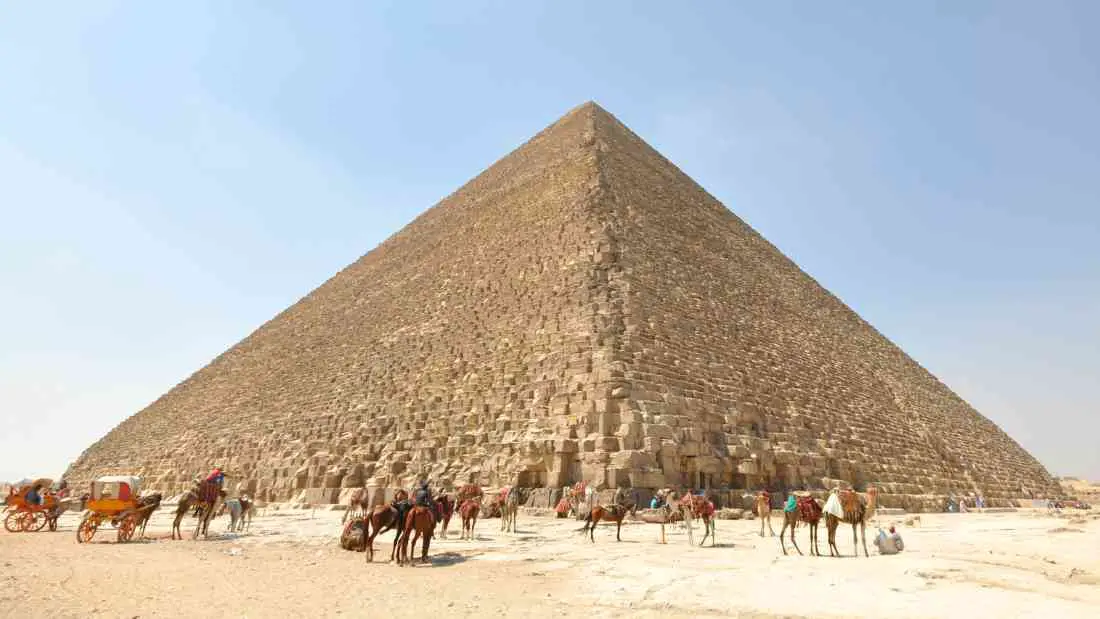
The ‘Instruction in Wisdom’ is considered one of the earliest pieces of ‘wisdom literature’ from ancient Egypt. This genre typically includes advice on moral conduct, practical life lessons, and philosophical reflections, aimed at guiding the reader towards a virtuous and successful life.
Hardedef’s contribution to this literary tradition showcases his intellectual prowess and deep understanding of human nature and morality.
What sets Hardedef apart is the level of reverence his work received. His ‘Instruction in Wisdom’ was so brilliant and impactful that it was considered divine in origin.
This extraordinary recognition led to his deification after death, an honor bestowed upon very few individuals in ancient Egypt.
As in the case of Amunhotep and Imhotep, Hardedef’s deification represents a fascinating aspect of ancient Egyptian culture, where the boundary between the human and the divine could be blurred.
Exceptional wisdom and contributions to society could elevate a mortal to the pantheon of ancient Egyptian gods, highlighting the profound respect for knowledge and wisdom in ancient Egypt.
Imhotep – The Polymath Vizier and Deified God of Wisdom and Medicine
Imhotep, whose name translates to “He Who Comes in Peace,” was a remarkable figure in ancient Egyptian history.
Living roughly between 2667-2600 BCE, he served as the vizier to King Djoser and is renowned for his significant contributions to architecture, wisdom, and medicine.
His exceptional abilities and accomplishments ultimately led to his deification, marking him as one of the few mortals in ancient Egypt to achieve divine status.
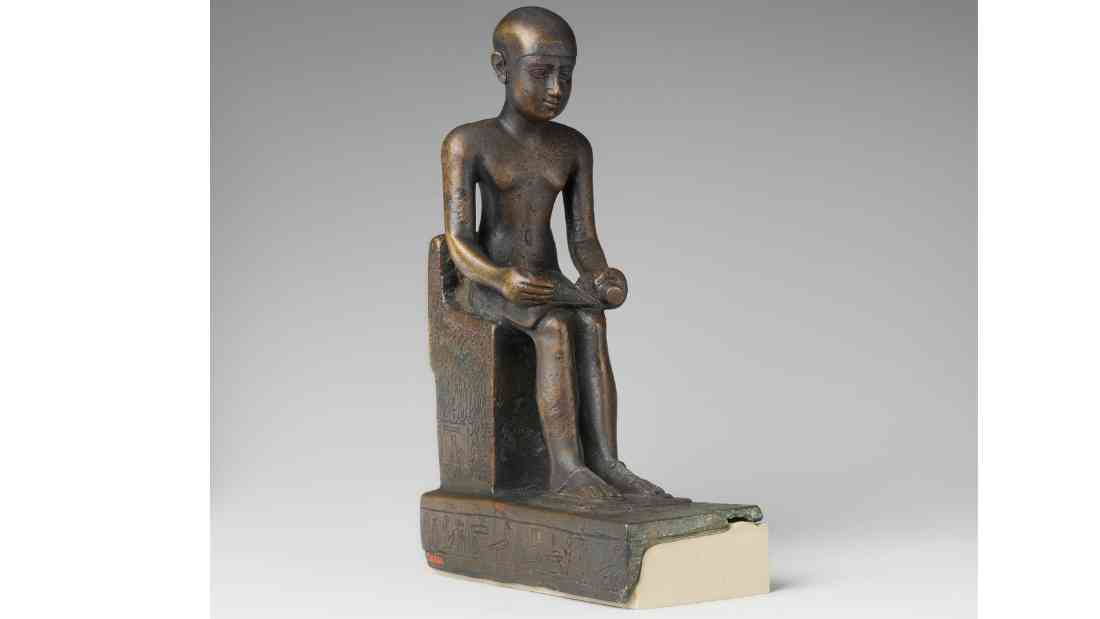
As the chief adviser to King Djoser, Imhotep held a position of great authority and influence. However, it is his architectural ingenuity that has left the most enduring mark on history.
He is credited with the design and construction of the Step Pyramid at Saqqara, the first colossal stone building and the earliest colossal stone pyramid in Egypt. This architectural marvel set a precedent for future pyramid constructions and stands as a testament to Imhotep’s innovative spirit.
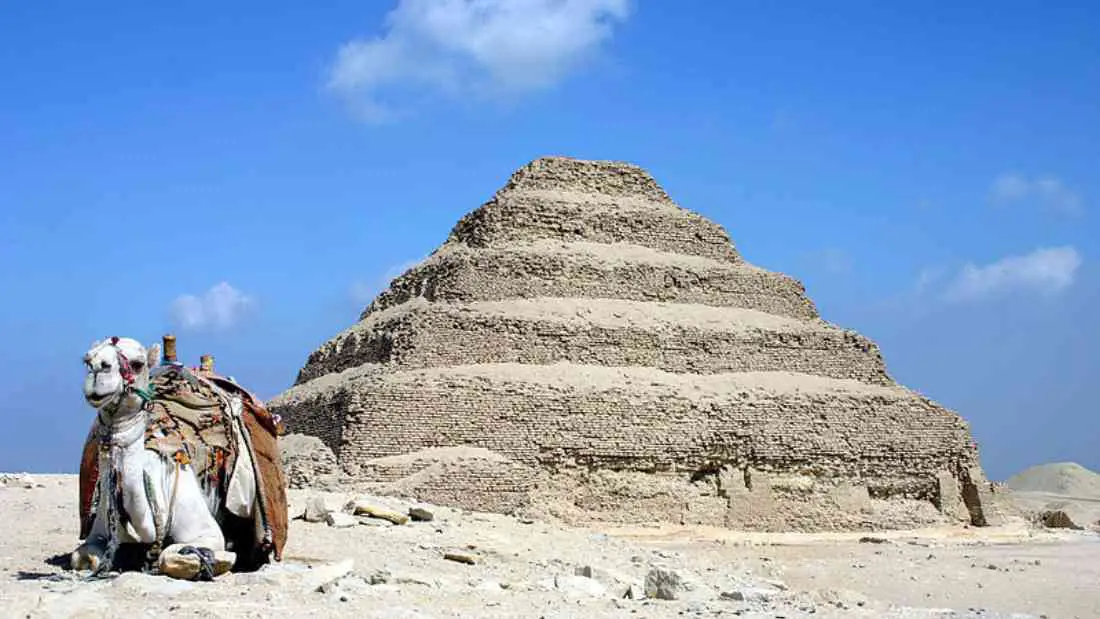
Beyond his architectural achievements, Imhotep was also a polymath, demonstrating expertise in various fields of study. His wisdom was highly valued, and he is often considered one of the first known philosophers. His teachings and sayings were studied and revered for thousands of years after his death.
In addition to his wisdom, Imhotep was associated with medicine, making significant contributions to the field. His medical treatises provided insights into ancient Egyptian practices and knowledge, further enhancing his reputation as a man of wisdom and learning.
Following his death, Imhotep’s extraordinary contributions to society led to his deification.
He was venerated as a god of wisdom and medicine, a rare honor that underscores his unique role in ancient Egyptian history. Temples were erected in his honor, and he was invoked by the sick and injured in their prayers for health and healing.
Asclepius (Aesculapius) – The Greek God of Healing
Asclepius, known to the Romans as Aesculapius, is a significant deity within Greek mythology, renowned for his healing abilities.
Famed as the god of medicine and healing, Asclepius’s influence extended beyond Greece’s borders, reaching the ancient Egyptians who also held him in high regard.

In Egypt, Asclepius was worshipped primarily at Saqqara, an extensive ancient burial ground serving as the necropolis for the ancient Egyptian capital, Memphis.
Here, the god of healing gained a new identity, becoming associated with Imhotep, a revered Egyptian figure.
The identification of Asclepius with Imhotep highlights the shared value both cultures placed on healing and medicine. It also illustrates the fluidity of ancient mythology, where gods could transcend cultural boundaries, adapting to local contexts while maintaining their core attributes.
Asclepius’s cult in Egypt reflected this syncretism, blending Greek and Egyptian religious practices.
Healers and patients alike would invoke Asclepius-Imhotep, seeking divine intervention for ailments. Temples dedicated to the god served not only as places of worship but also as healing centers, reinforcing the practical application of the deity’s domain.
Ash (As) – The Oasis Provider in the Libyan Desert
Ash, also known as As, is a deity hailing from ancient Egyptian mythology, revered as the god of the Libyan desert.
Unlike the harsh and unforgiving nature often associated with desert deities, Ash stands out as a benevolent figure.
He is celebrated for providing oases to weary travelers journeying through the vast, arid expanses.
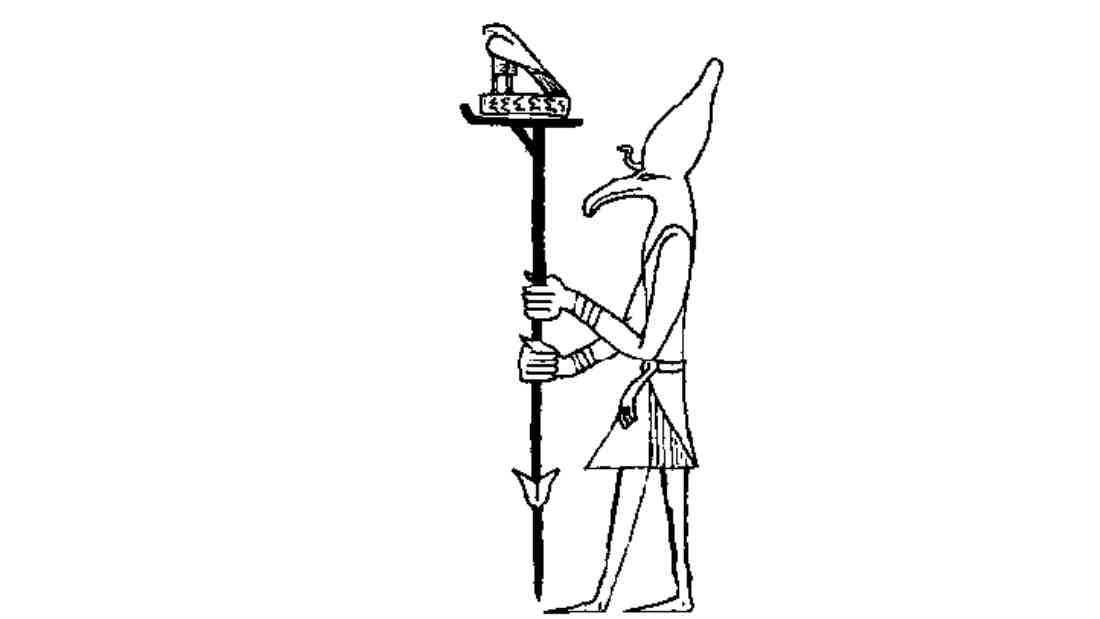
The Libyan desert, part of the greater Sahara Desert, is an extensive, challenging landscape.
Travelers crossing this desert face extreme conditions, including scorching heat during the day, freezing cold at night, and the constant threat of deadly sandstorms.
In this harsh environment, the appearance of an oasis could mean the difference between life and death.
Ash’s role as the provider of these life-saving oases marks him as a symbol of hope and survival. His gifts of water and shelter offered not only physical relief but also a psychological respite, giving travelers the strength and will to continue their journey.
His veneration underscores the ancient Egyptians’ deep understanding of their environment and their respect for the forces that shaped it. It also highlights their belief in the power of divine intervention, placing their trust in Ash to guide them safely through the perilous desert.
Hedetet – The Scorpion Goddess
Hedetet held a significant position in the pantheon of ancient Egyptian gods, primarily due to her role as a protectress against scorpion venom.

Scorpions were common in ancient Egypt, posing a serious threat to humans with their venomous stings.
In this harsh context, Hedetet emerged as a divine shield, offering protection against these lethal creatures. Her worship underscored the Egyptians’ respect for the natural world’s dangers and their faith in divine intervention for survival.
Hedetet is often considered an early version of Serket, another Egyptian goddess associated with scorpions. Like Hedetet, Serket was revered as a protector against venomous stings.
However, Serket’s influence expanded beyond this role, encompassing healing, magic, and protection of the pharaoh. Despite these differences, the connection between Hedetet and Serket illustrates the evolution of religious beliefs and practices in ancient Egypt.
Serket – The Protective and Funerary Goddess
Serket, also known as Selket, Serqet or Serkis, is an ancient Egyptian goddess with a role that extends beyond protection to encompass funerary rites.
Her origins likely date back to the Predynastic Period (c. 6000-3150 BCE), making her one of the earliest revered deities. She is first mentioned during the First Dynasty of Egypt (c. 3150-2890 BCE), testifying to her longstanding importance in Egyptian worship.

Best known from her golden statue discovered in Tutankhamun’s tomb, Serket’s depiction is both unique and symbolic.
She is often portrayed as a woman with a scorpion resting on her head, her arms extended in a protective pose. This imagery reflects her dual role as the guardian against venomous stings and a defender of the divine order.
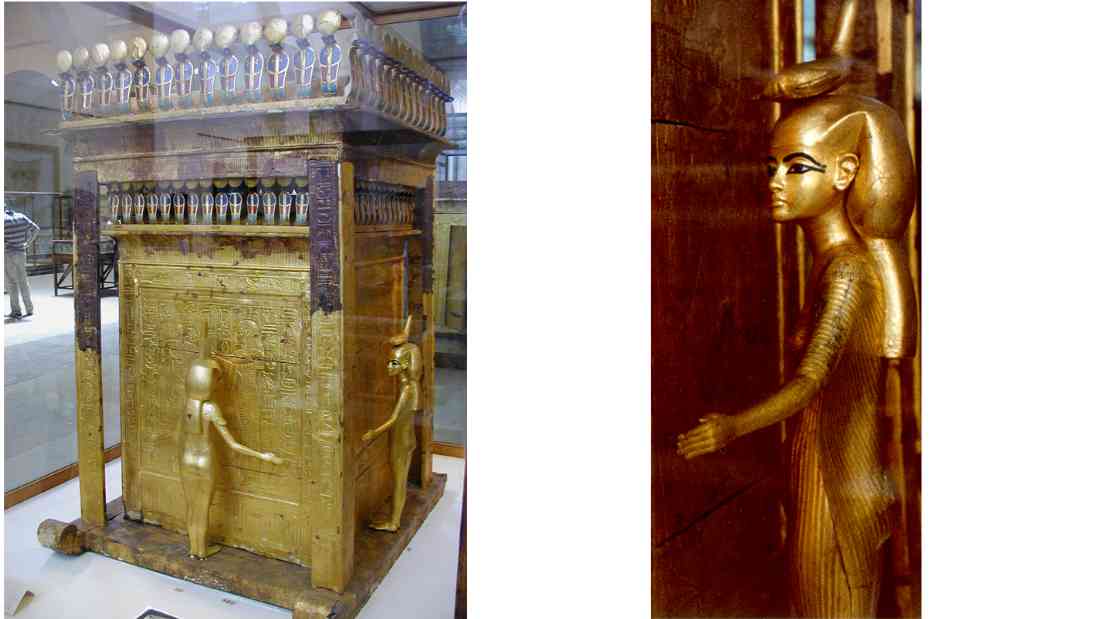
Serket’s association with scorpions links her to the goddess Hedetet, believed to be an earlier incarnation of Serket.
Both goddesses share the scorpion as their emblem, symbolizing their protective powers against the dangers of the natural world.
In addition to her protective role, Serket was also an important figure in funerary rites.
Her presence in Tutankhamun’s tomb attests to her crucial function in guiding and safeguarding the deceased in their journey to the afterlife.
This funerary aspect of Serket showcases the Egyptians’ deep-rooted beliefs in life after death and the divine intervention needed for a successful transition.
Meskhenet – The Goddess of Childbirth
Meskhenet is the goddess of childbirth and destiny. Often depicted as a woman with a birthing brick on her head – a nod to the traditional Egyptian method of assisting women in delivery by having them squat or kneel on bricks – Meskhenet was believed to be present at every birth, bestowing a child’s fate at the moment they entered the world.
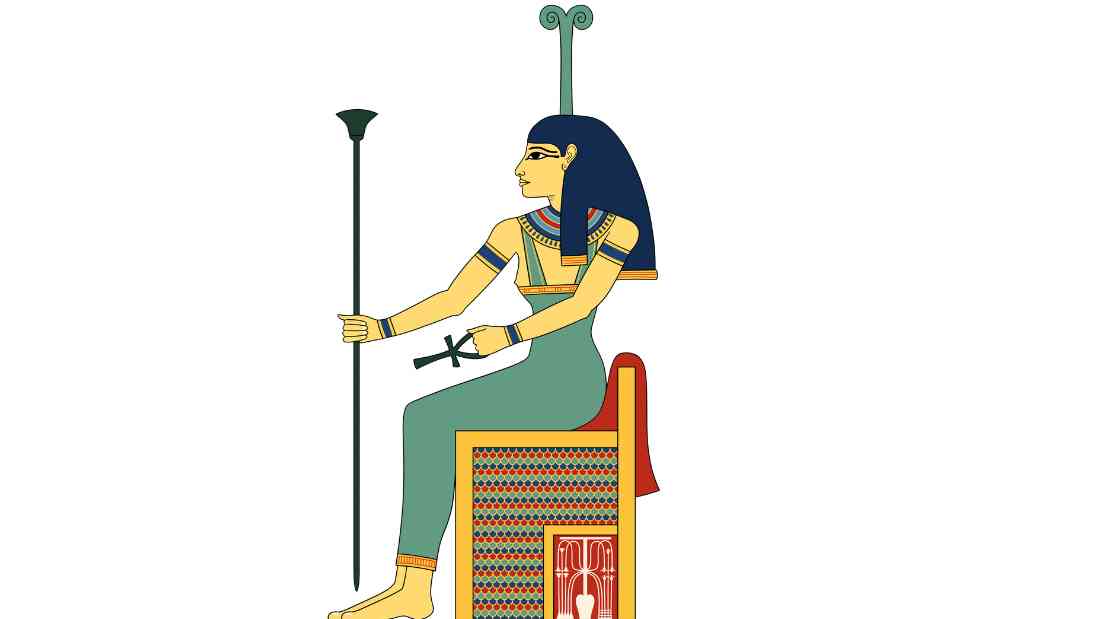
Beyond her role in childbirth, Meskhenet was also associated with the concept of ka, an element of the soul in ancient Egyptian belief.
She was thought to help shape a person’s ka, which would then accompany them throughout their life, influencing their character and destiny.
Interestingly, Meskhenet’s influence extended into the afterlife.
In the Book of the Dead, she is depicted as one of the deities presiding over the Weighing of the Heart ceremony. This critical event determined whether a deceased person could enter the afterlife, further emphasizing Meskhenet’s role in deciding human fate.
Meskhenet’s story offers a glimpse into how the ancient Egyptians understood life’s critical events, from birth to death. As the goddess of childbirth, she was seen as a guardian of life’s beginning, while her role in the afterlife reflected her continued guidance beyond mortal existence.
Montu – The Falcon God
Montu, the falcon god, is a significant figure in ancient Egyptian mythology and the pantheon of gods, especially during the 11th Dynasty in Thebes.
Often depicted as a man with the head of a falcon, Montu was revered as the god of war and a symbol of royal power.
As his cult grew in prominence, he became closely associated with the Theban region, which was a major political and cultural center of ancient Egypt during the Middle Kingdom.
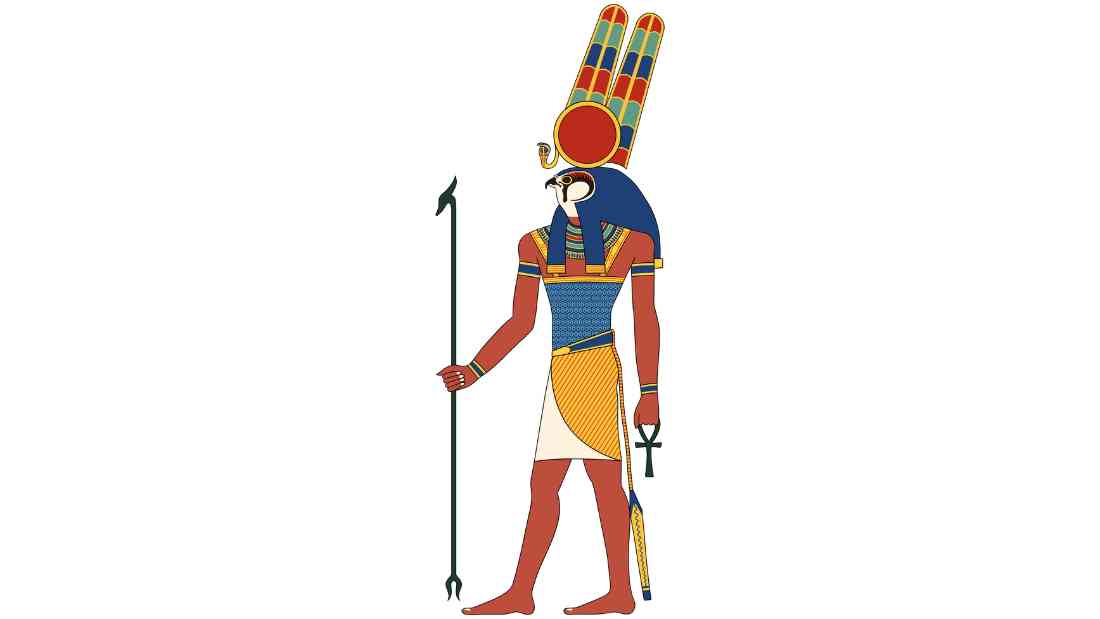
Montu’s rise to prominence coincided with the ascendancy of Thebes and its rulers.
The Theban kings, particularly those of the 11th Dynasty, saw Montu as their divine patron and often referred to themselves as “Montu in the palace” to signify their divine right to rule and their prowess in warfare.
They built several temples dedicated to Montu in the Theban region, including the Temples of Montu at Medamud and Tod, further cementing his status as a powerful deity.
Beyond his martial attributes, Montu was also associated with the sun god Ra. He was often depicted in solar iconography, reinforcing his status as a powerful divine entity.
Despite this, his primary role remained as a symbol of military strength and royal authority, reflecting the cultural and political realities of the time.
The story of Montu provides a fascinating insight into the interplay between religion and politics in ancient Egypt. His prominence during the 11th Dynasty underscores how deities were often used to legitimize and reinforce royal power, illustrating the intricate relationship between the divine and the mortal realms in ancient Egyptian society.
Anhur – The God of War and Hunting
Anhur, also known as Onuris, was revered as a god of war and hunting, embodying strength, courage, and skill.
His name, which translates to “He Who Brings Back The Distant One,” is not merely a title but a testament to his role in one of the most significant myths of ancient Egypt.
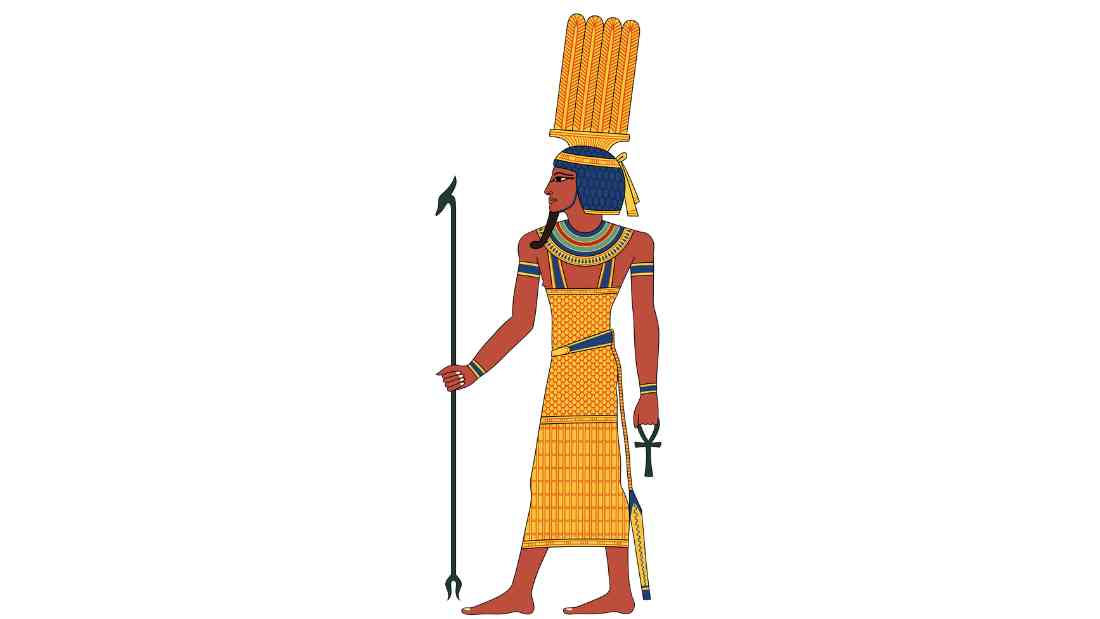
The tale referred to by his name involves a quest to retrieve the Eye of Ra, a powerful symbol of protection and destructive force in ancient Egyptian religion.
According to the story, the Eye of Ra, personified as a goddess, departed Egypt for Nubia out of anger and began causing havoc. Recognizing the danger this posed, Anhur embarked on a mission to bring back the Eye of Ra.
His successful retrieval of the Eye of Ra from Nubia underscores his courage and tenacity.
This act not only restored balance but also prevented the destruction that the Eye of Ra could cause in its wrathful state. This story further solidifies Onuris’ status as a protector deity, a role often associated with war gods in ancient civilizations.
Beyond his heroic exploits, Onuris’ association with hunting highlights the importance of this activity in ancient Egyptian society. Hunting was not just a means of survival but also a symbol of mastery over chaos, reflecting the belief in the need to maintain order against the forces of disorder.
Panebtawy – The Child God
Panebtawy embodies the innocence, potential, and divine lineage of childhood.
Known as the child god, Panebtawy serves as the personification of the king as the divine son of Horus, the falcon-headed god associated with kingship, the sky, and war.
In addition, he also embodies Horus as a child, further reinforcing his connection to one of the most significant deities in the ancient Egyptian pantheon.
The depiction of Panebtawy is distinctive and full of symbolism. He is typically shown as a young boy with his finger to his lips. This pose, common among representations of children in ancient Egyptian art, symbolizes childhood’s innocence and silence.

What makes Panebtawy particularly interesting is how his image prefigures that of Harpocrates, the Greek version of the child Horus.
After the conquest of Egypt by Alexander the Great, many ancient Egyptian gods were incorporated into Greek religion, albeit with Greek interpretations and adaptations.
Harpocrates, recognized for his silence and secrecy, is a result of this syncretism, with his imagery directly influenced by Panebtawy.
In Panebtawy, we see an embodiment of the duality of divine and human nature that was central to ancient Egyptian kingship. The king was considered both a god and a human being, bridging the gap between the mortal world and the realm of the gods.
Panebtawy, as the divine child of Horus and the personification of the king, encapsulates this complex concept elegantly.
Qudshu – The Syrian Goddess of Love
Qudshu, also known as Qadesh, is a fascinating figure in ancient Near Eastern mythology.
Originating from Syria, she is the goddess of love, sexual pleasure, and sacred ecstasy. Her influence extended beyond her native region, reaching the land of the Nile during the New Kingdom period (1570-1069 BCE) of ancient Egypt.
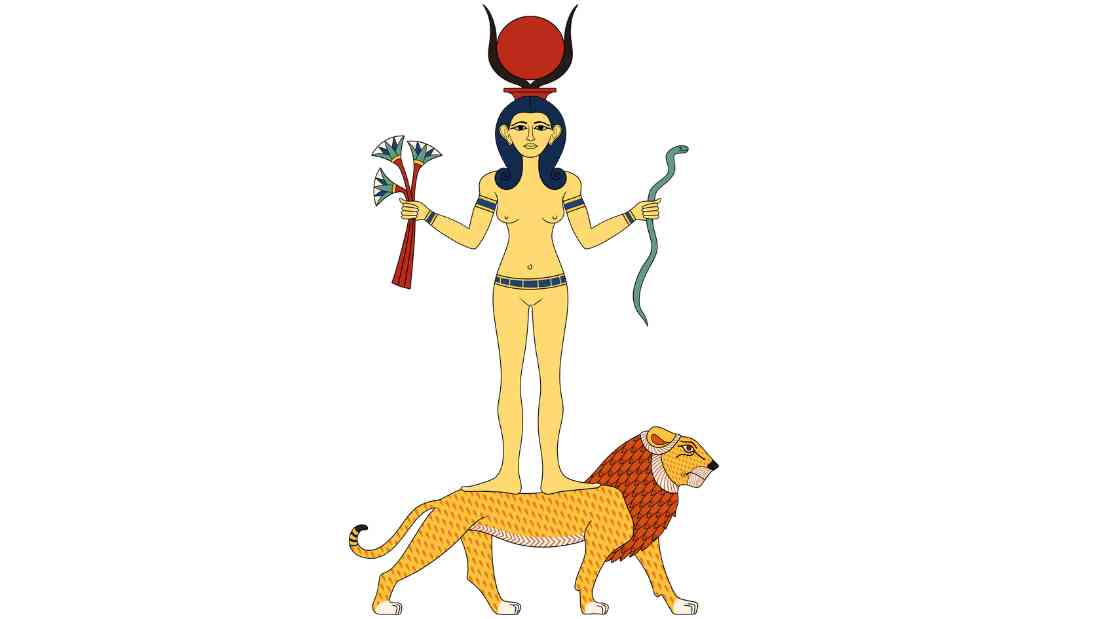
The story of Qudshu highlights how ancient societies interacted and influenced each other through religion. Her journey from Syria to Egypt exemplifies the cultural interconnections in the ancient Near East, showing how gods and goddesses could cross borders, bringing their power and influence with them.
As the consort of Reshep, the war god, Qudshu brought a unique blend of love, pleasure, and ecstatic experience to the ancient Egyptian pantheon of gods. Her qualities complemented and contrasted those of her consort, illustrating the balance of opposing forces that was a recurring theme in ancient mythologies.
Notably, Qudshu was not a standalone figure in the Egyptian religious landscape. She was associated with several significant goddesses, including Hathor, Anat, and Astarte.
Hathor, an indigenous Egyptian goddess, was revered for her roles in love, beauty, music, and motherhood. Anat, like Qudshu, was a foreign goddess who was adopted into the Egyptian pantheon, while Astarte was a powerful goddess of fertility, sexuality, and war.
These associations highlight the fluidity and adaptability of divine identities in ancient Egyptian religion. They also underscore the multifaceted nature of divine femininity, encompassing aspects of love, pleasure, fertility, and even war.
Reshep – The Syrian War God
Reshep is a compelling figure in the ancient Near Eastern and Egyptian mythologies.
Originating from Syria as a war god, his influence extended to the land of the Nile during the New Kingdom period (1570-1069 BCE) of ancient Egypt. He was then incorporated into the ancient Egyptian pantheon of gods, representing war and embodying power, courage, and conflict.
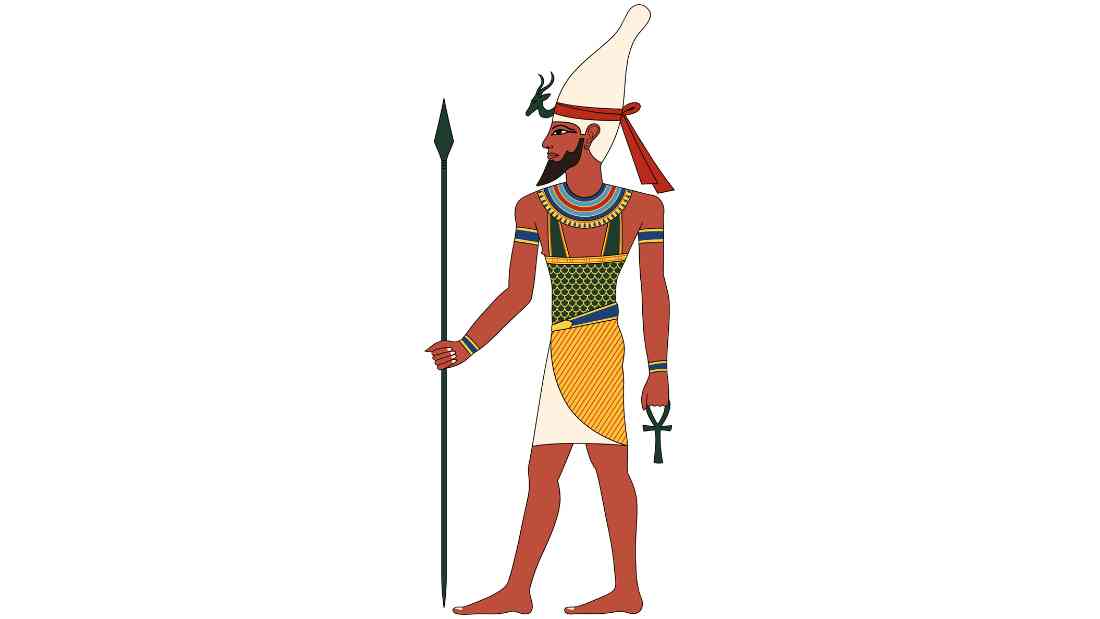
Reshep was not worshipped in isolation. He was the consort of the goddess Qudshu, also known as Qadesh, a deity of love, sexual pleasure, and sacred ecstasy.
Their divine partnership balanced the forces of war and love, reflecting the interconnectedness of these seemingly opposing aspects of life.
Furthermore, Reshep and Qudshu were worshipped with the fertility god Min, forming a triad of deities.
This arrangement further enriched their worship, combining the domains of war, love, pleasure, and fertility.
The inclusion of Min, a god associated with procreation and sexual potency, underscores the link between these various aspects of existence.
Min – The God of Fertility
Min is one of the oldest deities in ancient Egyptian pantheon of gods, with origins tracing back to the Predynastic Period (c. 6000-3150 BCE). As a god of fertility, Min held a crucial role in the Egyptians’ understanding of life, growth, and reproduction.
Min’s iconography is unique and symbolically rich. He is typically shown as a man holding his erect penis in one hand, symbolizing his role as a fertility god. In his other hand, he holds the flail of authority, a symbol of his divine power and status.
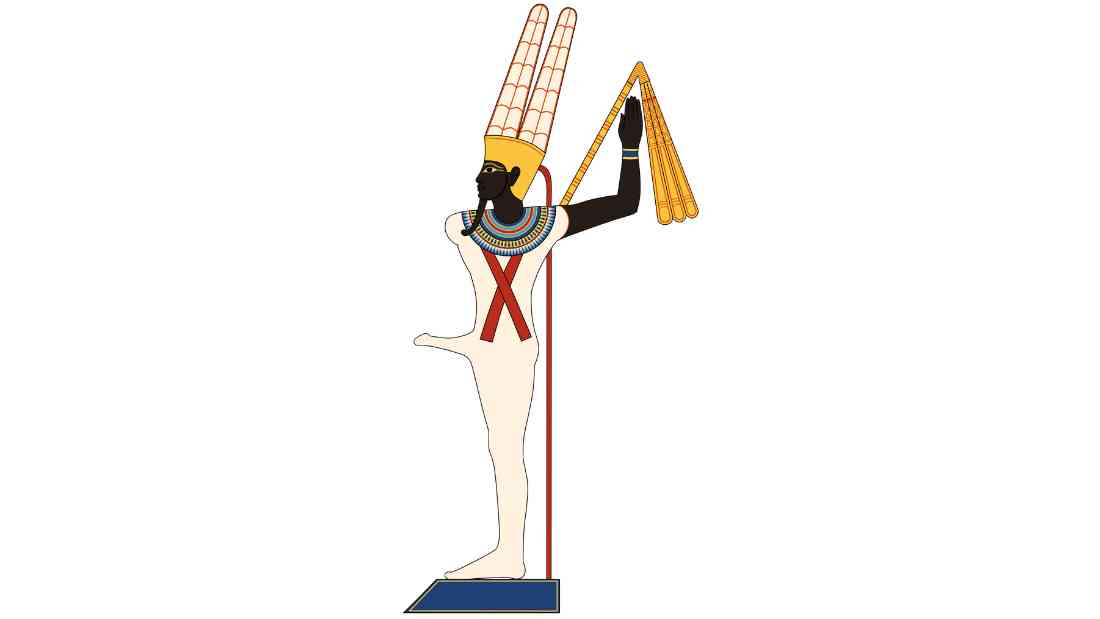
The god was linked to the black fertile mud of the Egyptian Delta, the source of the country’s agricultural abundance. This connection further emphasizes his role as a fertility god, embodying the life-giving power of the Nile’s annual flood.
In addition to his role in fertility, Min was also known as the god of the eastern deserts. In this capacity, he served as a protector of travelers venturing through these harsh, barren landscapes.
Ba’al – The Storm God from Phoenicia
Ba’al, a name that translates to “Lord,” is a significant figure originating from the pantheon of the ancient Phoenicians.
While the worship of Ba’al was originally rooted in Phoenicia and Canaan, his influence gradually permeated other regions. It was during the latter period of Egypt’s New Kingdom (1570-1069 BCE) that Ba’a, despite his foreign origins, was assimilated into the Egytian pantheon of gods and received veneration in various parts of Egypt.
Known as the storm god, Ba’al symbolized the mighty forces of nature, particularly those associated with thunder and rain. He was revered for his influence on weather patterns, crucial to the agricultural societies prevalent during this era.
As a result, the deity was often depicted with symbols like the thunderbolt, underscoring his authority over the elements.
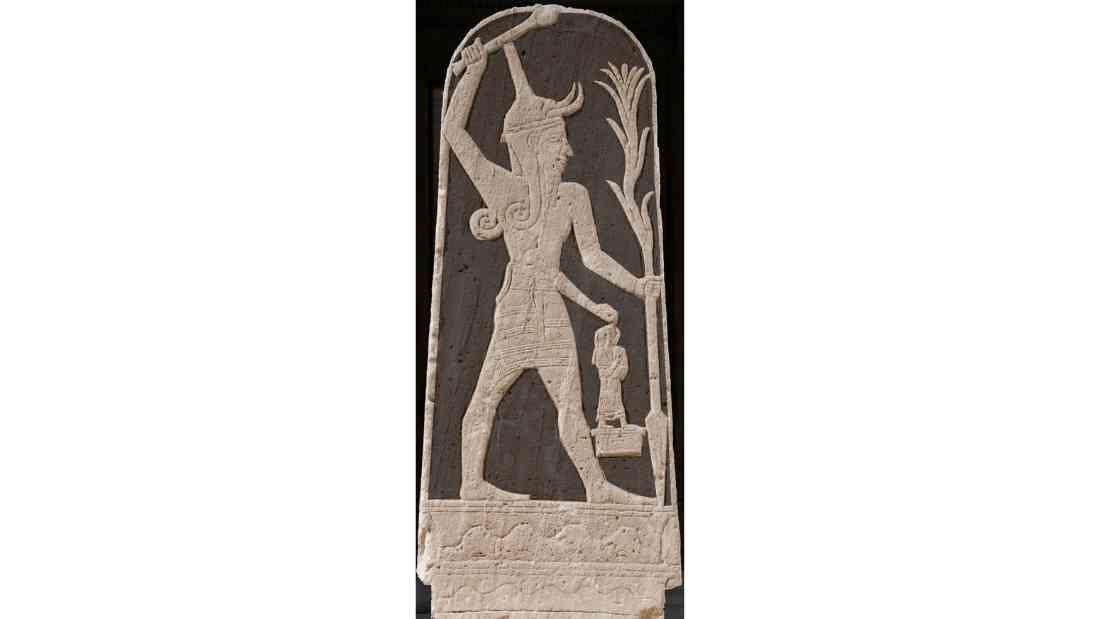
However Ba’al’s role extended beyond mere weather control. He was also considered a fertility deity, responsible for crop growth and abundance. Tales of his epic battles with Yam, the chaotic sea monster, were common in Canaanite mythology, and these narratives painted Ba’al as a champion of order against chaos.
Babi – The Baboon God of Virility
Babi, whose name means “Bull of the Baboons” was a god of virility, typically depicted as an aggressive male baboon.
Baboons hold a special place in ancient Egyptian culture due to their perceived intelligence and social behavior. They were observed to be highly sexual animals, which likely contributed to Babi’s association with virility.
Furthermore, baboons were considered the attendants of Thoth, the god of wisdom, which explains their revered status within the pantheon.
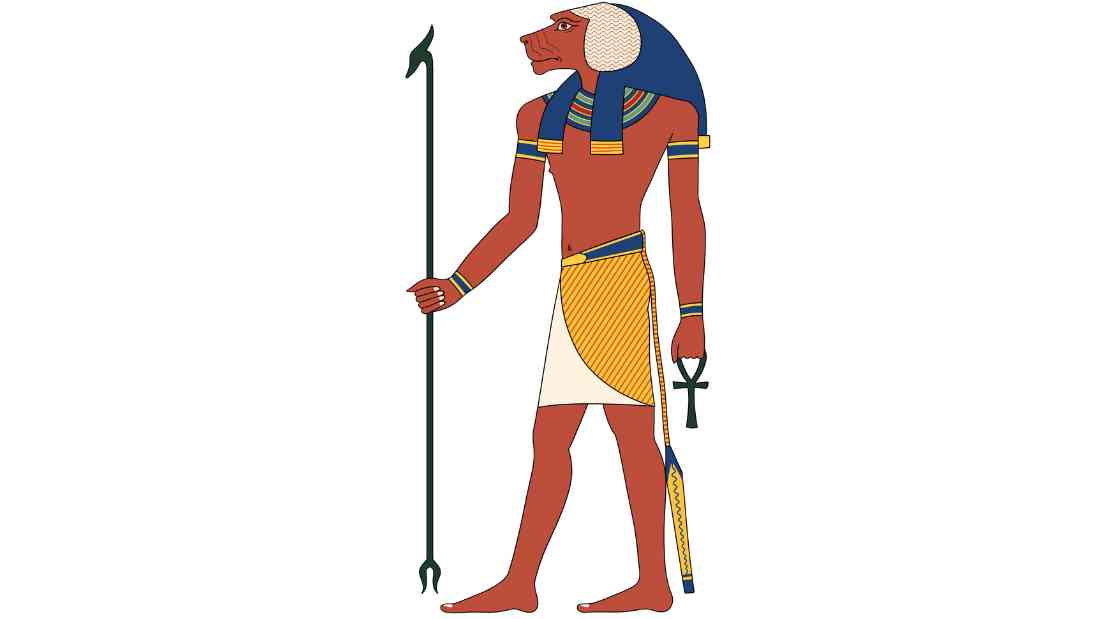
Despite Babi not having a primary role amongst the ancient Egyptian gods, he was unique for his aggressive and potent characteristics. He was often portrayed with an erect phallus, symbolizing virility and sexual power.
In addition to his sexual prowess, Babi was also recognized for his ferocious attributes. His aggression was such that he was said to live off entrails, reflecting his raw and untamed nature.
In the Book of the Dead, a collection of funerary texts, Babi is invoked by the deceased to use his virile power to ward off potential dangers in the afterlife. The deceased would often seek Babi’s assistance to ensure a safe journey through the underworld, demonstrating the protective qualities attributed to this deity.
Moreover, Babi’s image was used in amulets and talismans, providing protective and fertility benefits to the wearer. These artifacts further underline the dual aspects of Babi’s nature – his aggressive, protective side, and his role as a god of virility.
Ba-Pef – The God of Terror
Ba-Pef, an ancient Egyptian deity whose name translates to “that soul,” is a unique figure in the pantheon due to his association with spiritual terror. Unlike other ancient gods in the Egyptian pantheon, who were worshipped for their protective or beneficial attributes, Ba-Pef was feared for his ability to instill terror, particularly in the spiritual realm.
Ba-Pef resided in the House of Woe in the afterlife, a location that further underscored his terrifying persona. He was known to afflict the king of Egypt with spirital terror, a significant problem given the king’s divine status and crucial role in maintaining Ma’at, the cosmic order.
Despite his fearsome characteristics, Ba-Pef did not have a dedicated temple for worship. This lack of a physical place of worship is unusual compared to other deities in the Egyptian pantheon but speaks to the unique nature of Ba-Pef’s reverence. Instead of traditional worship, a Cult of Ba-Pef existed with the specific purpose of appeasing this god of terror.
The Cult of Ba-Pef played a crucial role in protecting the king by performing rituals and ceremonies designed to placify Ba-Pef, thus safeguarding the monarch’s well-being and the stability of the kingdom.
Bes – The Dwarf God of Childbirth, Fertility, and War
Bes, also known as Aha or Bisu, was revered for his influence over childbirth, fertility, sexuality, humor, and war. Unique among the pantheon of ancient Egyptian gods, Bes is often referred to as the Dwarf God due to his distinct physical depiction.
Unlike most Egyptian deities who are usually represented in profile, Bes is typically depicted full-faced, often sticking out his tongue and with his body covered in lion or leopard skin.
This unusual iconography, combined with his dwarf stature, gives Bes a distinctive and instantly recognizable appearance.
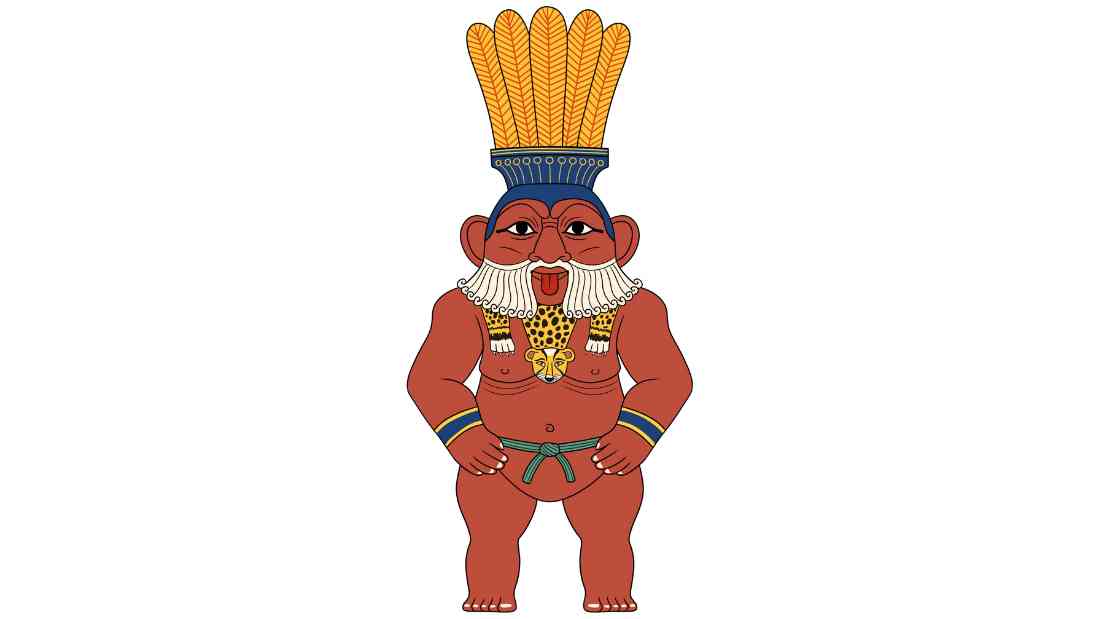
Bes was believed to protect women during childbirth, a critical function given the high mortality rates associated with birth in ancient times.
Images of Bes were commonly found in homes, particularly in the bedrooms of women, to ward off evil spirits and ensure safe childbirth.
However, Bes’s association with fertility and sexuality extended beyond childbirth. He was also revered as a symbol of sexual potency and was often invoked in love spells and fertility rites.
This aspect of Bes contributed to his popularity among ordinary Egyptians, who saw him as a protector of the family and home.
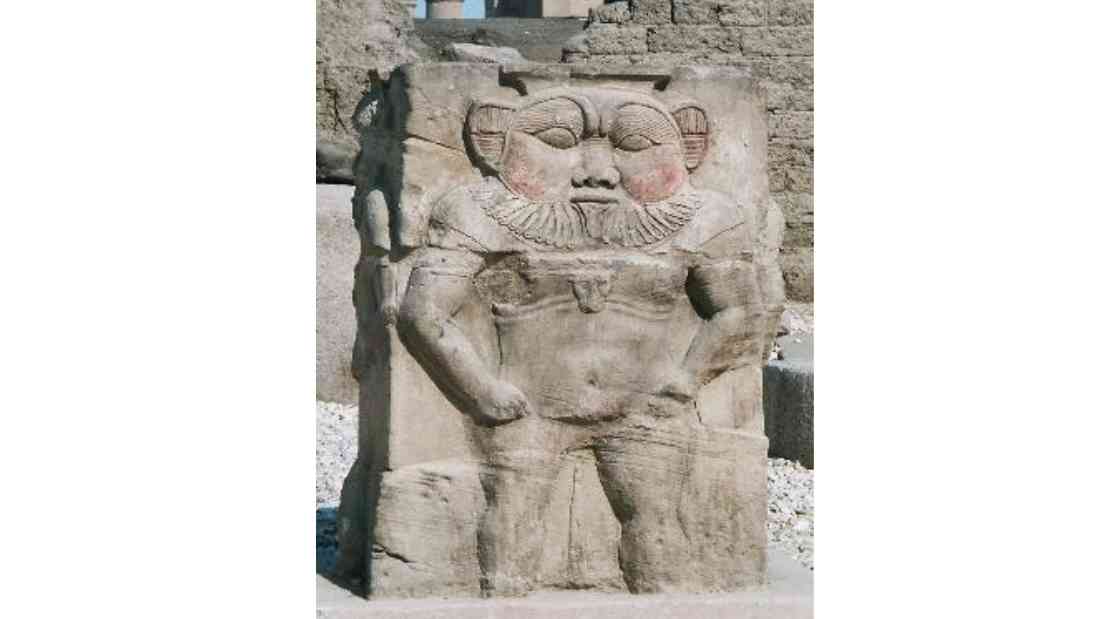
Despite his generally benevolent nature, Bes also had a fierce side.
As a god of war, he was believed to instill fear in the hearts of Egypt’s enemies.
His humorous demeanor was thought to be a mechanism to cheer up the troops before battle, making him a beloved figure among soldiers.
In addition to these roles, Bes was also associated with music, dance, and joy. He was often depicted playing a tambourine or harp, emphasizing his role as a god of mirth and celebration.
Beset – The Female Counterpart of Bes
Beset, in the pantheon of ancient Egyptian gods, is the female counterpart of the dwarf god Bes. Like Bes, she was a household deity and was often invoked for protection and to ward off evil.

In iconography, Beset is typically depicted similarly to Bes. She is shown as a dwarf, full-faced, and often sticking out her tongue. However, unlike Bes, she is usually portrayed as wearing a tight-fitting dress and sometimes a headdress, emphasizing her femininity.
As the female counterpart of Bes, Beset shared many of his protective functions.
She was considered a guardian of pregnant women and young children, providing them with protection from malevolent forces. Her image was often placed in homes, particularly in bedrooms, to ensure the safety and well-being of the household members.
Geb – The Earth God
Geb was known as the personification of the Earth and the ruler of the physical realm.
He was a vital member of the Heliopolitan Ennead, a group of nine gods believed to have been created by the deity Atum, or Ra. This divine group was primarily worshipped in Heliopolis, an ancient religious center in Egypt.
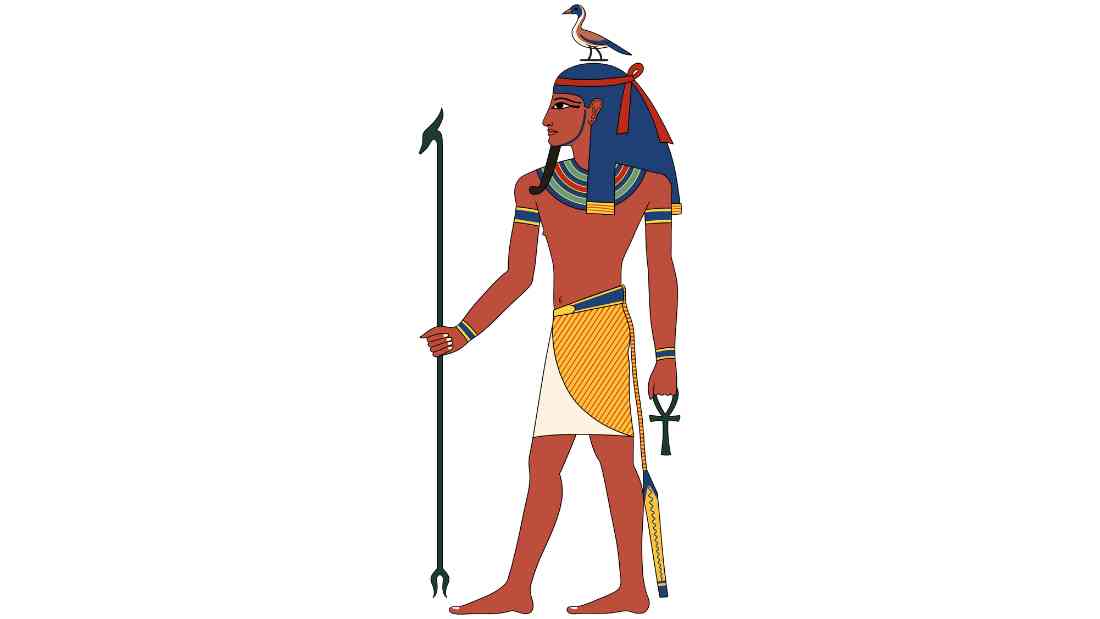
In this divine ensemble, Geb is recognized as the son of Tefnut, representing moisture, and Shu, symbolizing emptiness. His wife is Nut, the goddess of the sky or the visible daytime and nocturnal firmament. Together, they represent the union of earth and sky, a fundamental concept in Egyptian cosmology.
Geb’s iconography often depicts him as a man lying on the ground, his body covered in green vegetation or fertile soil, signifying his dominion over the Earth. Occasionally, he is portrayed with a goose on his head, a reference to the ancient Egyptian language where “Geb” also means “goose.”
As the Earth god, Geb was believed to cause earthquakes, which were interpreted as his laughter in the lore of Egyptian mythology. His role extended beyond mere physical phenomena; he was also seen as the judge of human souls after death, weighing their hearts against the feather of Ma’at, the goddess of truth and justice.
Geb’s association with the Earth also linked him to agriculture and fertility. As the embodiment of Earth, he was inherently connected to the fertility of the soil, making him a crucial deity for farming and harvest. This role positioned Geb as a provider, supplying the Egyptians with essential resources for survival.
The depiction of Geb and his wife Nut, in a tight embrace, symbolizes the union of earth and sky. However, they were separated by their father, Shu, creating the space in which the world exists.

Nut – The Goddess of the Sky
Nut was the goddess of the sky or visible daytime and nightly firmament.
She is the daughter of Tefnut, the goddess of moisture, and Shu, the god symbolizing emptiness. She is also the wife of Geb, the Earth god, and their union represents the interconnectedness of the earth and the sky in Egyptian cosmology.

In ancient Egyptian iconography, Nut is often depicted as a woman arching over the earth, her body adorned with stars, signifying her role as the sky goddess.
In some representations, she is shown swallowing the setting sun, which would then travel through her body at night and be reborn at dawn, highlighting the cycle of day and night.
As the sky goddess, Nut is associated with the heavenly bodies, particularly the sun and the moon. She is considered the barrier separating the forces of chaos from the ordered cosmos in the world. Her body becomes a protective shield over the Earth, blocking the chaotic waters of Nun.

Beyond her celestial duties, Nut also plays a crucial role in the afterlife. Ancient Egyptians believed that Nut would draw the spirits of the dead into her star-filled sky, offering them protection and refreshment. This belief made her an essential figure in funerary rites and mortuary texts.
Furthermore, Nut is often associated with the sycamore tree, believed to be the tree of life and death. She was thought to provide nourishment to deceased spirits from the tree.
Kek – The God of Darkness
Kek, also known as Kuk or Keku, is the egyptian god of darkness, obscurity, and chaos.
He is one of the members of the Ogdoad, a group of eight deities worshipped primarily in Hermopolis, an ancient religious center in Egypt.
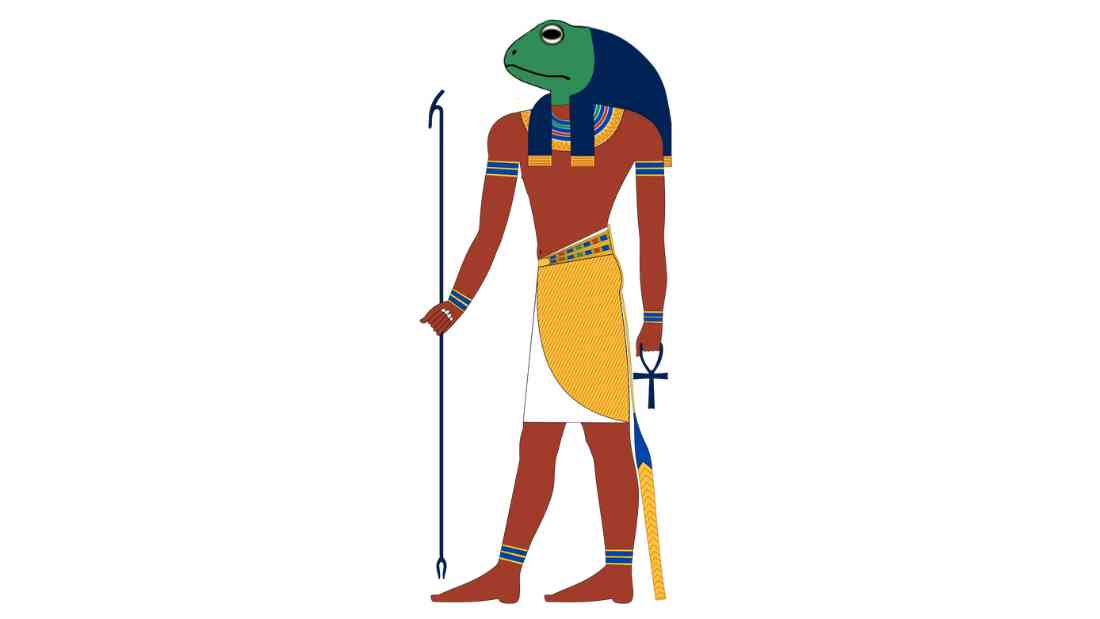
In the cosmology of the Ogdoad, Kek represents the primordial concept of darkness. This darkness existed before the world was created and is associated with the chaos that lies outside of the cosmos.
Kek, as a deity, personifies this darkness and the unknown.
Kek is often depicted as a man with the head of a frog or as a full frog, while his female counterpart, Keket, is portrayed with the head of a snake or as a full snake.
These representations are connected to the creatures’ habits of appearing and disappearing, symbolizing the phenomena of dawn and dusk, respectively.
As the god of darkness, Kek is also linked to the time before the dawn, thus being known as the ‘Bringer-in of the Light,’ a reference to his role in bringing about the day. Thus the god of darkness has a paradoxical nature, embodying both light and dark, chaos and order.
Despite his association with darkness and chaos, Kek was not viewed negatively by the ancient Egyptians. Instead, he represented necessary aspects of reality that existed before the ordered world and would continue to exist beyond it. His existence was seen as part of the natural balance of the universe.

Dendera_Deckenrelief_02.JPG: Olaf Tauschderivative work: JMCC1 (talk)photographe/égyptologue, CC BY 3.0, via Wikimedia Commons
Keket – The Goddess of Darkness
Keket, also known as Kauket or Kekut, is the female counterpart of Kek. She too is part of the Ogdoad, the group of eight gods and goddesses worshiped primarily in Hermopolis.
In the cosmological framework of the Ogdoad, Keket represents the primordial concept of darkness that existed before the creation of the world. She embodies the chaotic void that lies outside the cosmos, personifying the unknown and the unformed.
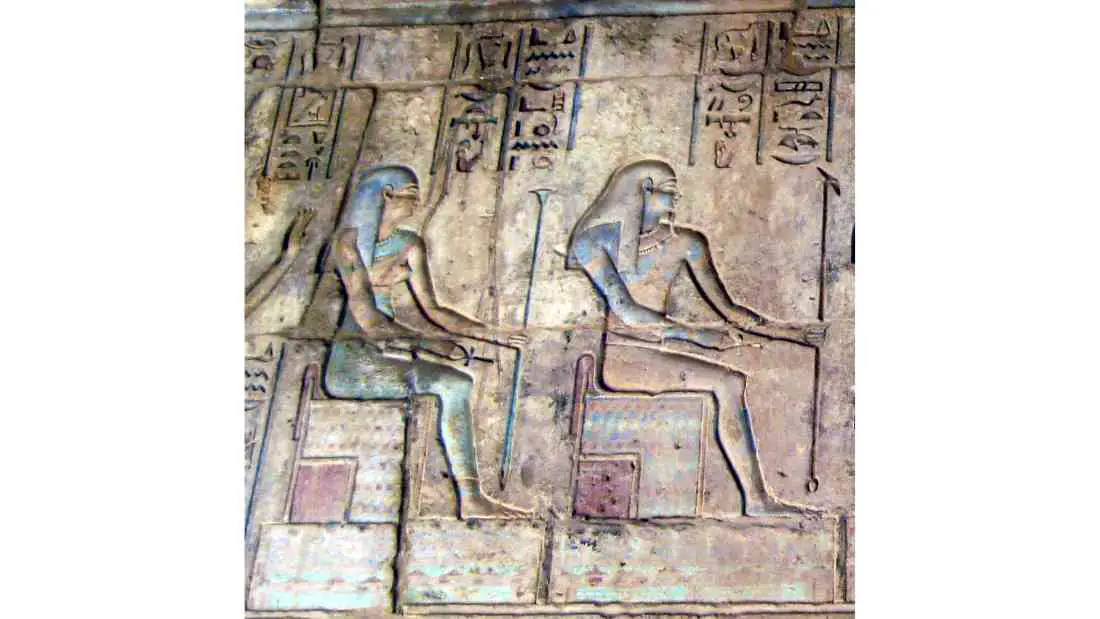
Keket is often depicted as a woman with the head of a snake or as a full snake. This representation is tied to the creature’s habits of appearing and disappearing, symbolizing the phenomena of nightfall and the retreat of light.
Meanwhile, her male counterpart, Kek, is portrayed with the head of a frog or as a full frog, representing the dawn or the return of light.
Like Kek, Keket is also associated with the night and the time after the sunset, embodying the retreat of light and the onset of darkness.
Nun – The God of the Primordial Waters
Nun is another one of the ancient Egyptian deities that make up the Hermopolitan Ogdoad, a group of eight gods worshipped primarily in Hermopolis during the Old Kingdom period.
The Ogdoad consisted of four male-female pairs, representing different aspects of the primordial world.
Nun and his female counterpart, Naunet, represented the primordial waters.
Often referred to as the “Father of the Gods,” Nun was considered the oldest and wisest of the deities. He was believed to predate the creation of the world and the other gods.
In this sense, Nun is often associated with the concept of chaos, embodying the disordered state of existence before the world was formed.

Jeff Dahl, CC BY-SA 4.0, via Wikimedia Commons
One of the most significant aspects of Nun’s mythology is his role in the creation story.
One particular version of this cosmogony places Nun, the god of primordial waters, at the forefront of creation.
According to this account, before existence as we know it, there was only Nun and Naunet, an infinite expanse of dark and chaotic waters.
From these primordial waters emerged the first land, known as the benben. This mound is of great significance in the Egyptian creation myth as it represents the first solid matter to appear in an endless sea of chaos.
Upon the benben settled Atum, the first god. Atum, whose name means “Complete” or “Perfection,” is often associated with the concepts of totality and completion. He is considered the first being and the originator of the divine and earthly realms.
The act of Atum settling on the benben symbolizes the moment when order (Ma’at) was first established out of chaos. This event marked the beginning of time and the start of all life.
From Atum came the rest of the gods, humans, and all living creatures, marking the genesis of the ordered world from the chaotic waters of Nun.
This narrative underscores the importance of Nun in the creation story.
Though he embodies chaos, it is from his waters that the first spark of creation, the benben, emerges. This duality mirrors the ancient Egyptian understanding of the universe as a balance between order and chaos.
Another important myth associated with Nun involves the sun god Ra.
At the beginning of time, it is said that Nun lifted the barque, a type of boat, carrying Ra into the sky. This act of lifting the barque set in motion the cycle of day and night, essentially marking the start of creation.
This mythological event is significant for several reasons. Firstly, it highlights Nun’s role as the catalyst for the creation of the universe.
By lifting Ra’s barque into the sky, Nun facilitated the separation of earth and sky, a key moment in the creation story of many ancient cultures.
Secondly, it underscores the interconnectedness of the deities in the Egyptian pantheon.
Despite representing the chaos of pre-creation, Nun plays a crucial role in the orderly functioning of the world by setting Ra on his daily journey across the sky.
Lastly, this myth illustrates the ancient Egyptians’ understanding of natural phenomena.
The daily journey of the sun across the sky was a fundamental aspect of their worldview. By attributing this occurrence to the actions of Nun and Ra, they personified these natural processes, integrating them into their religious and cultural identity.
Despite these important roles in ancient Egyptian mythology, there were no temples dedicated solely to Nun.
However, he was acknowledged and revered in various religious texts and rituals, reflecting the Egyptians’ deep respect for the forces he represented – the primeval waters, chaos, and the genesis of life.
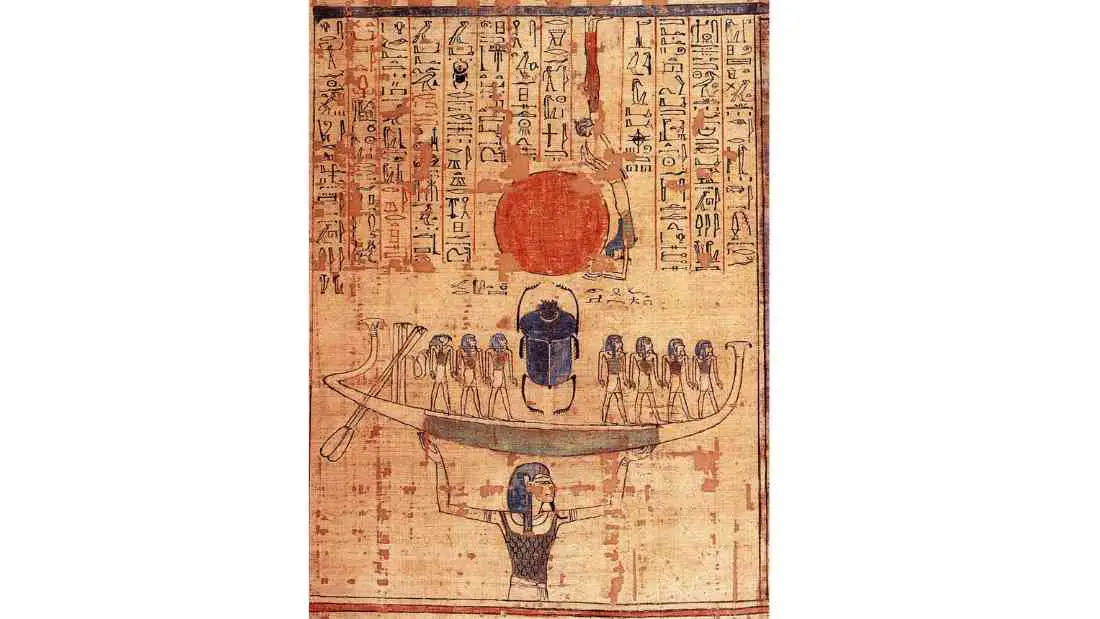
Public domain, via Wikimedia Commons
Naunet – The Goddess of the Primordial Waters
Naunet is the female counterpart of Nun in ancient Egyptian mythology, and like him, she was revered as part of the Hermopolitan Ogdoad, a group of eight deities that represented the chaos before the creation of the world.
Just like Nun, Naunet symbolized the primordial waters, but in their feminine aspect.
In ancient Egyptian culture, the concept of duality was integral to the understanding of the universe. It was believed that every aspect of existence had a male and a female component, both necessary for balance and harmony.
In this context, Naunet complemented Nun, together embodying the infinite expanse of chaotic waters that existed before the creation of the cosmos.
Naunet is often depicted as a snake or a woman with a snake’s head, highlighting the association with the undulating, formless nature of the primeval waters.
In other instances, she is shown as a woman carrying a bark (boat), just like Nun, emphasizing her role in the journey of the sun god Ra through the underworld.
Despite being a representation of the pre-creation chaos, Naunet also had protective qualities. She was considered a guardian deity of the underworld, playing a significant role in guiding and protecting the spirits of the deceased.
Heh – The God of Infinity
Heh was revered as the god of infinity or eternity in ancient Egyptian mythology.
As part of the Ogdoad, a group of eight primordial deities, Heh and his female counterpart Hauhet are the ancient Egyptian gods associated with the infinite and limitless aspect of the primordial waters.
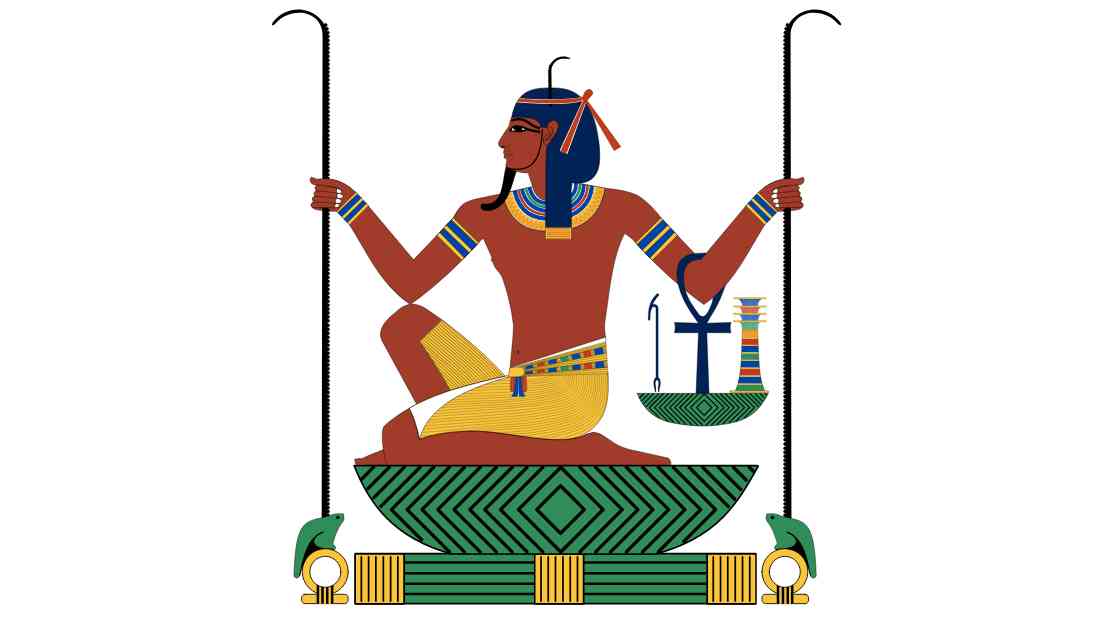
The name Heh translates to “endlessness” or “infinity”, reflecting his role as the embodiment of immeasurable time and space.
This concept is fundamental to the understanding of the creation myth in Hermopolitan cosmogony, where the universe was believed to have emerged from the chaotic waters of Nun.
Heh is often depicted as a man holding in each hand a palm rib, a hieroglyphic sign for “year”, thus symbolizing an infinite number of years.
In some representations, he is shown with his arms raised and holding the sky, signifying his role in holding up the heavens and thus maintaining the order of the universe.
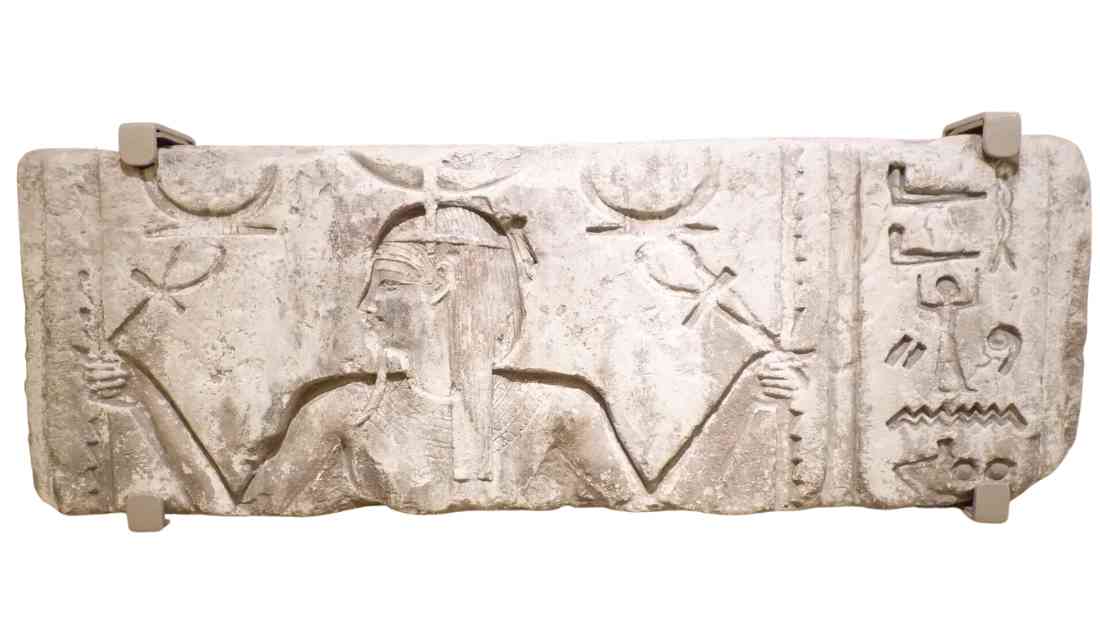
Khruner, CC BY-SA 3.0, via Wikimedia Commons
Hauhet – The Goddess of Infinity
Hauhet, an ancient Egyptian deity, is one of the eight primordial gods that form the Hermopolitan Ogdoad. Alongside her male counterpart Heh, Hauhet symbolizes infinity, but with a specific focus on the limitless aspect of space.
The name Hauhet translates to “boundlessness” or “limitlessness,” reflecting her role as the embodiment of infinite space.
This concept is central to the Hermopolitan cosmogony, where the universe is believed to have emerged from the chaotic and boundless waters of Nun.
Hauhet is typically depicted as a woman with the head of a snake or entirely as a snake. This representation aligns with the other female deities of the Ogdoad, who are also portrayed as serpentine beings.
The snake symbolism, associated with renewal and cyclical time due to its shedding skin, might be interpreted as a nod towards Hauhet’s association with the limitless nature of existence.

HID-IIY at English Wikipedia, CC BY-SA 3.0, via Wikimedia Commons
Despite her seemingly abstract domain, Hauhet played a significant role in ancient Egyptian cosmology. Her embodiment of infinite space complemented Heh’s representation of infinite time, together forming the spatial-temporal framework within which the cosmos exists.
It is within this boundless space and time that the process of creation unfolds, making Hauhet and Heh fundamental to the creation myth.
Ihy – The God of Music and Joy
Ihy is the ancient Egyptian god of music and joy, and his worship was often associated with jubilant celebrations and musical performances.
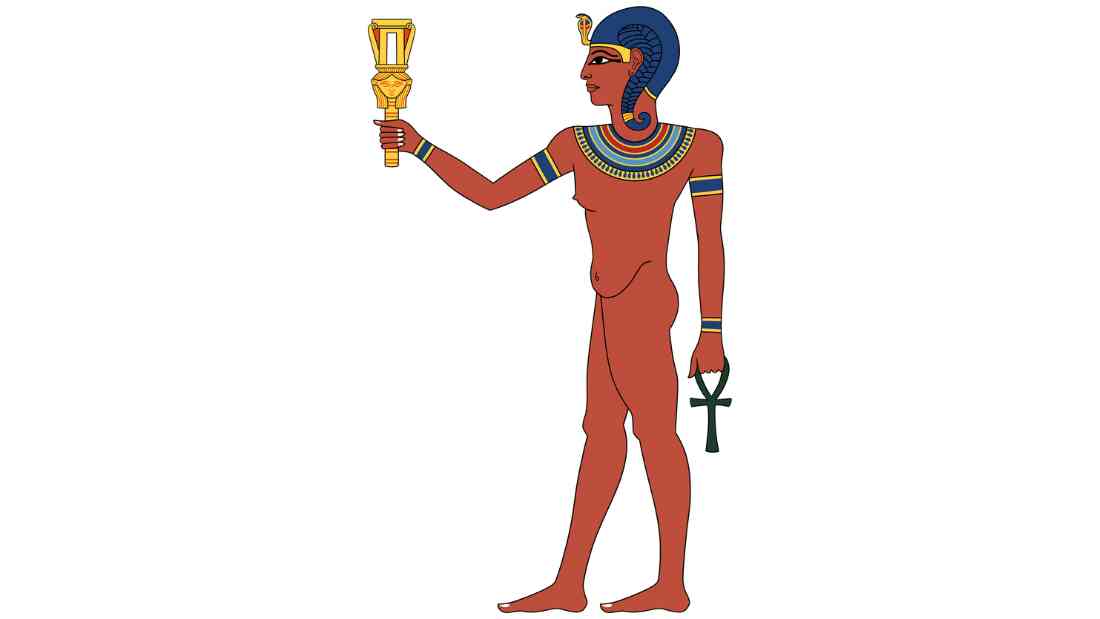
In Ancient Egyptian mythology, Ihy is often depicted as a child with the sidelock of youth, a traditional hairstyle worn by Egyptian children.
Sometimes, he is shown holding a sistrum, an ancient musical instrument that resembles a rattle. This iconic representation underscores Ihy’s association with music and dance.

Ihy was the son of Hathor, the goddess of love, beauty, and music, and Horus, the god of the sky. His parents’ identities further reinforce his connection to joy and celebration, as both Hathor and Horus hold positive and uplifting associations in Egyptian mythology.
As the god of music, Ihy played a crucial role in religious ceremonies and festivities. Musicians would invoke his name to seek his blessings for their performances.
In addition, his name would often be called upon during festivals to ensure an atmosphere of joy and celebration.
Temples dedicated to Hathor, such as the one at Dendera, also served as important centers for the worship of Ihy. Here, rituals and ceremonies would be conducted in his honor, often involving music and dance to celebrate his joyful spirit.
Within the temple complex you will find the mammisi, or “birth house”, dedicated to Ihy. This is a fascinating architectural and religious feature symbolizing the divine birthplace of Ihy, and plays a crucial role in his worship.
Upon entering the mammisi, visitors are greeted by an array of intricate carvings and reliefs adorning the walls. These depictions illustrate the divine birth and childhood of Ihy, emphasizing his association with music and joy.
In some scenes, Hathor is shown nursing a young Ihy, while in others, Ihy is depicted playing his sistrum, a traditional musical instrument.
The mammisi served as the epicenter for rituals and ceremonies dedicated to Ihy. Accompanied by music and dance, these ceremonies were a celebration of Ihy’s joyful spirit.
Musicians would play traditional instruments, invoking the god’s blessings, while dancers performed routines to honor Ihy and commemorate his divine birth.
During annual festivals, a procession would carry the statue of Hathor from the main temple to the mammisi, reenacting the birthing process and symbolically renewing the divine cycle of life. This grand event was a jubilant celebration filled with music, dance, and merriment, encapsulating the essence of Ihy’s worship.
Today, the mammisi at Dendera stands as an enduring symbol of Ihy’s legacy and the ancient Egyptians’ deep reverence for music and joy.
Concluding Thoughts on the Pantheon of Ancient Egyptian Gods and Goddesses
The pantheon of ancient Egyptian gods and goddesses, with their complex symbolism and multifaceted roles, were integral to the spiritual, cultural, and societal fabric of one of history’s most remarkable civilizations.
Each one of the ancient Egyptian gods, from Hathor, the goddess of love, beauty, and music, to Ptah, the god of craftsmen and creation, played a pivotal role in shaping the religious beliefs, moral values, and artistic expression of the ancient Egyptians.
These gods weren’t mere characters in a mythical narrative. They were embodiments of natural phenomena, moral principles, and human emotions. Their stories were not just tales of divine exploits, but profound metaphors that helped the ancient Egyptians make sense of the world around them, and their place within it.
Moreover, the influence of these ancient Egyptian gods extended beyond mortal life, guiding the perceptions of death and the afterlife of the people who worshipped them. They offered comfort, protection, and guidance, reassuring Egyptians that they would have a safe journey in the afterlife.
Even today, millennia after the fall of the last Pharaoh, these gods continue to captivate us. They are not only fascinating figures of myth and legend, but they also offer invaluable insights into the spiritual landscape of ancient Egypt. They help us understand how this civilization viewed life, death, the universe, and the human experience.
This is why the pantheon of ancient Egyptian gods and goddesses is a testament to the profound spirituality, rich culture, and remarkable ingenuity of a civilization that continues to inspire awe and wonder in the modern world.

Frequently Asked Questions About The Ancient Egyptian Gods
Some of the most well-known ancient Egyptian gods include Ra (the sun god), Isis (the goddess of motherhood and magic), Osiris (the god of the underworld and judge of the dead), Anubis (the god of embalming and the dead), and Horus (the sky god).
Ancient Egyptians practiced polytheism, meaning they believed in and worshipped multiple gods. Each one of the ancient Egyptian gods had specific domains or aspects of life they were responsible for.
Worship practices included offerings, prayers, and rituals performed both in public temples and in private homes. Festivals were also common and provided a way for Egyptians to honor their gods.
Yes, there were a few exceptional individuals, such as Amunhotep, son of Hapu, Hardedef, and Imhotep, who were deified and became a part of the pantheon of ancient Egyptian gods due to their significant contributions to society and their exceptional wisdom.
For Further Reading
Large Stockpile of Embalming Equipment discovered in Abusir
Mummification: Why did the Ancient Egyptians embalm their dead?
Saba Mahmood – a strong voice in the anthropology of religion and post-colonialism
Unravelling the Mysteries of Ancient Egyptian Symbols of Death – Anthropology Review
The Wrath of Montu – The Mythology of the Egyptian War God
Exploring the Egyptian Middle Kingdom – A Historical Overview
Examining the Rich Hues of Ancient Egyptian Paint
Ancient Egyptian Temples: Spiritual Centers of the Nile Civilization
The Symbolism and Significance of Ancient Egyptian Jewelry
The Pantheon of Ancient Egyptian Gods – A Comprehensive Guide
Temple of Seti I: An Architectural Marvel in the Ancient City of Abydos

